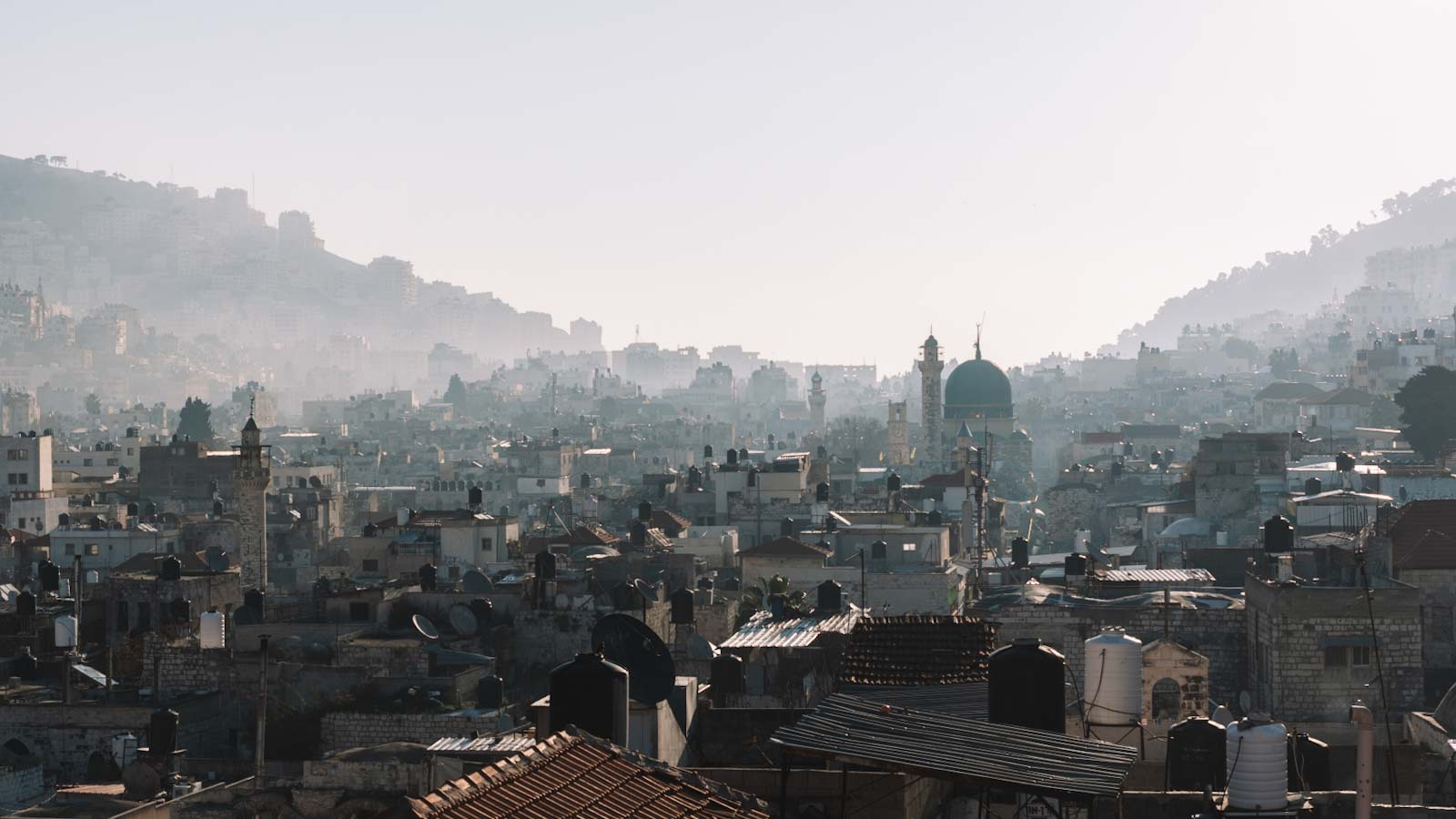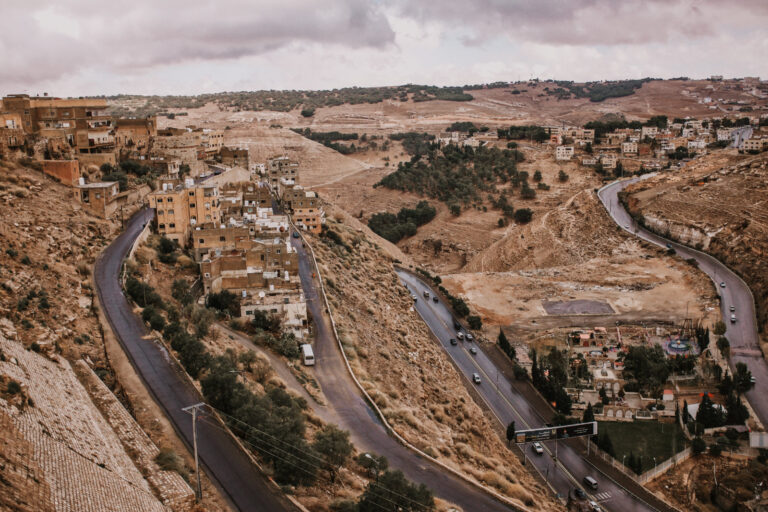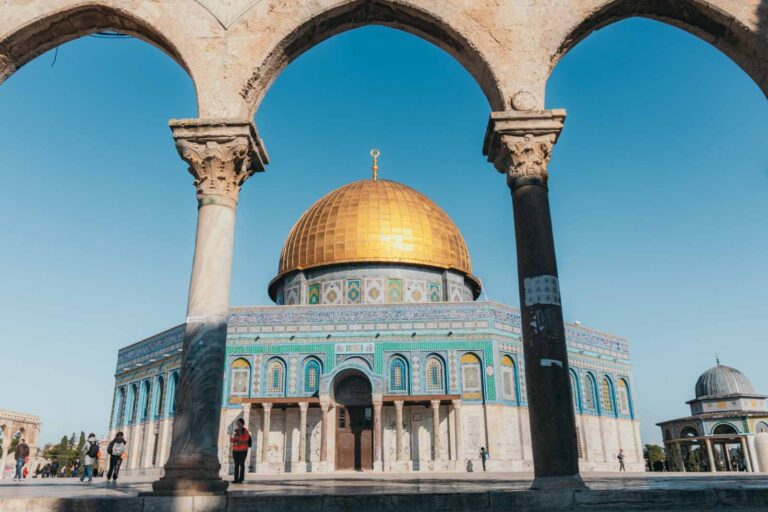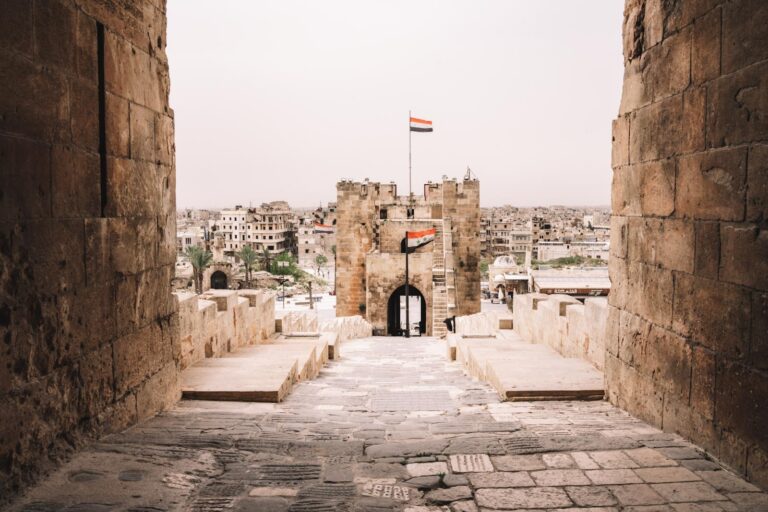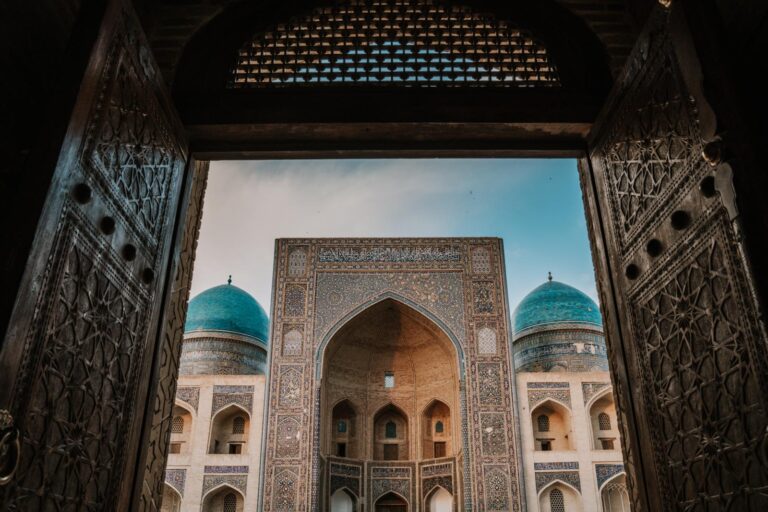This ultimate travel guide to Palestine (West Bank) is everything you need to know for an independent trip to the most interesting places in Palestine. Read our 11 days Palestine itinerary with detailed descriptions of transportation, including the exact shared taxi locations, prices, where to stay, including refugee camps, how to cross the checkpoints, safety in Palestine and many other valuable tips.
I wrote this post to include everything you need to know before you travel to Palestine with confidence and knowledge of what to expect. Consider this as your best travel guide to Palestine.
We always wanted to visit Palestine but were hesitant to go through Israel with a passport full of stamps from other Middle Eastern countries. However, after travelling through Egypt and wondering where to go next, we decided to cross the Taba border from Egypt to Israel and continue to Palestine.
Since, at that time, we were travelling more than a year in a row, we couldn’t swap our passports. We had to use the ones with stamps from Lebanon, Syria, Iraq and other interesting countries, and that’s why we ended up being detained and questioned at the Taba border by Israeli officers for 5 hours. However, since you’re reading this Palestine travel guide, it is clear we successfully made it, so now it’s time to show you that Palestine is a land worth visiting.
WARNING! October 2023: The ongoing war between Israel and the Gaza Strip is currently taking place, and before you travel to the West Bank, it is necessary to seek the most updated information. The conflict does not hit West Bank, but high tension is expected.
WHY VISIT PALESTINE
Where there is a conflict, there might be hope and soon a solution. However, this is not the case in the long-lasting Israeli-Palestine conflict. To understand better the situation in Palestine, you need to get off the trail. You need to stay with people in refugee camps. Listen to their stories. Have coffee with strangers and talk. Listen. Only after that we realised how hopeless the situation in the occupied land of Palestine is. It is an emotionally draining, eye-opening journey that we recommend you embark on.
We rate visiting Palestine high on our list of favourite countries, as it left a big impact on our hearts. And apart from the bad things happening there, Palestine deserves attention because of its rich history, delicious cousin, breathtaking monasteries and because of the people who are amongst the most hospitable people on earth.
We recommend you check our stories on our Instagram Brokennavigation_ where we documented our journey through Palestine in detail.
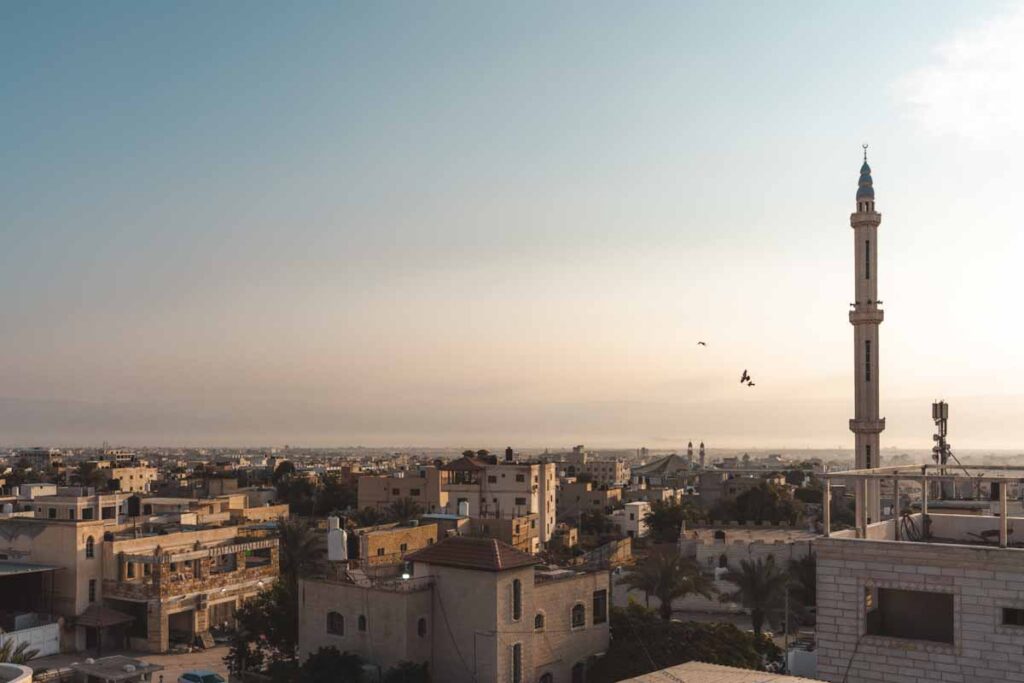
PRACTICAL INFORMATION
- Religion: Palestine is a Muslim country with a majority of Sunni Muslims. As in other countries of the Middle East, people are very welcoming and hospitable. They really want to talk about life in Palestine and are very happy to meet foreigners and invite you for tea. Even though I just said that the majority of people in Palestine are Sunni Muslims, Christianity here plays a significant role. Especially in Bethlehem and also in Ramallah and Jericho. Would you expect to find a local brewery here?
- Language: official language in Palestine is Arabic. We found it very pleasant to travel around Palestine as most people we met spoke at least basic English; therefore, it was very easy to communicate.
- Currency: The currency in Palestine is the Israeli Shekel. 1$ = 3.58 ILS.
- Visa: You don’t need a visa to visit Palestine; however, you must show your passport and the Israeli immigration slip you got once you entered Israel.
Interested in the Middle East? Read our guides from Syria, Iraq, Lebanon and more.
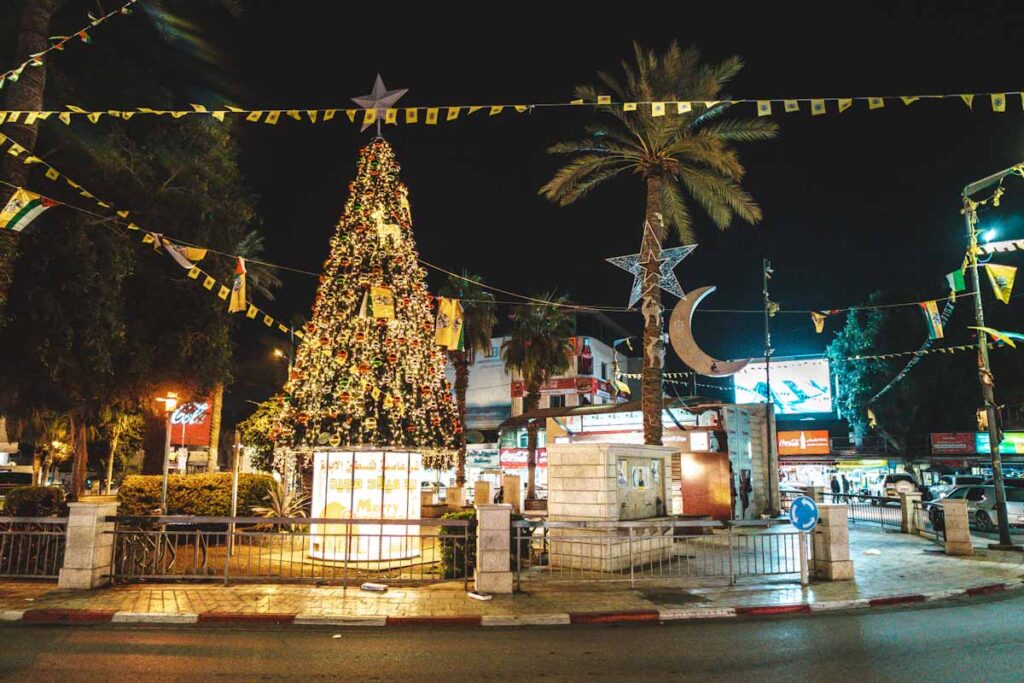
SAFETY AND SITUATION IN PALESTINE
Israel has occupied Palestine since 1967, and the situation is only getting worse with Israel building more and more Jewish settlements in Palestinian territory. Basically, Palestinians have no way to fight back because as soon as they try, the Israeli army attacks back with much more power. Does this fact affect your travel? Yes and no. Yes, because the land is very sensitive, and riots are happening on a daily basis, especially if you decide to stay in a refugee camp with local families. All the army attacks on Palestinian people occur at night and early in the morning. Therefore, try to avoid being outside at that time.
During our time in Palestine, we were informed by local people that there is daily shooting in refugee camps and dangerous situations for Palestinians happening. We personally did not see anything dangerous, and we did not go out at night & very early morning. We felt very safe and welcomed.
Palestine territory is divided into the West Bank and Gaza Strip. Gaza Strip is absolutely off-limits to tourists; therefore, all travel guides we wrote about Palestine refer solely to the West Bank territory.
Essential reading: Is it safe to visit Palestine? Our experience. (Coming soon)
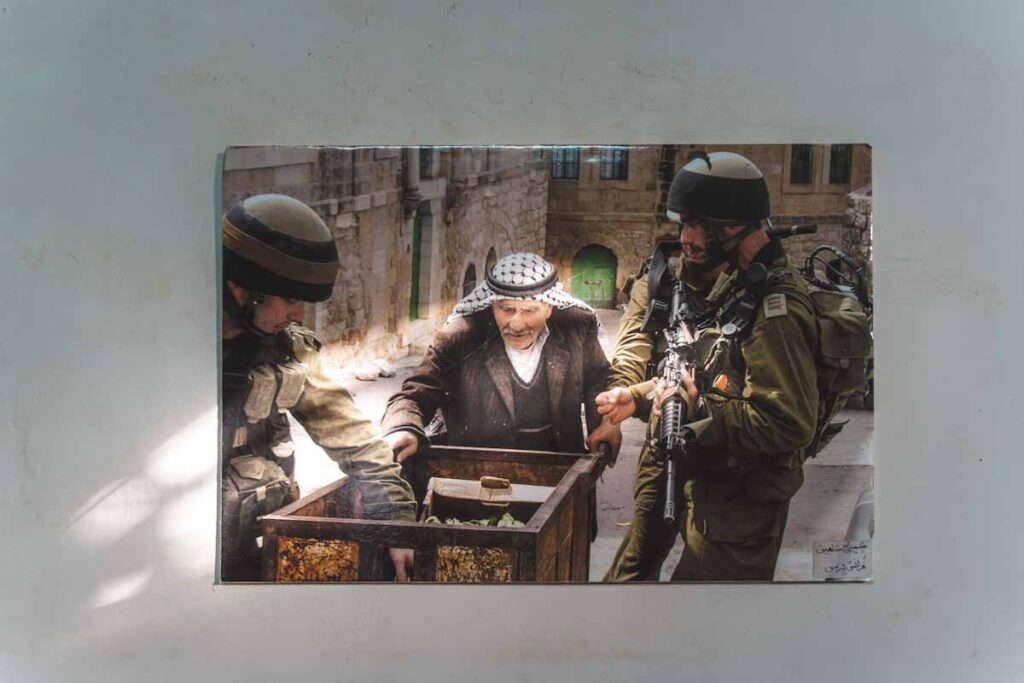
WATER
Israel also limits the water supply for Palestine since the reservoir is on Israeli territory. They open the water for Palestinians only two days per month. That’s why you will see many water tanks on the rooftops of houses. Because they have to collect rainwater and in those two days when they have the water they collect as much as possible.
Electricity & Internet works well everywhere we have been in Palestine. Use VPN for accessibility to certain sites.
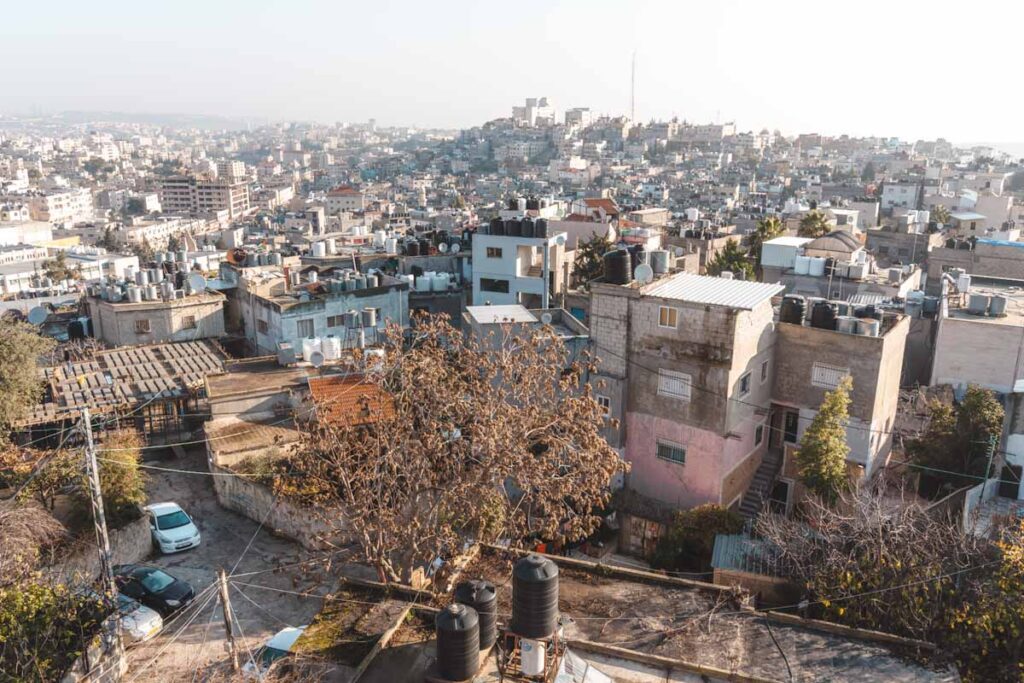
SNIPERS AT BUS STOPS
When travelling in Palestine, get used to seeing snipers behind the barriers, either made of sandbags or bulletproof glass. They are usually located close to where the Israeli settlers live, next to the bus stations. They point their huge gun directly at incoming cars. Sitting in a car and seeing the soldier pointing a gun at you is a super weird feeling. They are protecting the settlers from potential attacks from Palestinians. Notice the huge red signs close to the Jewish settlements that state: ,,This road leads to Area A Under the Palestinian Authority. The entrance for Israeli citizens is forbidden, dangerous to your lives and against Israeli law”. So even if Israelis would like to go and see Palestine themselves. They can not, as they are told it is dangerous for their lives.
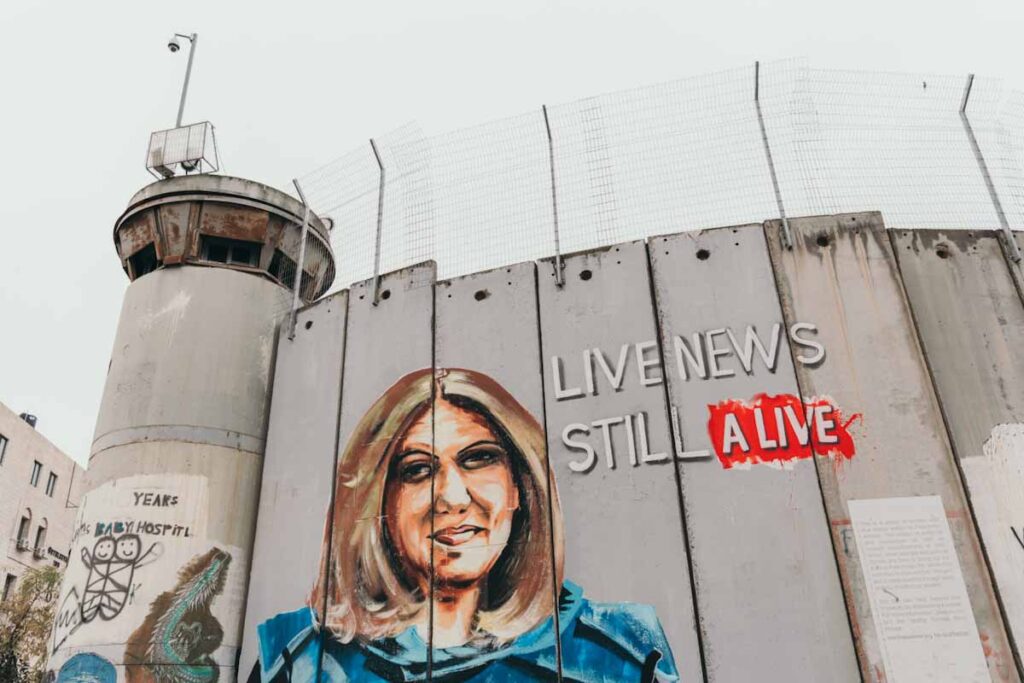
Travel Insurance for palestine
Have proper travel insurance for Palestine covering various activities such as IATI Insurance does. They have fantastic customer service and provide different kinds of insurance packages. As a reader of Broken Navigation, you get an exclusive 5% discount.

Get your exclusive 5% discount for your travel insurance with IATI here.
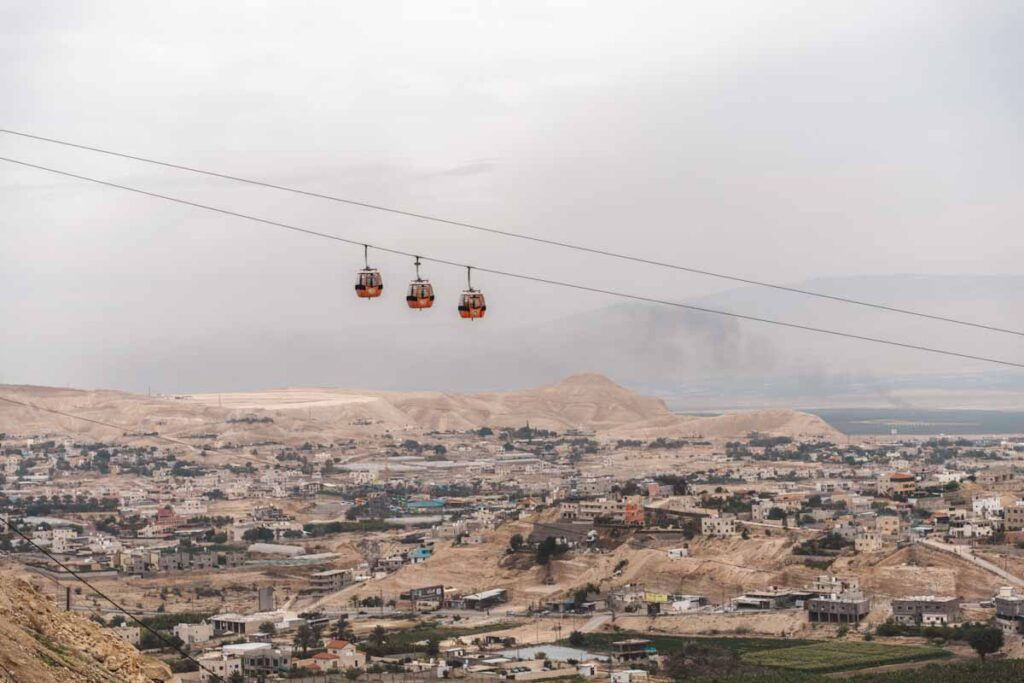
CHECKPOINTS
Going through checkpoints is very easy for foreigners. Basically, in most checkpoints between Israel and Palestine, when going in the direction of Palestine, you just freely walk through without any special check. If you want to go from Palestine to Israel, that’s a different story, though.
Overall, there are more than 100 checkpoints across Palestine and roadblocks to separate new roads, which only Israeli cars can use, from the old and not repaired roads only for Palestinian cars. You will also see the separation wall in Bethlehem, that most likely will leave you emotional with all the powerful graffiti on it. Palestinians say it is to segregate them from the rest of Israel and limit their free movement. Israel claims it is for the safety and preventing the terrorist attack. Come and see yourself. We travelled around Palestine independently to see with our own eyes what was happening. We talked with people to learn their points of view.
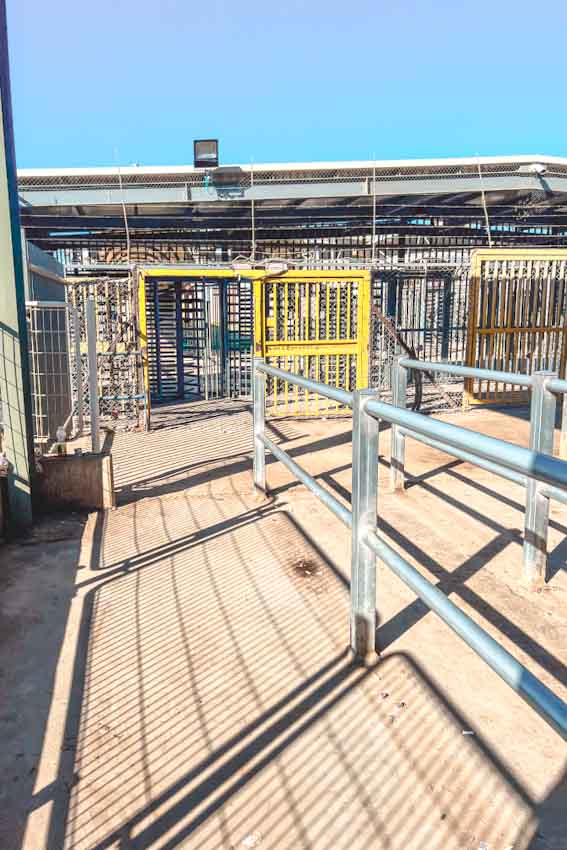
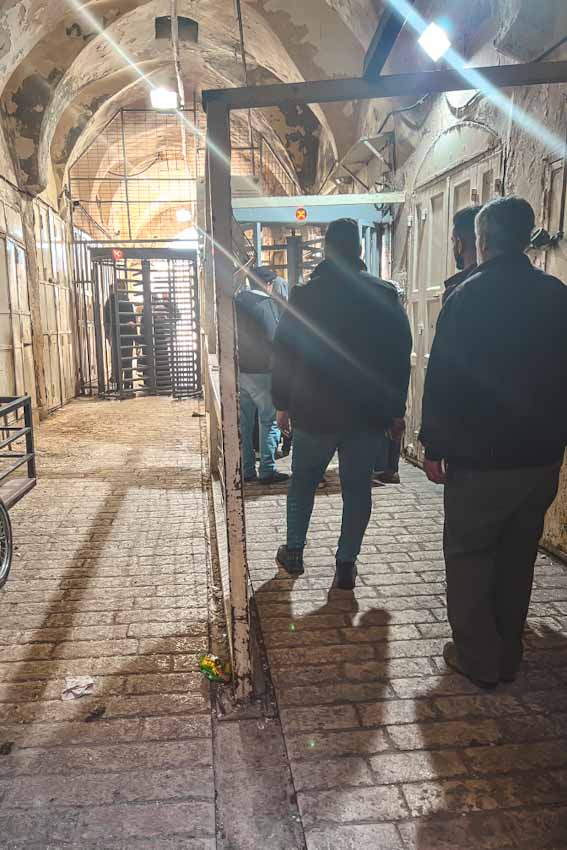
CHECKPOINT 300 – JERUSALEM TO BETHLEHEM
The first checkpoint we crossed was between Jerusalem into Bethlehem. Checkpoint 300. Located South of Jerusalem by the entrance to Rachel’s tomb. This checkpoint is used for Palestinians who are permitted to cross into Jerusalem. If going in the direction from Jerusalem to Bethlehem, it is very easy. You go through the concrete tunnel with multiple one-way gates. There are no officers to check anything as you are going into Palestine, and no one care. If you go in the opposite direction, then officers will check your documents. And for Palestinians, they check their permit. From what we heard, frequent harassment towards Palestinians is happening on these borders. They let them wait for hours.
After we got out into Palestine, there were many taxi drivers. Some of them immediately started chatting with us. Even though they are not used to many tourists coming independently through this checkpoint, they tried to rip us off by asking for crazy amounts of money. That surprised us a bit. Don’t get me wrong. Palestinians are lovely and hospitable people; however, but as elsewhere, be careful about the taxi drivers as they will try to rip you off in many places in Palestine. You don’t need a taxi if you want to explore the separation wall and reach The Walled Off Hotel. You can easily walk as it is an easy 800 m walk from Checkpoint 300. This checkpoint is open 24/7.
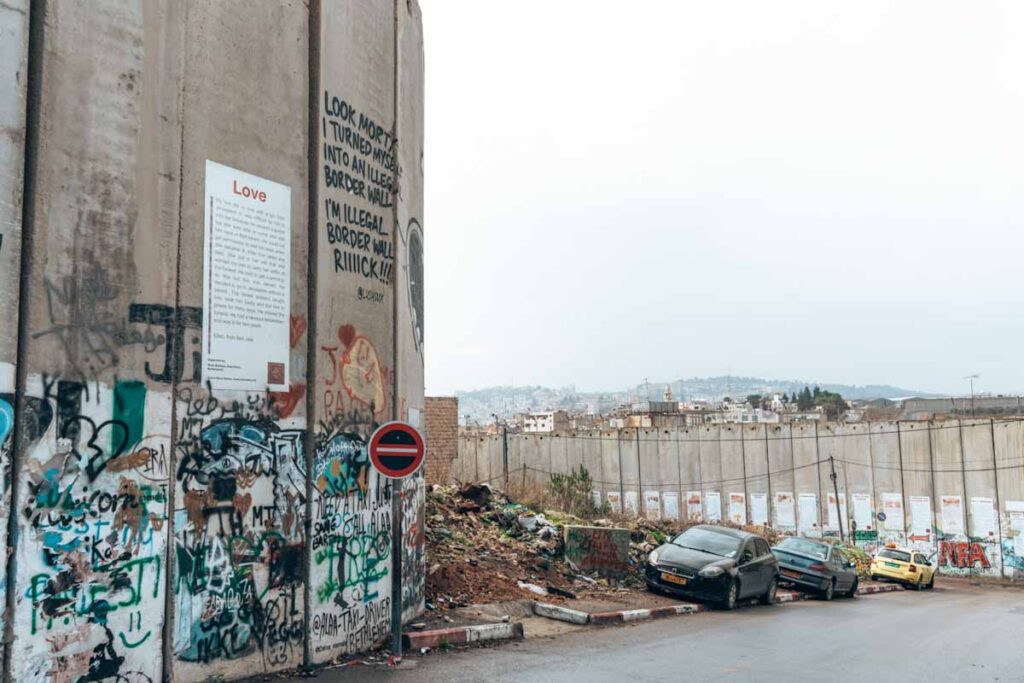
JALAMEK/EMEK HAROD CHECKPOINT – JENIN TO NAZARETH
Another checkpoint in Palestine we crossed was Jalamek Checkpoint from Jenin to Nazareth. We used this checkpoint on our last day in Palestine to cross into Israel (Nazareth). I have to say; the Jalamek checkpoint was the worst border crossing / Checkpoint we have ever experienced. The way Israeli officers act here is unthinkable. They are rude, humiliate people and make you feel like nothing. Here, the checkpoint is open only at certain times. We arrived here at 2pm, and it was closed. We and other Palestinians waited an hour, and at 3pm, they finally opened the gate. Be careful; it is open only for some time and then closed again. The best way to find out is to ask locals. We were told the checkpoint is open from 2pm, but as you see, they did not open till 3pm. Then the queue was already quite long; we were between the first ones who got through the gate. We recommend you have your bag carefully packed and prepared and have documents handy. As soon as the gate opens, people start rushing and pushing you from behind. Everything goes very fast and hectic. First, you have to send your luggage through the x-ray check, your jacket as well, belt etc. It is a similar procedure to the security check at the airport. We did not expect that. And there was very little space, people were rushing, and we had to pick up our bags quickly & forgot our bag with food there as it was super hectic. Then we continued through the designated path until we reached the officer in a stall behind bulletproof glass. From the second floor, there was an officer with a gun pointing at people. Super weird situation. They checked our passports and took them.
We were asked to go aside, and after a few minutes, the officer & armed guard came to question us. What we did in Jenin was their biggest concern. We said we did not go to Jenin but to Nablus. This was partially true as we slept in Nablus and Jenin we visited when we went through on the way to the border. Why do you go to Israel? What you’re going to do? We showed our itinerary for Israel, explained we were travellers, and they let us go through after a few minutes. Overall, this checkpoint with waiting for opening took 2 hours. Even though the experience here was awful, I recommend anyone to cross this border to see with their own eyes how the officers act towards others.
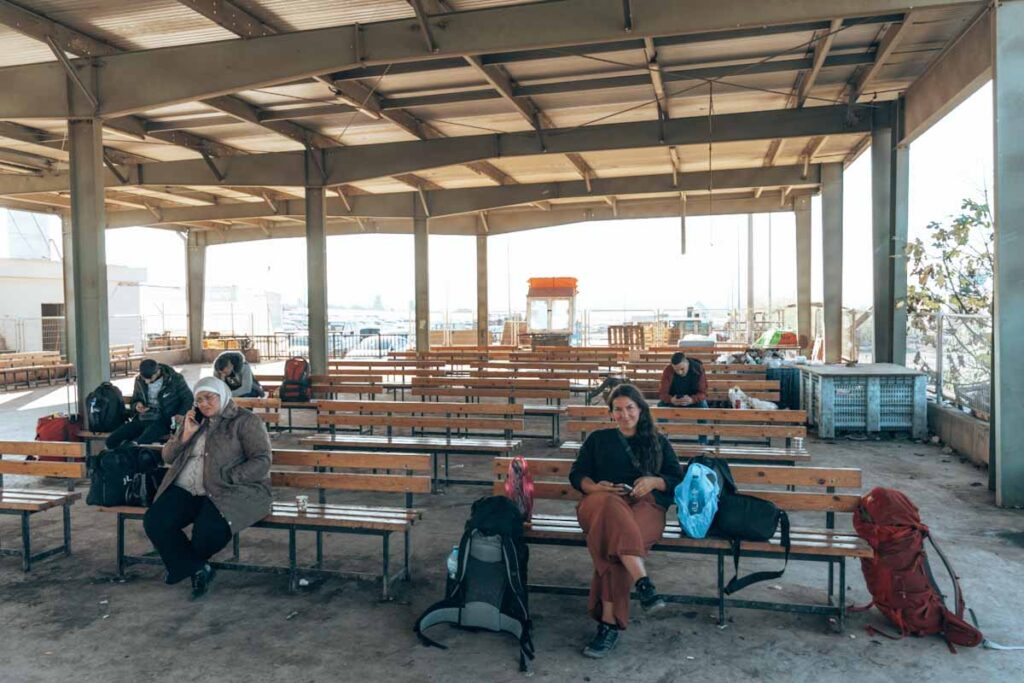
CHECKPOINTS IN HEBRON
When visiting Hebron, you will go through multiple checkpoints. Hebron is divided into two areas known as Area H1, which is under the control of Palestinians and Area H2, which is Israeli controlled area. Both crossings are in the Middle of the city. The tension between those two areas is huge as the checkpoints separate the Al-Ibrahimi Mosque (Holy site for Muslims) from the Cave of Patriarchs (holy site for Jews). One building. Two checkpoints.
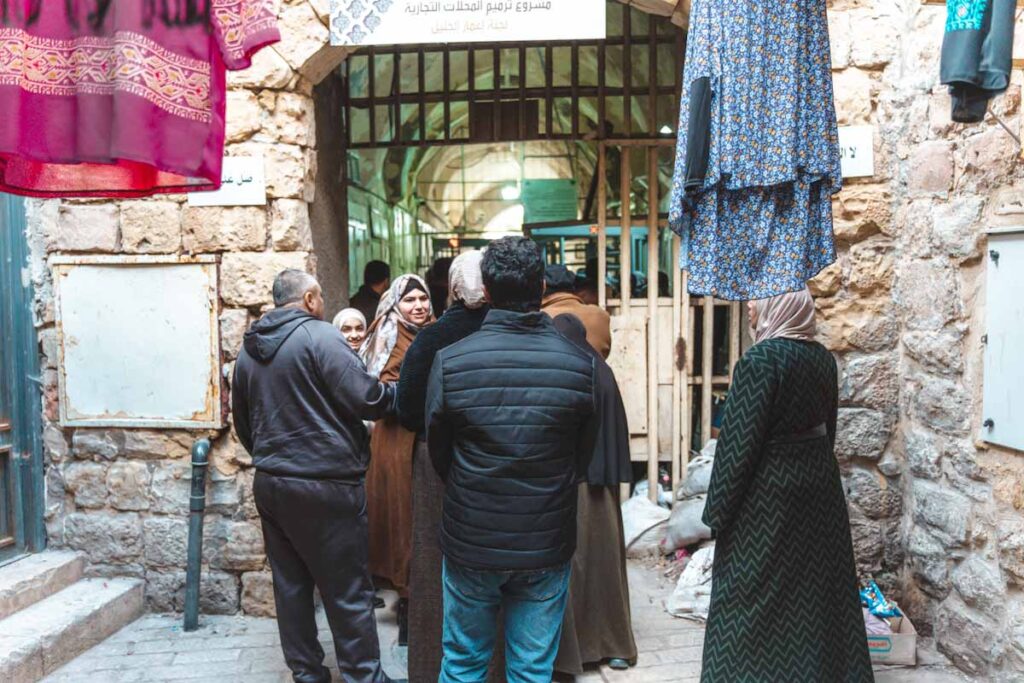
CHECKPOINT TO AL IBRAHIMI MOSQUE
Basically, to enter the Al Ibrahimi Mosque, you go through 2 checkpoints. In both of them, they ask where you are from, why you are here and if you have any weapon. The officers let people go through a one-way gate only one by one. So when the light is green, you can go. Otherwise, you wait in a queue.
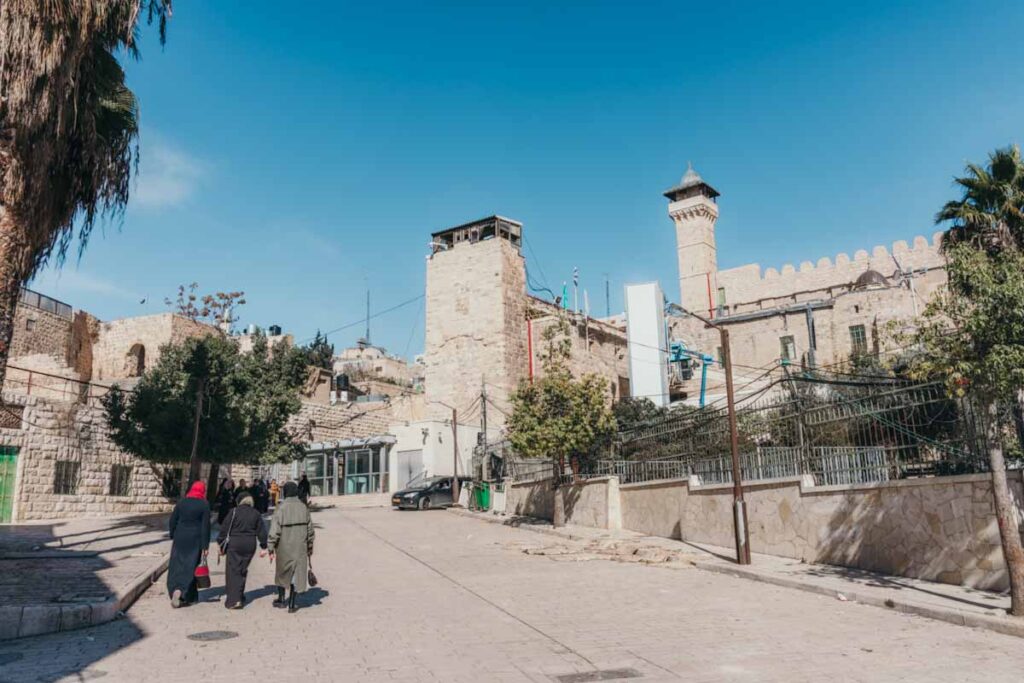
CHECKPOINT TO CAVE OF PATRIARCH
To enter the Cave of Patriarch, you return to the main street (in front of the first checkpoint you crossed) and make your way toward the checkpoint that leads into the Cave of Patriarchs. Here you have to answer the same questions, and you also will be asked about your religion. We said we are Christians. Entry for Muslims is forbidden here.
CHECKPOINTS IN H2 AREA – ISRAELI TERRITORY
After visiting the synagogue, we walked around the area H2, which is under Israeli control. It is basically a dead city with a huge military presence. No Palestinians can set foot on those streets. There were multiple barriers with soldiers who always stopped us, asking what we were doing there, where we were from and where we were going. They checked our passports, made a few phone calls – I guess to the soldiers on the other barrier and let us go. When we wanted to go and visit the archeological site up the hill, the Israeli soldiers told us that area was not safe for us to go alone and would not let us go through without an armed escort. We accepted. Otherwise, we would have to return to area H1, where we had a hotel. After visiting the site, we crossed another checkpoint that brought us back to the H1 area.
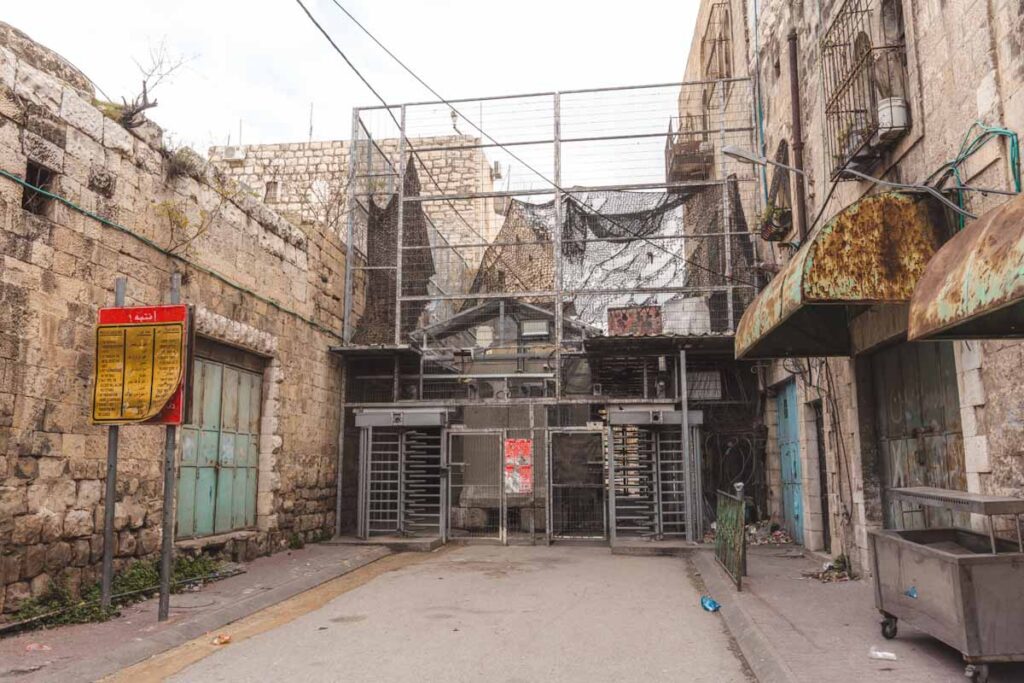
WHEN TO VISIT PALESTINE
When is the best time to visit Palestine? Avoid the summer in Palestine if possible, as the temperatures get way too hot. We visited Palestine in January, and it was a perfect time as we still managed to see a lot of Christmas decorations, and it was not too cold. In Jericho was the warmest weather from the whole trip.
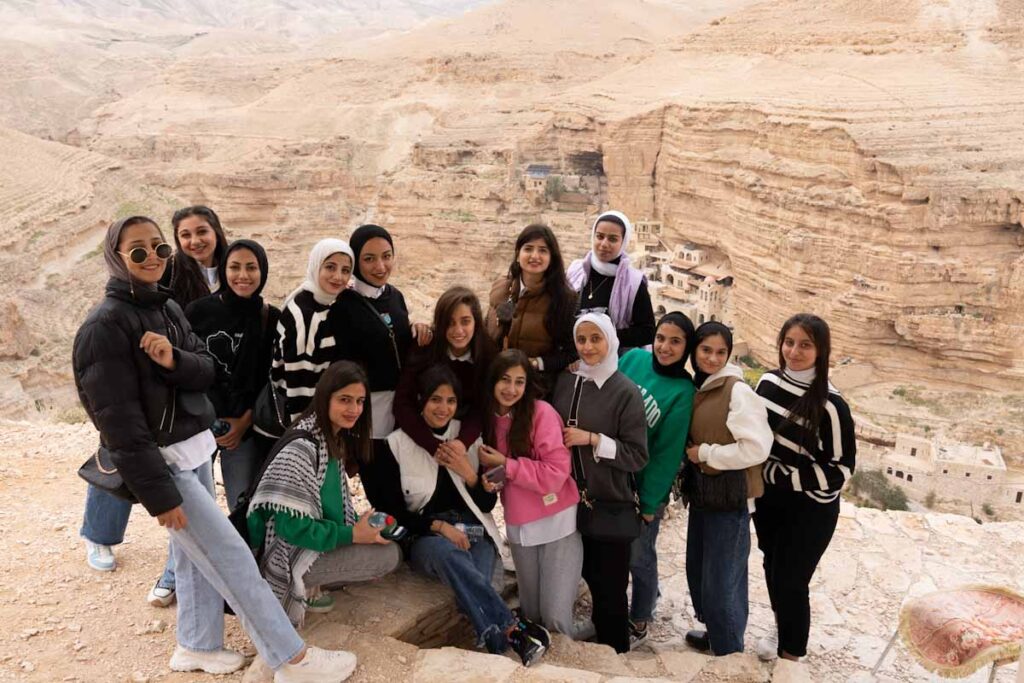
THE BEST TOURS TO PALESTINE
Independent travelling in Palestine is not a big thing. To be more precise, we barely met any travellers during our travels, and the first hint that Palestine’s destination is not among the most typical is the fact there only exist a few up-to-date travel guides.
In our eyes, it is very easy to get around independently, and obviously, that way, you experience a whole different point of view than if you take a tour. On the other hand, I understand that many people maybe don’t want to travel alone or want a guide to listen to their opinions on the situation. There are many tours you can take comfortably from Jerusalem. If that’s what interests you, base yourself in Abraham hostel in Jerusalem and check our top tour picks:
HOW TO GET TO PALESTINE
There is no international airport in Palestine; no matter what direction you’re coming from, you must go through Israel.
To get to Israel, you can cross overland borders from Jordan, or like we did from Egypt. However, the most common way to reach Israel is by flight and airports in Tel Aviv or Eilat have frequent flights from Europe with the low-cost airline Wizzair, and you can find flights for as little as $25.
Find cheap flights to Israel here.
Border Crossing Report: How to cross the Taba Border between Egypt and Israel.
HOW TO GET AROUND PALESTINE
Getting around Palestine is very easy as the shared taxi system works very well. Don’t bother using Google Maps, as it always shows you a non-sense, much longer way. Instead, use Maps.me app that shows the correct way. Travelling around Palestine by shared taxis or buses is easy, convenient and safe.
SHARED TAXIS & PRICES OF TRANSPORT
Here you can see the summary of buses & shared taxis we used in Palestine and how much they cost. Bear in mind, when travelling around Palestine, to start your day early as there is much more traffic going to places and also coming back from sights is much easier in the early afternoon rather than in the evening as there are lower chances of catching the shared taxi or you will wait a long time for them to fill up. Usually, the shared taxis run till 6pm, but make sure you ask drivers or locals before. In our experience, we woke up every day early and started exploring no later than 8-9am. We never had any problems with waiting for shared taxis to fill up. It usually took up to 10 minutes only.
- Jerusalem – Bethlehem: bus #234 to Checkpoint 300 5.5 ILS ($1.5)
- Bethlehem – Mar Saba: Shared taxi to Ubediya 5 ILS ($1.4)
- Shared taxi in Bethlehem: From the centre to Dheisha refugee camp 3 ILS ($0.8)
- Bethlehem – Hebron: Shared taxi from Dheisha refugee camp 10 ILS ($2.8)
- Hebron – Jericho: Direct shared taxi 30 ILS ($8.3) or Shared taxi to Al Azariyah 20 ILS ($5.6) and change to shared taxi to Jericho 10 ILS ($2.8)
- Shared taxis in Jericho: From the centre to Hisham Palace 10 ILS ($2.8) to Mount Temptation 20 ILS ($5.6), to St. George Monastery 15 ILS ($4.2)
- Jericho – Ramallah: Shared taxi 18 ILS ($5)
- Ramallah – Nablus: Shared taxi 17 ILS ($4.8)
- Nablus – Jenin: Shared taxi 16 ILS ($4.5)
- Jenin – Emek Harod Checkpoint / Jamaleh: Shared taxi 4 ILS ($1.1)
You can expect to spend a total of around 180 ILS ($50) for transportation in Palestine.
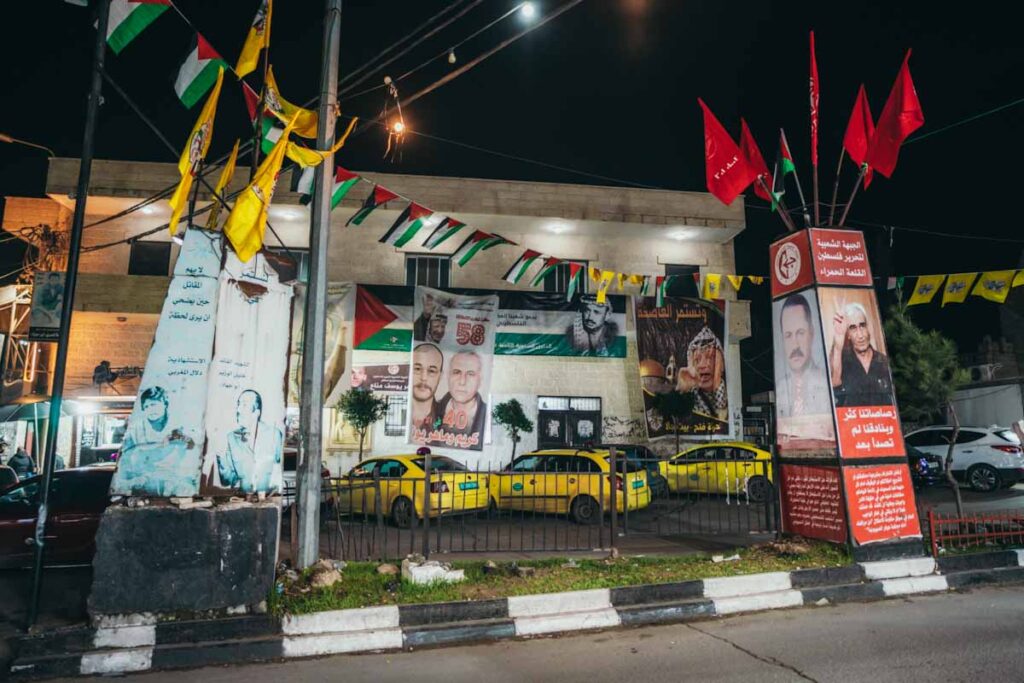
DO YOU HAVE A TROUBLE STAMP ON YOUR PASSPORT?
When we travelled to Palestine, we had two passports with us, and the one we used had stamps from Syria and Iraq and multiple stamps from Lebanon and other Muslim countries. We decided to cross the overland Taba border between Egypt and Israel with that passport as we thought it might be even more suspicious if we used the clean ,,backup” passport, and they found the other one with stamps from those countries. We have been detained and questioned for 5 hours, including a body search and a very detailed bag search. After 5 hours, we successfully made it to Israel. You can read a full report on crossing the Taba border into Israel here.
After we made it to Israel, we no longer had any issues, even though multiple officers in both Israel and Palestine checked our passports.
ATM/MONEY
The currency in Palestine is the Israeli Shekel. $1 = 3.58 ILS. Regarding ATMs money withdrawal, you don’t have to worry about anything as ATMs are widely spread and easy to find. We withdraw money in Palestine many times and never faced any issues. However, there is always a transaction fee of around 11 ILS ($3). In the Bank of Palestine, the withdrawal fee was even 40 ILS, so don’t even bother. We usually used the ATM of the Arab Bank. We used cash everywhere in Palestine; they are not used to card payments. But it is possible in some places.
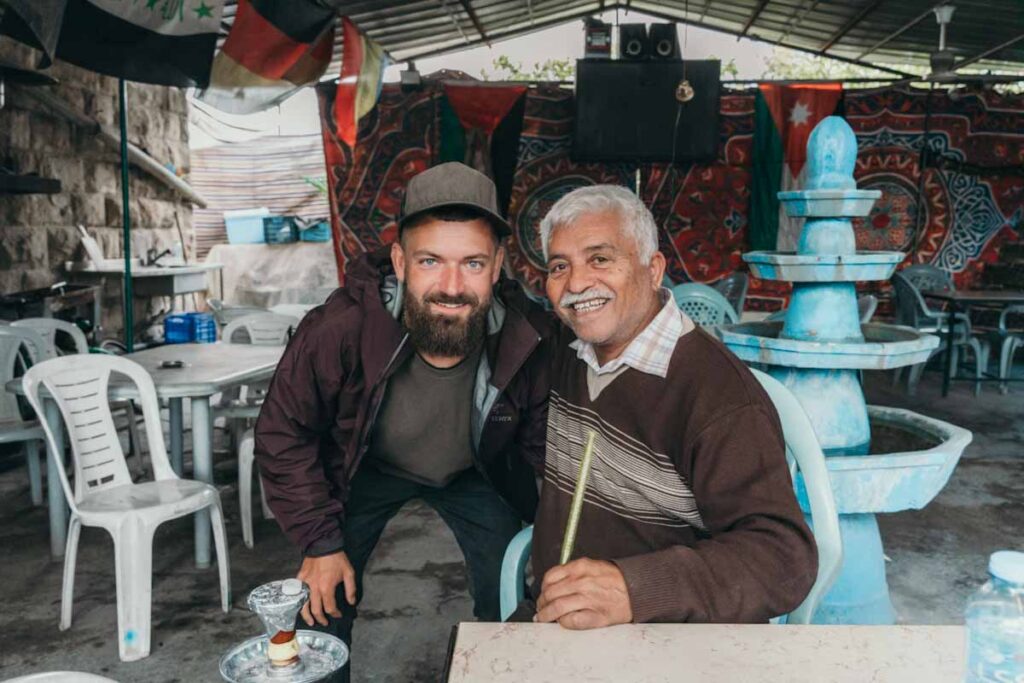
INTERNET & SIM CARD
The Internet in Palestine is very good. In every accommodation we stayed wifi was very fast and reliable. Regarding Sim cards, you have two options. Either buy it in Palestine or Israel. SIM cards in Palestine are cheaper. However, their coverage is not great, and it’s only 2G, sometimes 3G. We recommend getting a SIM card in Israel. We bought ours in Jerusalem. It is not the cheapest, but it worked well in most places. However, we had some outages in Bethlehem and Hebron. Anyway, from what we heard from others, Pelephone is still the best option for Palestine. To access some sites, you will need a VPN. We paid 100 ILS ($28) for a Pelephone SIM card with 100 GB, unlimited use of apps such as Instagram and Facebook, and they provide 5G. Even Palestinians use Israeli sim cards. Don’t buy a sim card at the airport; they are overpriced.
VPN FOR PALESTINE
To access many sites in Palestine, it is necessary to use a reliable VPN app. Don’t use the free VPN apps, as they are unreliable, and there is always a safety risk as they can steal your data. We always use NordVPN everywhere we travel. They have excellent services and very fast support, which is important when you need to access the internet quickly. In some countries we visited, VPN can be blocked, but after we contacted the helpdesk of NordVPN, they quickly navigated us how to connect. Check the link below for the discount option – sometimes you can get up to 65% discount for a 2-year plan.
Check the best prices for NordVPN here.
PRICES IN PALESTINE
- Entrance fees: usually around 5-10 ILS ($1.4 – 2.8)
- Accommodation: $17-$35 for both of us per night
- Transportation: For 11 days in Palestine and using Shared taxis, we spent around $50 per person; you can see more details in How to get around Palestine section.
- Falafel sandwich: 5 ILS ($1.4)
- Ice cream: 5 ILS ($1.4)
- Palestinian Pizza: 7-10 ILS ($2-2.8)
In 11 days in Palestine, we spend around $750 for both of us ($375 per person), so I’d say Palestine is a very affordable destination. In that budget, I don’t count the flight ticket from Tel Aviv to Europe, which costs an additional $50 per person.
WHERE TO STAY IN PALESTINE
You can find accommodation on Booking.com and also Airbnb. However, during our visit, the hotels started to disappear from Booking.com due to some new laws and hotel owners told us that the issue is they can not receive money through booking into their bank account due to them being from Palestine. Just another example of unfair play Palestinians have to go through. Anyway, you can also try to contact the hotels directly by searching their number through Google. The majority of people use WhatsApp, and Couchsurfing is also popular. We got in touch with a few incredible people who have been willing to show us around. The sleepover never worked, though, but at least for meeting local friends, it is incredible. See below all the accommodations we used in Palestine. We describe each accommodation in greater detail in our 11 days itinerary below.
The following prices are per night for two people:
- Jerusalem I Abraham hostel ($52, dorms)
- Bethlehem I Staying with Ibrahim’s family in Dheisha Refugee Camp ($33)
- Hebron I Friends Hostel Area B ($32)
- Ramallah I Eco Hostel Ramallah ($40, dorms)
- Jericho I Aqabat Jabr Refugee Camp Sami hostel ($33)
- Nablus I Turquoise Guest House ($36, dorms)
- Jenin I Jenin Creative Cultural Center ($55)
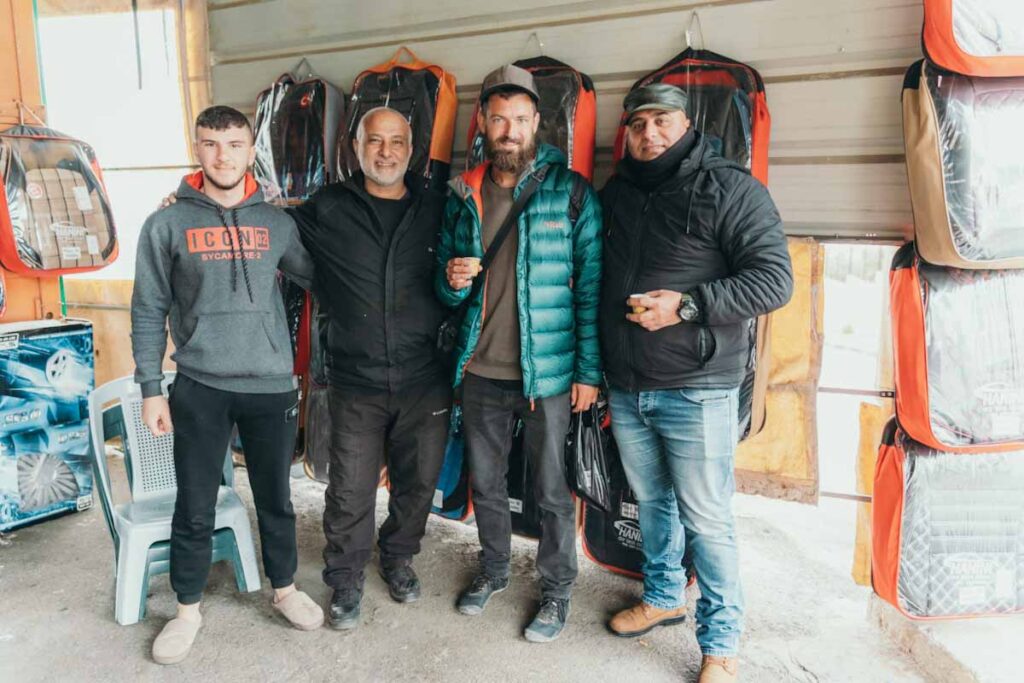
STAYING IN REFUGEE CAMPS
If you truly want to understand Palestine, there is no better way than staying overnight in one of many refugee camps in Palestine. We absolutely loved staying with locals in camps, listening to their stories, and seeing the reality with our own eyes. Read our detailed travel guide on how and where you can stay in refugee camps in Palestine and how to book it, including contacts and exact locations in Bethlehem, Hebron and Jericho.
Read more: How to stay in Refugee Camps in Palestine & Things to know.
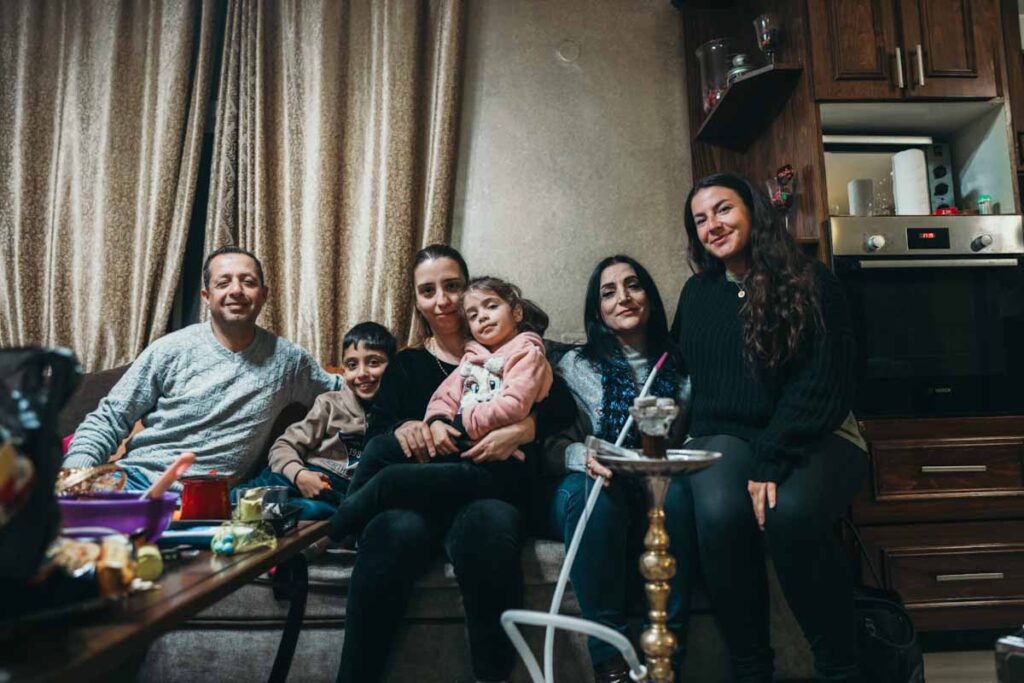
QUICK SUMMARY OF OUR 11 DAYS ITINERARY:
- DAY 1 JERUSALEM (1 NIGHT)
- DAY 2 – 3 BETHLEHEM (2 NIGHTS) – Checkpoint 300 to get in West Bank
- DAY 4 – 5 HEBRON (2 NIGHTS)
- DAY 6 RAMALLAH (1 NIGHT)
- DAY 7 – 8 JERICHO (2 NIGHTS)
- DAY 9 – 10 NABLUS (2 NIGHTS)
- DAY 11 JENIN – Emek Harod Checkpoint to get out West Bank
Map of the 11-day itinerary for Palestine
11 DAYS ITINERARY FOR PALESTINE
DAY 1: JERUSALEM
The first minute we stepped out from a bus in Jerusalem, we found ourselves immersed in a culture we haven’t seen before. We felt like we showed up in an old movie with all the fashion people in Jerusalem wear. Jerusalem is today part of Israel. However, East Jerusalem is inhabited by Palestinians.
Not every day you see a city that welcomes more religions, and Jerusalem is the holy place, sacred for Jews, Muslims and Christians.
Essential reading: How to visit top places in Jerusalem in one day.
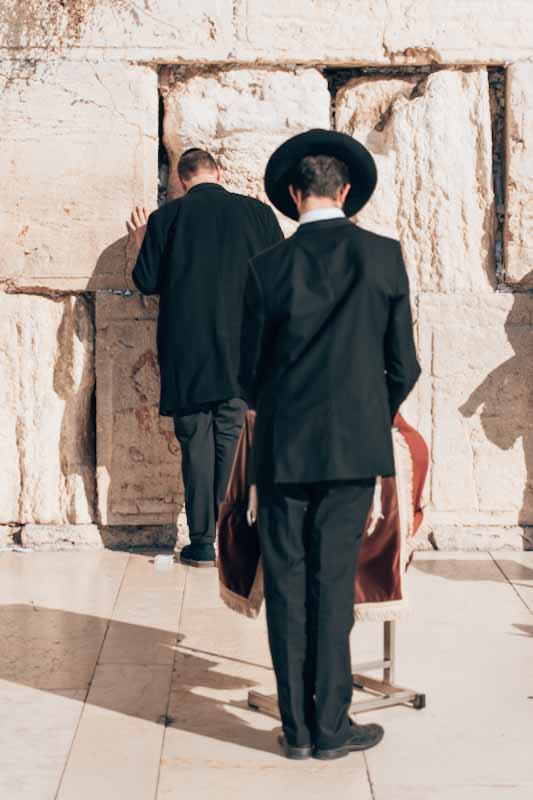
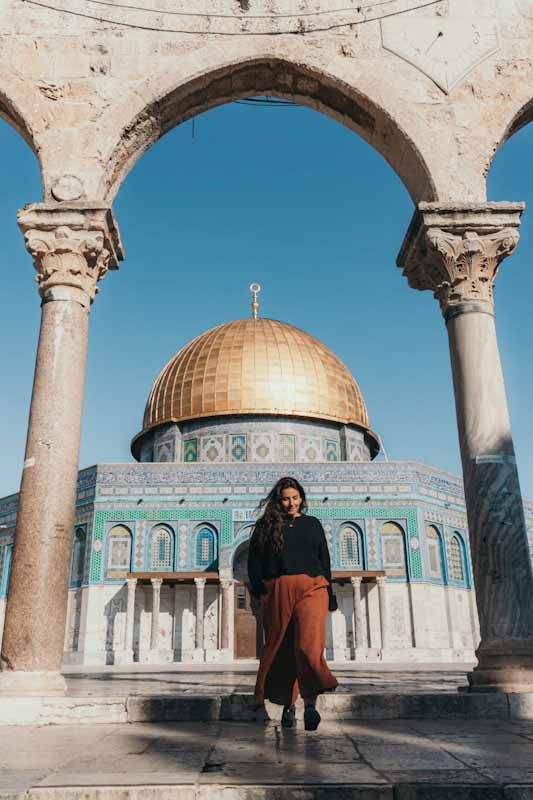
BEST THINGS TO SEE IN JERUSALEM
Temple Mount/ Al Haram Ash Sharif
The biggest landmark in Jerusalem, especially the Dome of the Rock, is the most holy and famous site. There are nine gates for Muslims to enter; however, as a non-muslim, you can only enter through the Gate of Moors (Bab Al Maghrib). It is recommended to line up early, as many tours are coming and you should expect huge queues. When we visited in January, there was a small queue, and it took just 10 minutes to get inside. You will go through the security check and then follow the wooden bridge that gives you a perfect view of the Western Wall.
The Dome of the Rock is where you find the foundation stone Jews believe is the centre of the earth. For Muslims, it is a place where Mohammed made his ascent. Non-muslims can’t enter the Dome of the Rock or Al Aqsa Mosque. But even from outside, we had a great time wandering around its plaza and admiring the architecture, which is simply stunning.
- Sites inside Temple Mount Areal: Dome of the Rock, Al Aqsa Mosque, Dome of the Chain, Sabil of Qaitbay, Scales of Souls, Bab Al Qattanin
- Opening hours for Temple Mount for non-muslims: 7 – 10:30am and 12:30 – 1:30 pm in winter and 7 – 11am and 1:30 – 2:30 pm in summer. Fridays and Saturdays are closed.
- Entrance fee: Free
- Security: They take security seriously in Temple Mount, and they will thoroughly search your bag while entering by the Gate of Moors. The military presence here is huge.
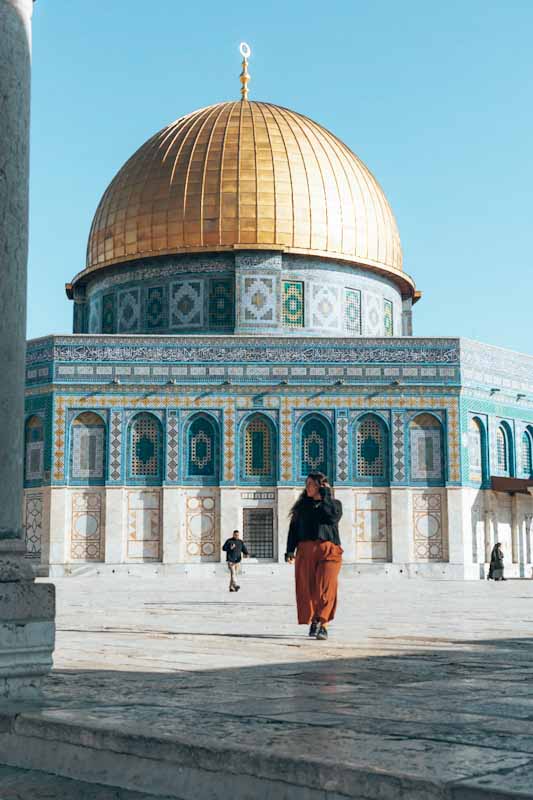
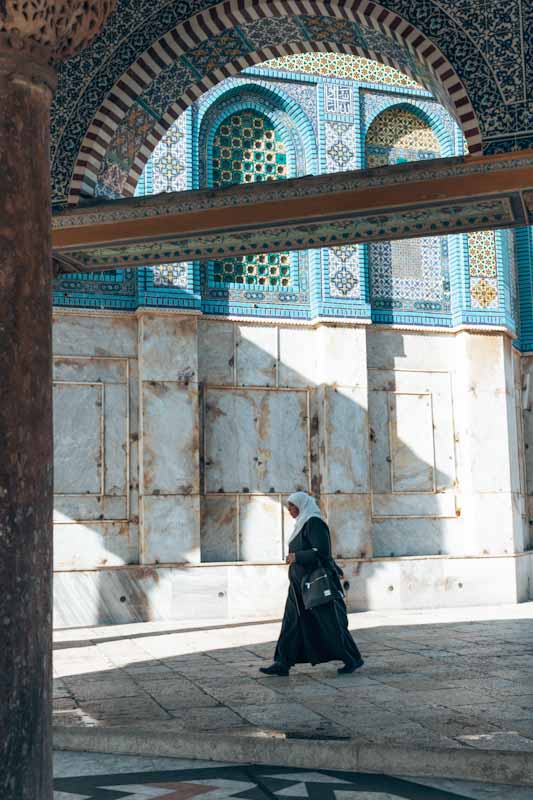
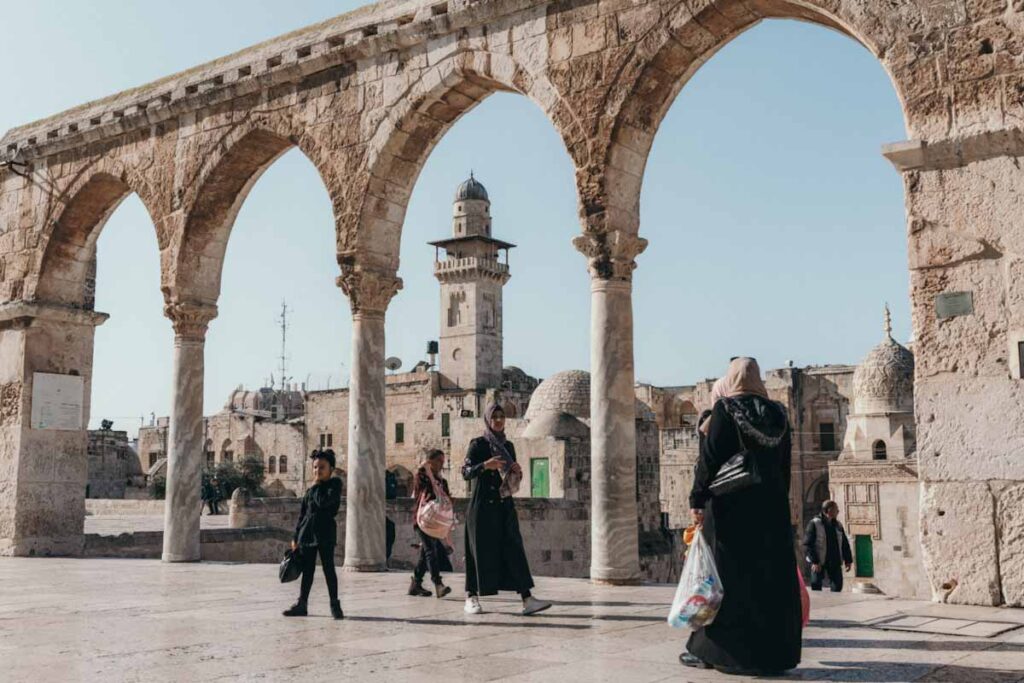
Western Wall
Western Wall is the holiest site in the world where Jews pray by the wall. We already mentioned above you get a perfect view of the Western Wall from above when walking on the wooden bridge when visiting Mount Temple. Stop there for a few minutes and just watch how Jews pray here. Western Wall is open 24 hours a day, but it makes the most sense if you come here after visiting Mount Temple as it is very close.
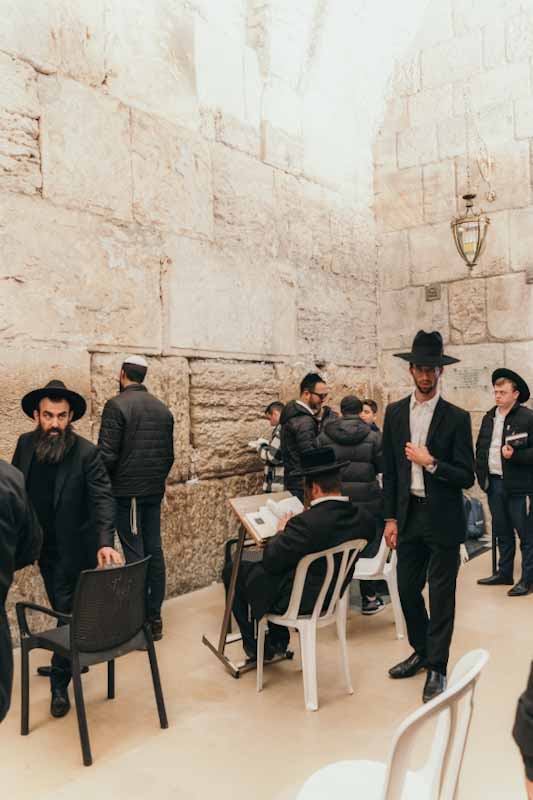
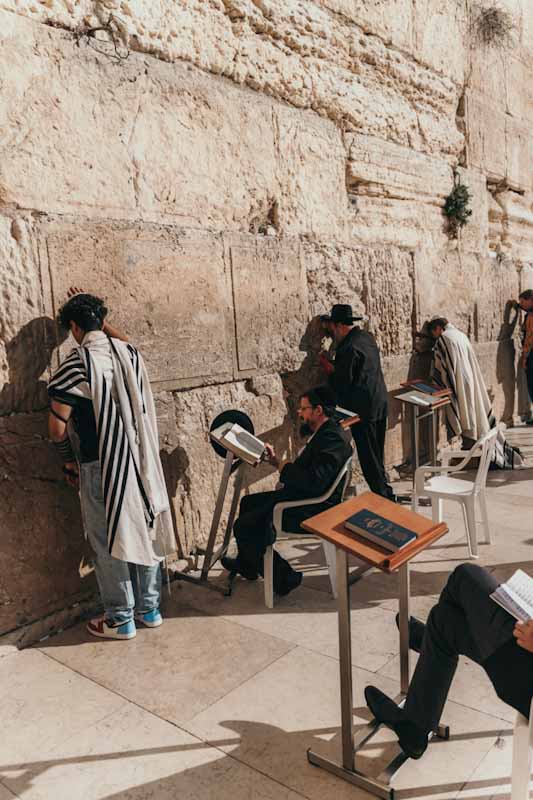
Church of the Holy Sepulchre
After seeing the holiest site for Jews, it’s time to move to the Christian Quarter, where the main pilgrimage site for Christians, the Church of the Holy Sepulchre, is to be found. Christians come and pray here by the empty tomb of Jesus. It is the place where Jesus was crucified. You find here the Stone of Unction, which is apparently where Jesus’ body was laid and prepared for burial.
- Opening hours of Church of the Holy Sepulchre: 5am – 8pm from April to September and 5am – 7pm from October to March.
- Entrance fee: Free
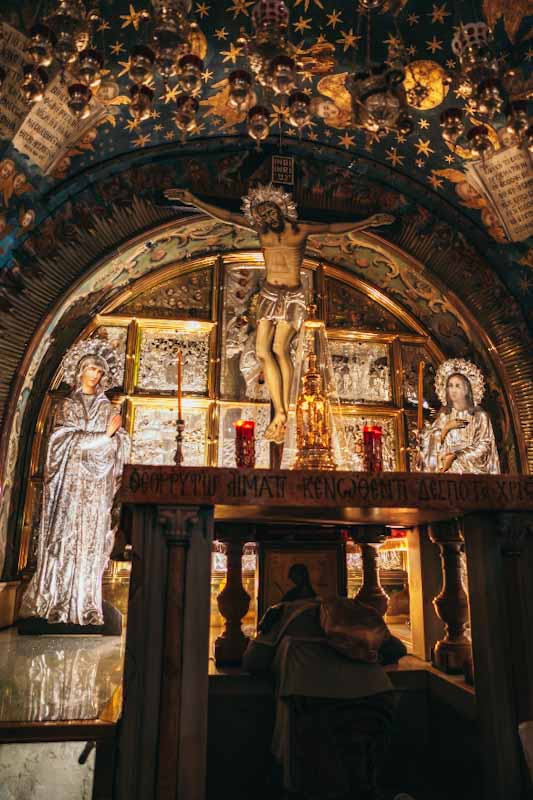
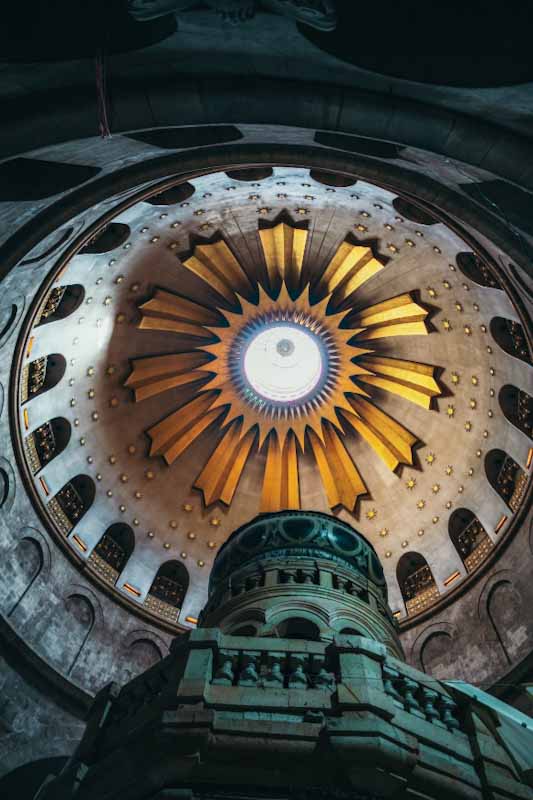
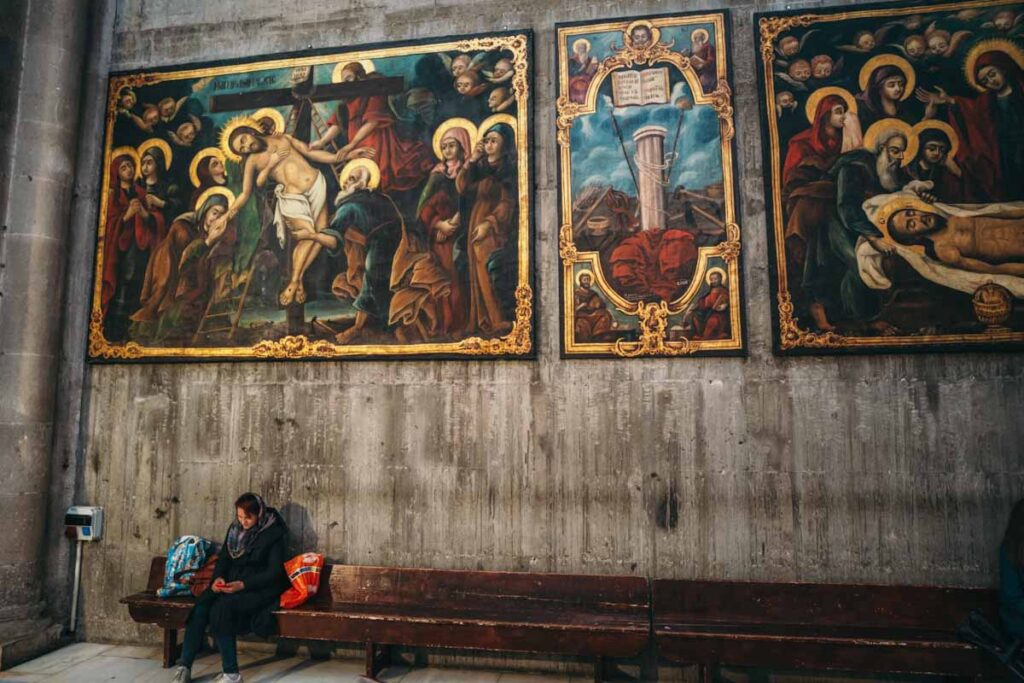
Via Dolorosa
Via Dolorosa is the holy walk through the Jerusalems’ holiest sites. It takes roughly one hour to walk this 600m paths; that is the one believed that Jesus took carrying the cross. We took a whole walk and did not expect such a spiritual experience. Having a map from Lonely Planet and reading the description of places as you go is worth it. The walk starts by St. Stephen (Lion’s) Gate, and it ends at the Church of the Holy Sepulchre.
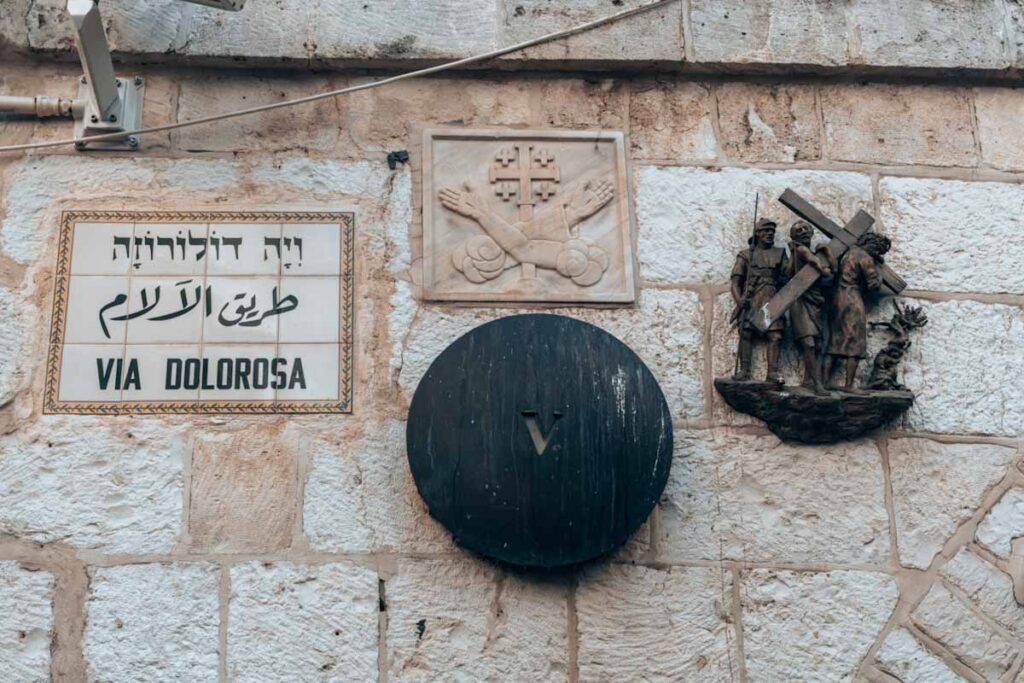
Mount of Olives
To end the day and watch the sunset with an unbeatable view over Jerusalem, head to the top of the Mount of Olives. We decided to walk from the old city, but you can also take bus number #83, which runs between Jaffa Gate and the top of the Mount of Olives. The viewpoint lies over the slopes of the cemetery where more than 150 000 Jews are buried. It is worth it to come here for epic views of Jerusalem with the shining golden Dome of the Rock.
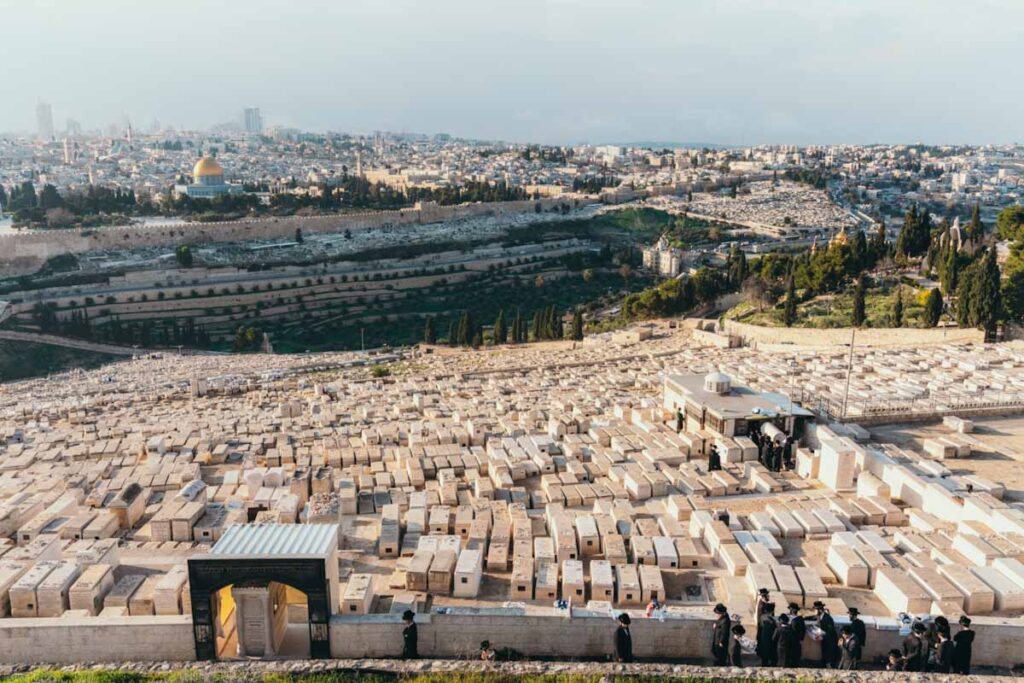
Mahane Yehuda Market
We enjoyed strolling through this vibrant market after sunset. You can expect many halva, bakeries, cool food stalls and eateries. If you want to buy some locally grown products such as dates, oils and much more, this is the place to be. This market stood here since the Ottoman period and is located on Yehuda St., which is an open market, especially for veggies and butchers, and Etz Chayim St., where all the eateries, bakeries and halva makers are. We ended our day in Jerusalem here.
- Opening hours for Mahane Yehuda Market: 8am – 7pm and 9am – 3pm on Fridays.
We managed to visit all these top sites in Jerusalem during a 1-day visit. We started exploring early in the morning, and we had plenty of time to see most places. However, you can easily spend more days here as there are many historical and religious sites to visit.
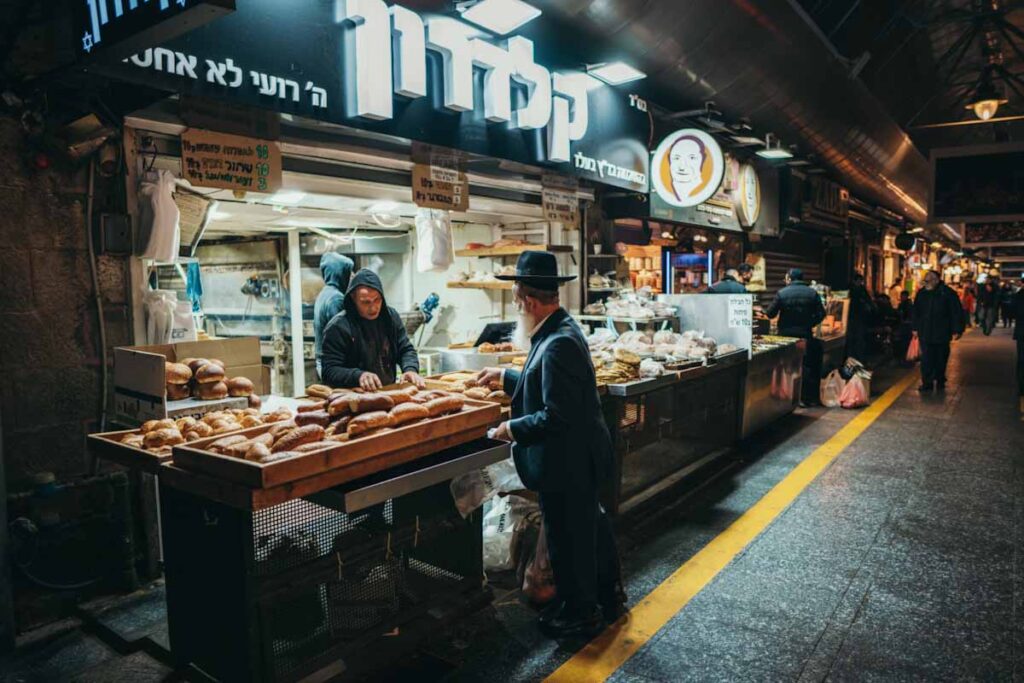
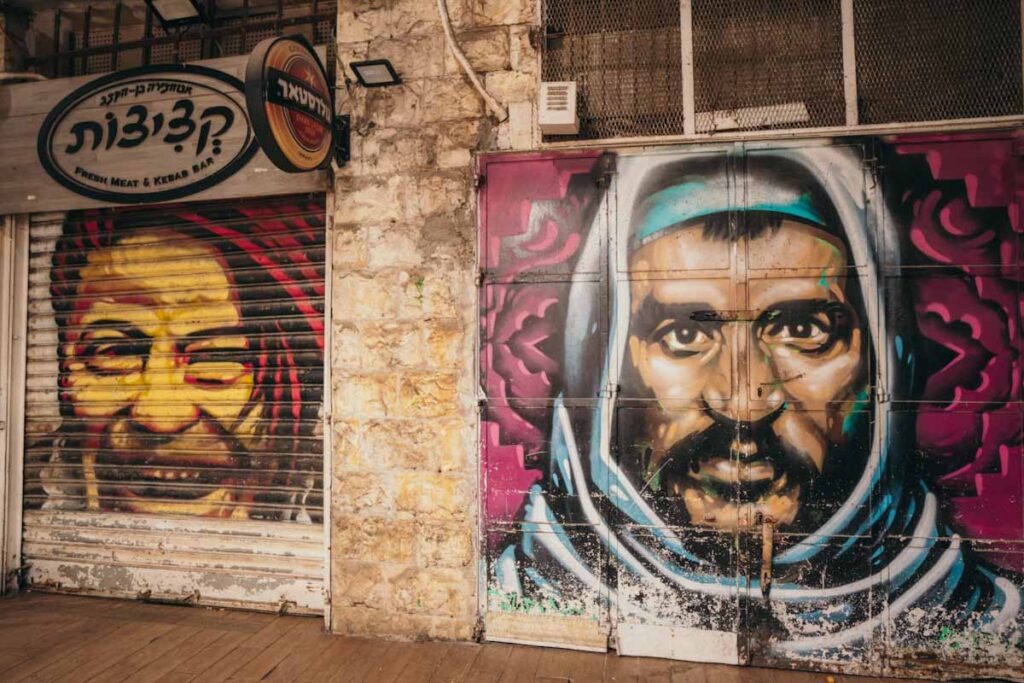
HOT TO GET AROUND JERUSALEM
Use Rav Kav Card and travel with trams and buses all around Jerusalem. You find the correct timetables in Moovit App. However, if you base yourself in the old town or close, you can basically visit all places by just walking around.
HOW TO GET TO JERUSALEM FROM EILAT
In Eilat, we took bus #444, which goes from Eilat Central Station. We got our tickets for 63 ILS and waited for an hour for the next bus as it was Shabbat, and the bus went every hour from 3pm. The bus wasn’t full, so I believe it was enough to get the bus ticket on the spot. We also bought here the Rav Kav card for public transport in Israel.
WHERE TO STAY IN JERUSALEM
The budget I Abraham Hostel – we highly recommend you stay here, as Jerusalem is pretty expensive, but staying in Abraham Hostel gives you a lot of advantages. They serve a huge, healthy local breakfast buffet that will make you full for most of the day. And if you pay for your stay in advance, you also get a free ticket for a beer in their bar. It is also located close to the centre, with a tram station right in front of them. It is one of the best hostels we have ever stayed in.
DAY 2-3: BETHLEHEM
Bethlehem is a synonym for religious travel in West Bank. Many pilgrims come to see the main sight, which is the Church of the Nativity. Many tours are coming here, but is there more to see from Bethlehem? Oh, yes, but you have to go behind the tourist trail. Many tourists come with a guide as they’re worried about crossing the checkpoints independently into Palestine. What a shame because the true understanding of what is happening in Palestine does not lie in the Church of the Nativity. But far behind the line when you experience staying with a local family in the Dheisha refugee camp in Bethlehem. Read our recommendation of places that you can visit in two days in Bethlehem.
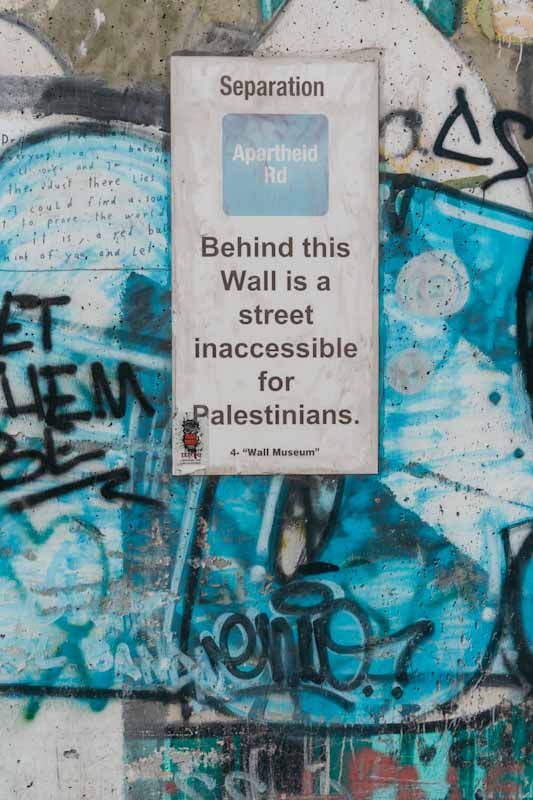
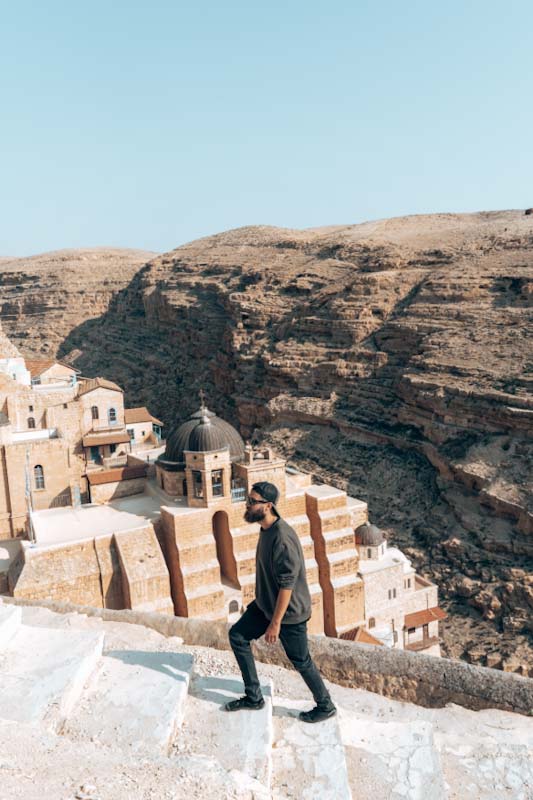
BEST THINGS TO SEE IN BETHLEHEM
IsraelI separation wall
As soon as you cross Checkpoint 300 to Palestine, you will see the huge separation wall that is known as Israeli Separation Wall. It is a concrete wall up to 8m high that separates Israel from West Bank. The first feeling of this wall is pretty depressing. Follow the path along the wall and walk towards Walled Off Hotel. It is where you will see the most powerful graffiti. Basically, the whole wall is covered with graffiti, and each of them has a powerful message. Take your time to read it, to carefully watch all the art that helps Palestinians express how they feel. Truly powerful. Before we turned to the street that led to the Walled Off Hotel, there was a petrol station where we left our backpacks. The friend of Ibrahim, our host in Bethlehem, arranged it for us so we didn’t have to carry it the whole day before he picked us up later in the evening. Take your time and make a loop from Checkpoint 300. Go straight until the turn left that takes you to the Walled Off Hotel. Then turn left again, follow the wall until you can turn left, and follow the path down the hill, check the graffitis along the way. This loop is the most common to walk, as you will see most graffiti on the wall.
From the point of Israel, they built this wall for the safety of Israelis as frequent bomb attacks were taking place in the past, killing many Israelis. From the Palestinian point of view, this wall is to separate Palestinians, humiliate them, control their movement and show who has the power.
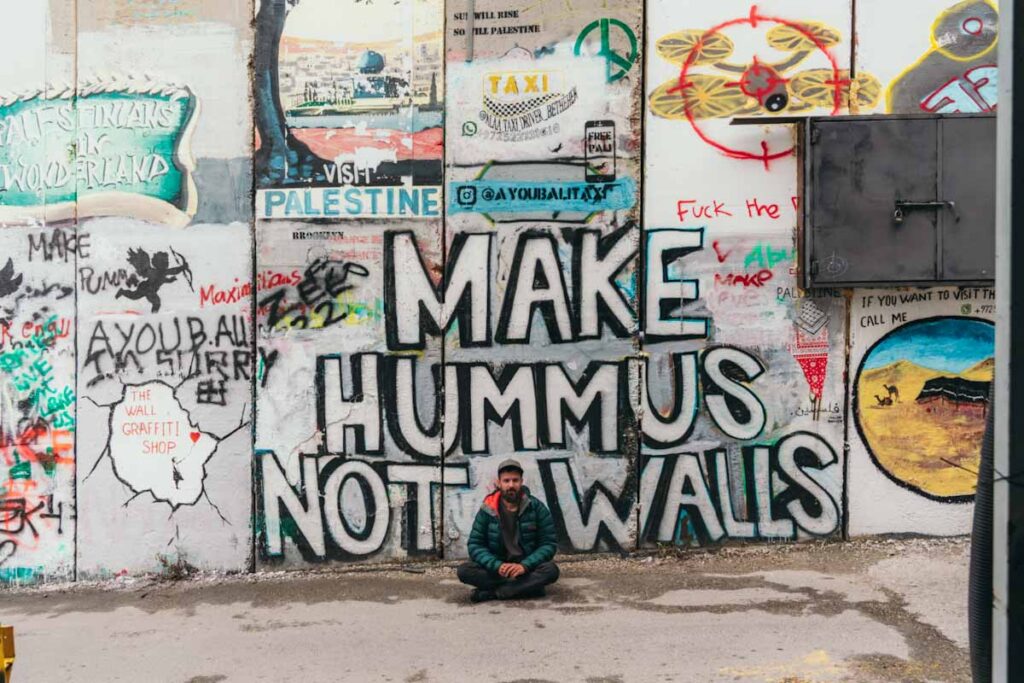
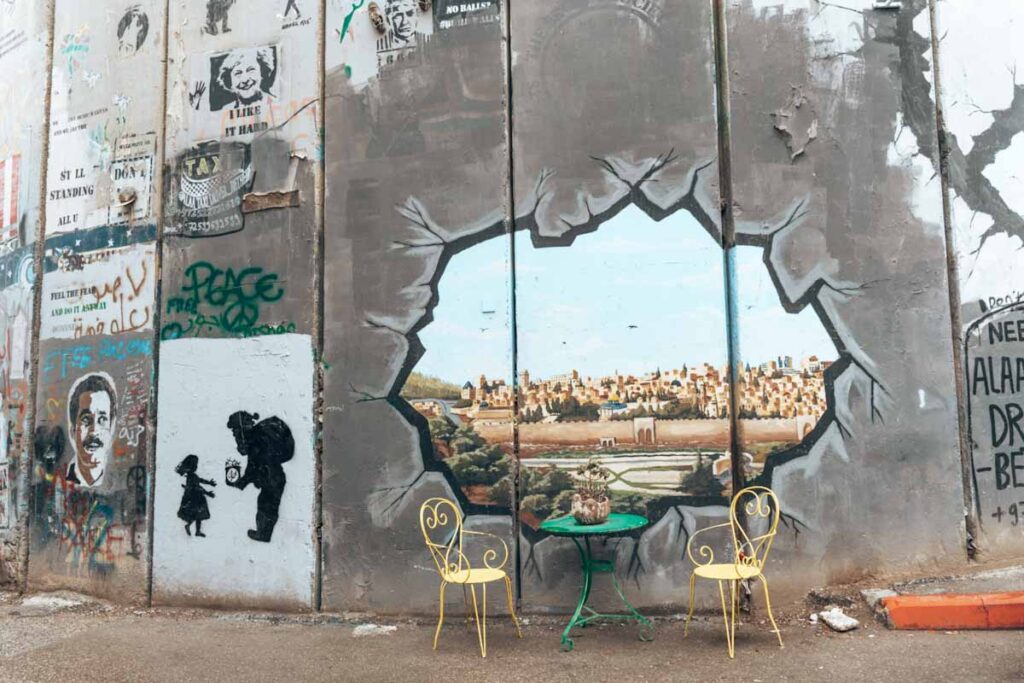
Walled-off Hotel + museum
If there is only one place you should see in Bethlehem, you need to visit the museum inside the Walled Off Hotel. Hands down, this museum was the best we have ever seen, as it’s a good start to understanding the problem between Israel and Palestine.
You can’t take photos inside the museum. But there was (not only) one powerful moment when you walk through the museum and suddenly the phone rings. I came closer and saw the sign: ,,Please, answer the phone”. When I answered the phone, I heard: ,,This is Israeli Defence Forces; you have 5 minutes to leave your house until we blow it away”. I felt sick in my stomach. Is this the life people face here?
Besides the museum, the hotel is stylish inside, with a piano bar, interesting decorations, and occasional live music on Saturdays. If you don’t want to spend the night in a refugee camp, you can stay here. Who would not like to stay in a hotel that claims to have the worst view in the world?
- Opening times of the museum: 11am – 7:30pm
- Entry fee: 20 ILS ($5.5)
Want to stay in the Walled-Off Hotel? Book it here.
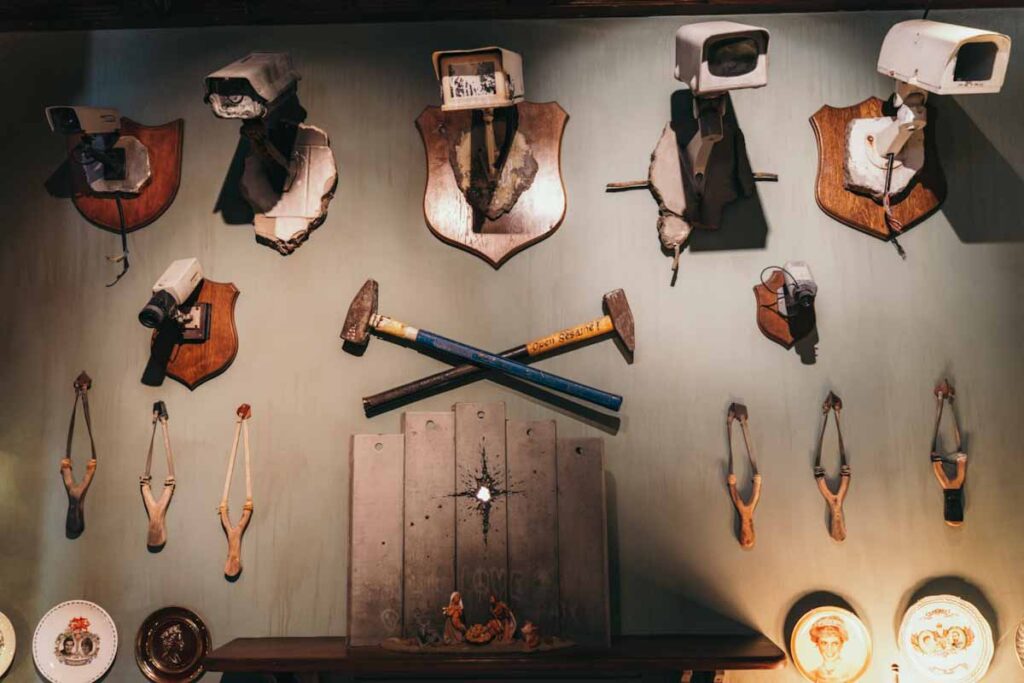
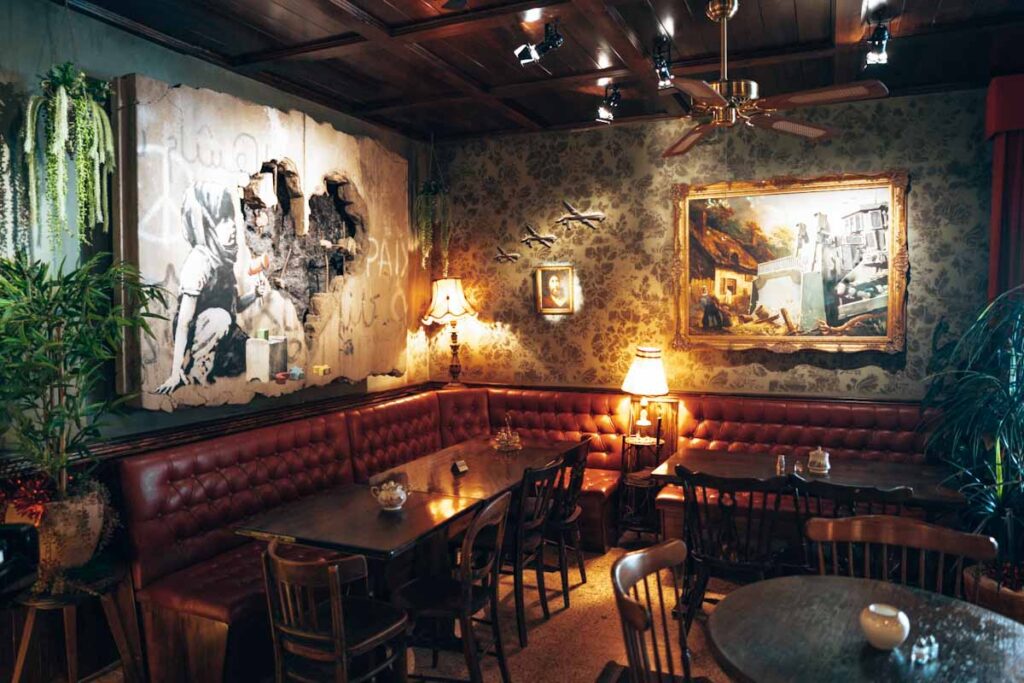
Church of the Nativity
The most important religious site in Bethlehem. This Church is believed to be built on the spot where Jesus was born. To enter the Church, you must bow your head through the tiny Door of Humility built in the Ottoman Era. Once you admire the detailed decoration in the main hall, descend the stairs into the Grotto of the Nativity. It is the place where Jesus was born. When we visited, we even saw a priest walking around the Church. However, expect lots of people to visit this site.
- Opening Hours: 6:30am to 7:30 pm and 6:30am to 6pm in winter.
- Entrance fee: Free
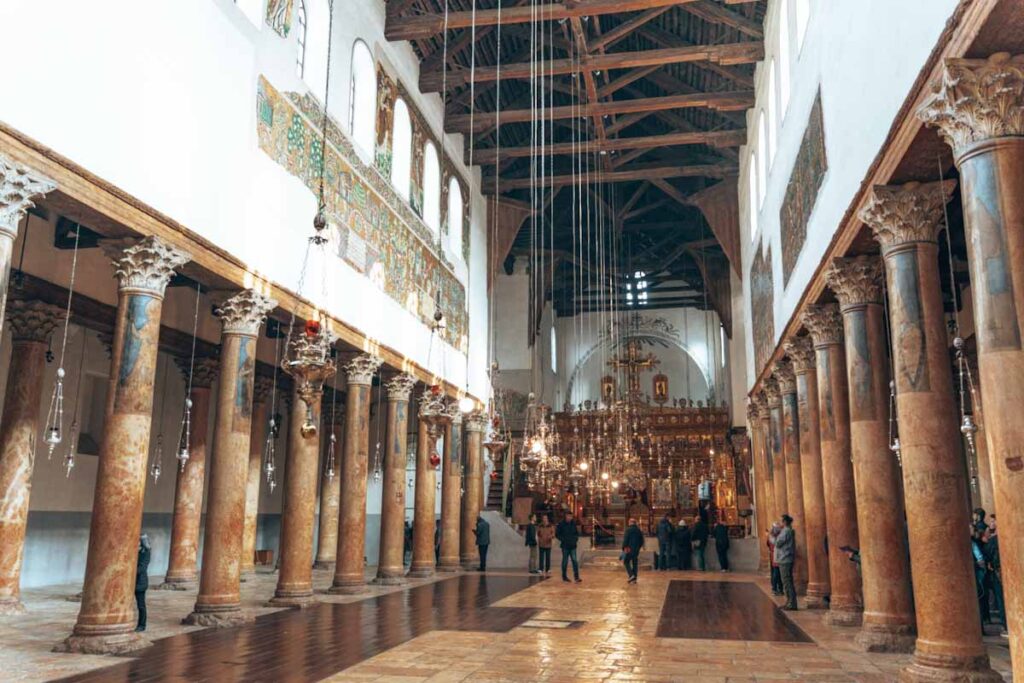
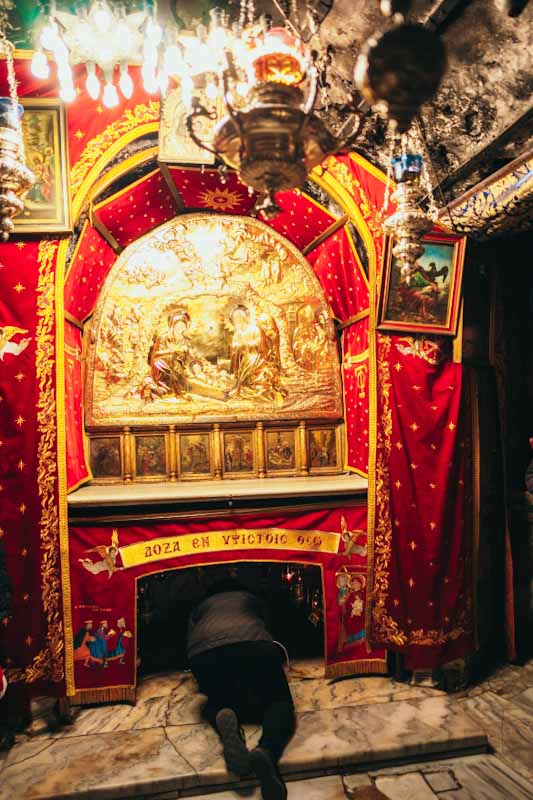
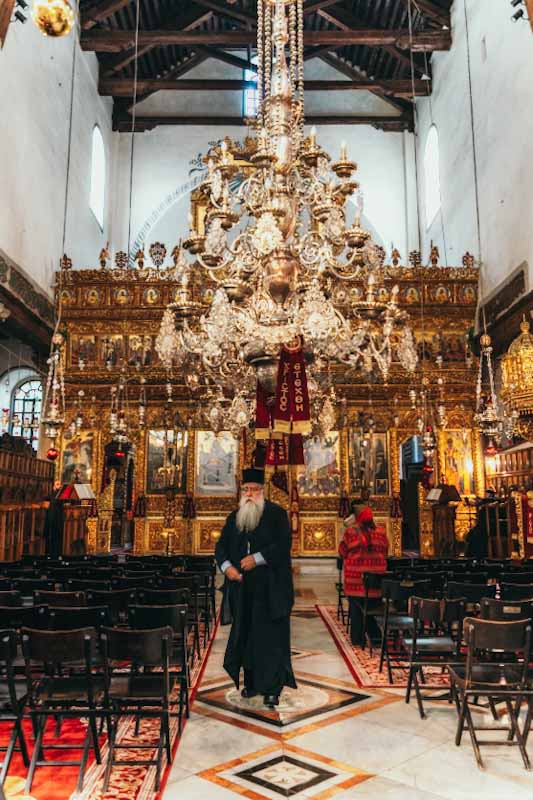
St. Catherine Church
Right next to the Church of the Nativity, there is St. Catherine Church. Visit the underground praying hall and the outside little garden. We liked this Church; very peaceful and atmospheric.
- Opening Hours: 6:30am to 7:30 pm and 6:30am to 6pm in winter.
- Entrance fee: Free
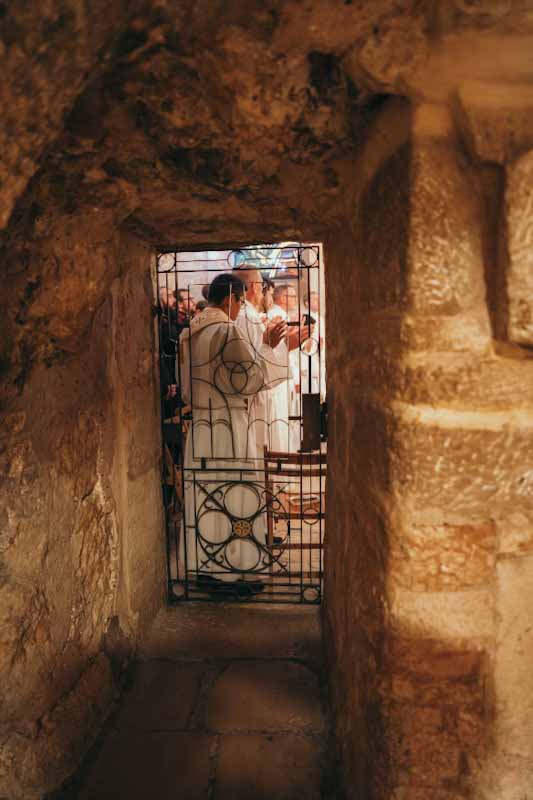
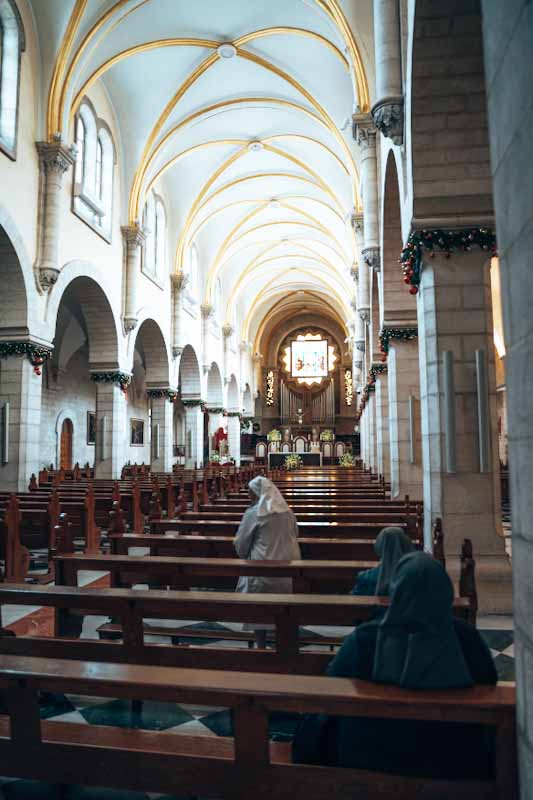
Milk Grotto Chapel
Visitors often overlook this Chapel, but once in the centre, it is just a short walk to visit this beautiful place. It is believed that it is where Mary and Joseph fed their baby, and after the milk dropped on the floor, it turned the red rock into white.
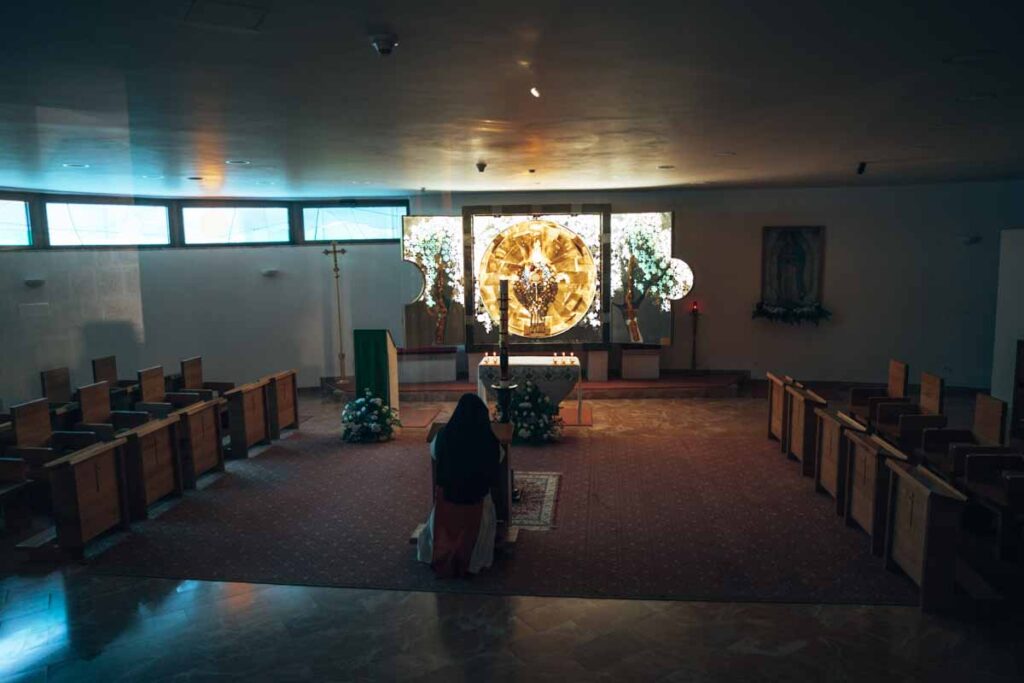
Green Market
The main souq in Bethlehem, you can visit after the Church as it is right in the centre. Here, you will meet very friendly people, have a chat with them, buy some fresh fruit or a small snack and absorb the atmosphere.
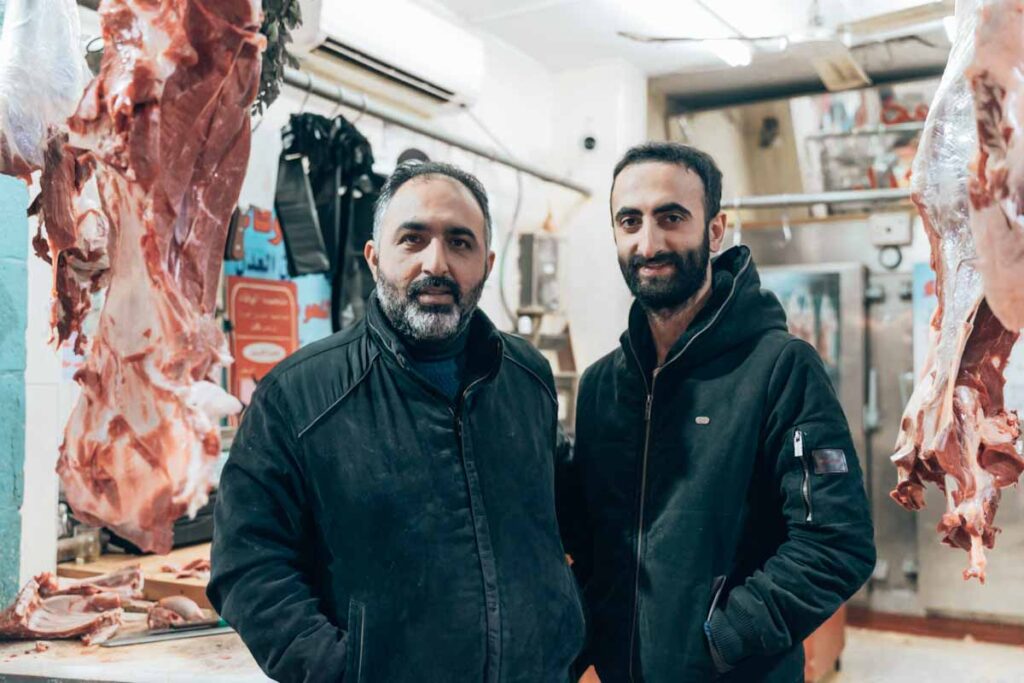
Refugee camps in Bethlehem
Another must and very important thing to experience not only in Bethlehem but the whole of Palestine is to visit refugee camps. There are two camps in Bethlehem. Dheisha and Aida. We visited both independently and spent a night in Dheisha with Ibrahim’s family. It was an unforgettable experience; you got to learn so much and hear the stories that you would never hear in media.
We visited the Aida refugee camp on our second day after we returned from Mar Saba Monastery. We walked through the camp, took some photos and did not experience any issues. People there are very friendly and welcoming, happy to see foreigners coming on their own. Right by the entrance, we were invited into the Car Mechanic shop because as soon as they saw us, they almost yelled with excitement. It was such a warm welcome; we had a nice conversation with a cup of coffee.
Essential reading: How to spend a night in a refugee camp in Palestine.
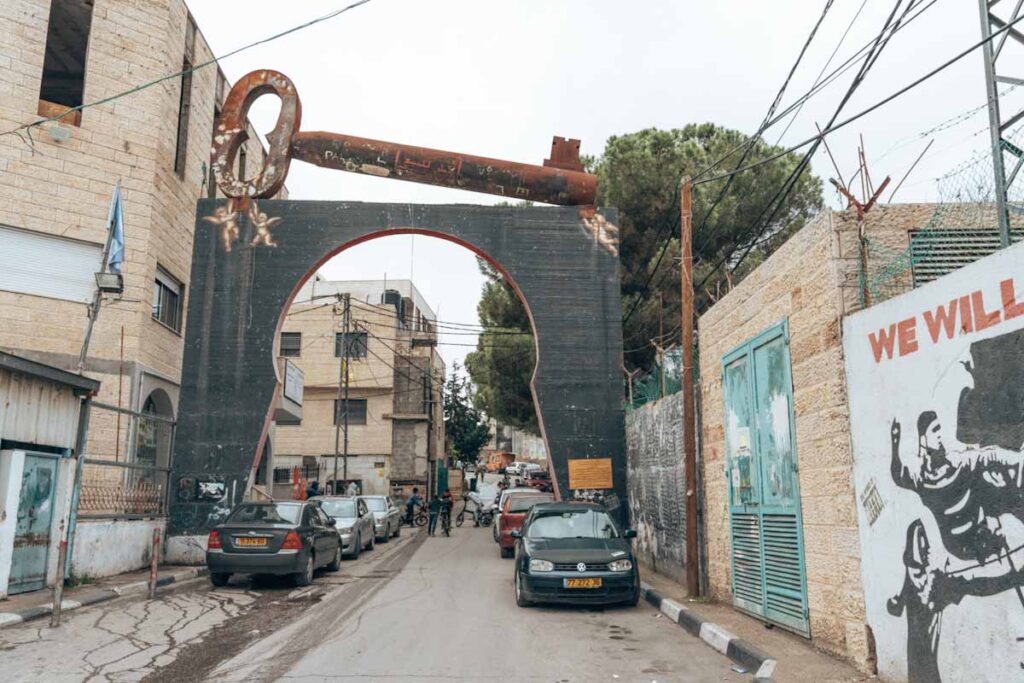
Mar Saba Monastery (Half-day trip)
Mar Saba is a dramatic cliff-clinging monastery half an hour from Bethlehem. It is our favourite place we visited as the monastery, and the surroundings are breathtaking. Women are not permitted inside, but let’s make it clear. It is the outside look over the monastery from the opposite slope that is the main goal of this trip. Men can enter inside and take a tour with one of the monks. When we visited in January, it was open between 9am to 2pm. Once you arrive at the monastery, follow the stairs and trail that leads down the valley. Once there, cross the small bridge over the river and follow the trail that takes you all the way up the slope opposite the monastery. From there, find a spot and the best viewpoints to view the Mar Saba Monastery. When we visited, we were the only ones who hiked on the opposite slope, but surely it is worth it; otherwise, you miss out on the main beauty. It takes only half an hour to get to the other side of the slope. Ensure you have water with you; it is quite warm when the sun shines. On both sides, there is a stall where two brothers sell some small snacks, tea, coffee and water.
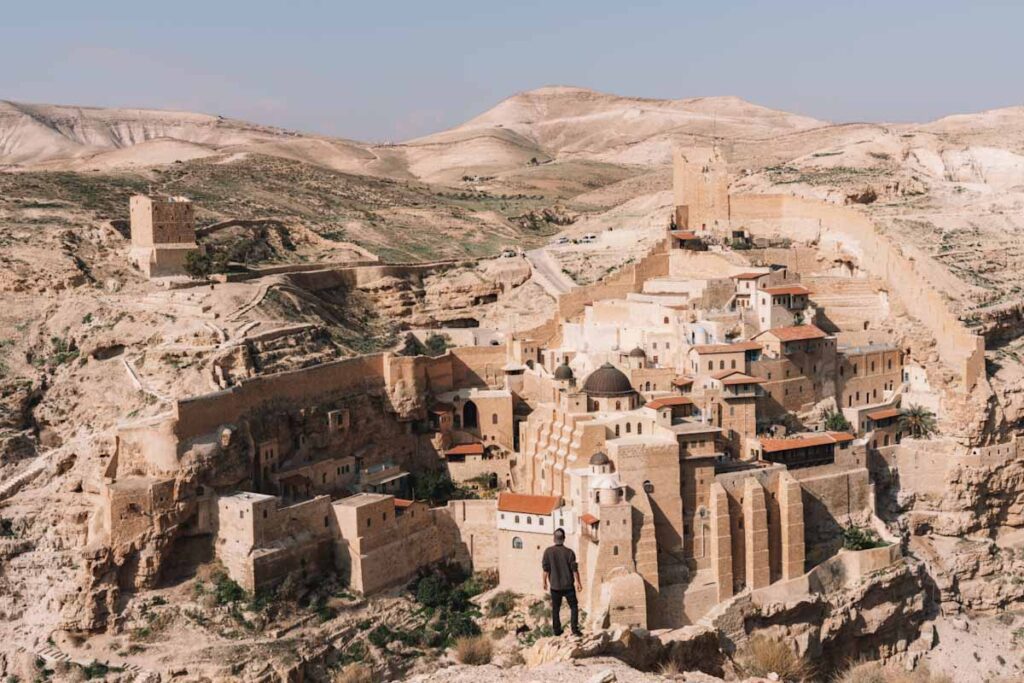
How to get to Mar Saba from Betlehem
Take a shared taxi (yellow minivan) from the central bus station located in the basement of the Bethlehem city mall, where KFC is. You’ll see a lot of yellow minivans waiting there. Search for one that goes to Ubediya. Be aware that some taxi drivers might want to cheat you; they told us that it is dangerous to go alone and that we should go with them, a private taxi for 150 – 200 ILS. We did our research and talked with locals, and we found it very safe and cheap to go independently. Shared taxi costs 5 ILS ($1.4), and the ride takes around 30 minutes, it is 12 km. The shared taxi stop is at the end of the village, by the brown sign pointing the way to Mar Saba.
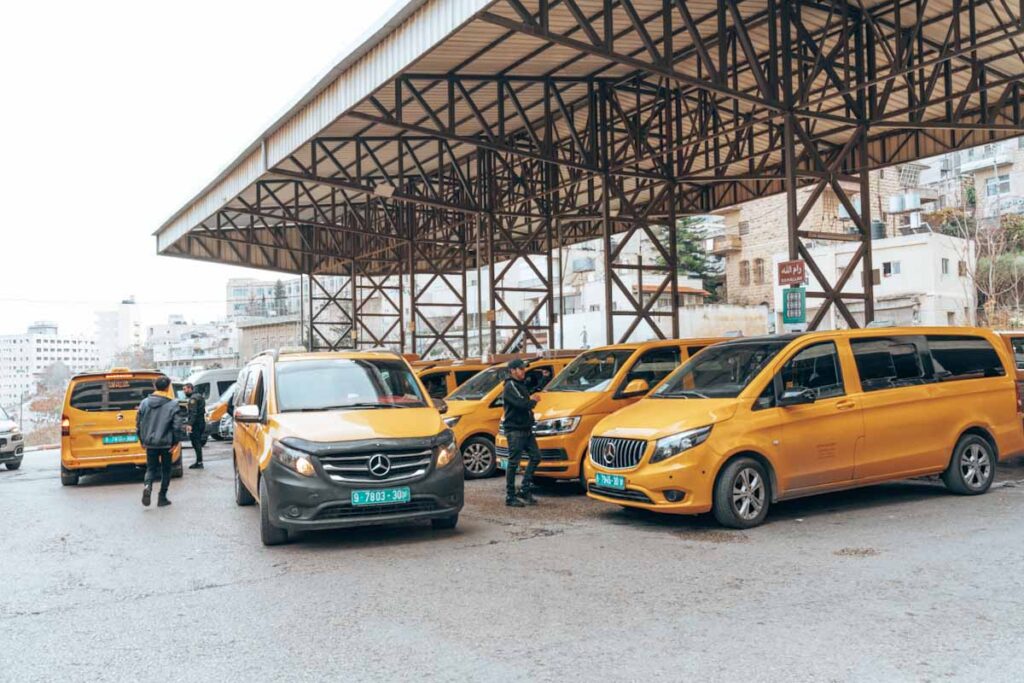
From there, hike down the hill on the road, 4.5 km, until you reach the monastery. In the middle of the way, there is a nice viewpoint. Many taxis and buses with tourists or locals go there every day. You can also hitchhike. We were hiking, and after just a few metres from the shared taxi stop, a taxi with a French tourist stopped and offered us a lift to the monastery for free and we gladly accepted. We stopped at the viewpoint on the way down.
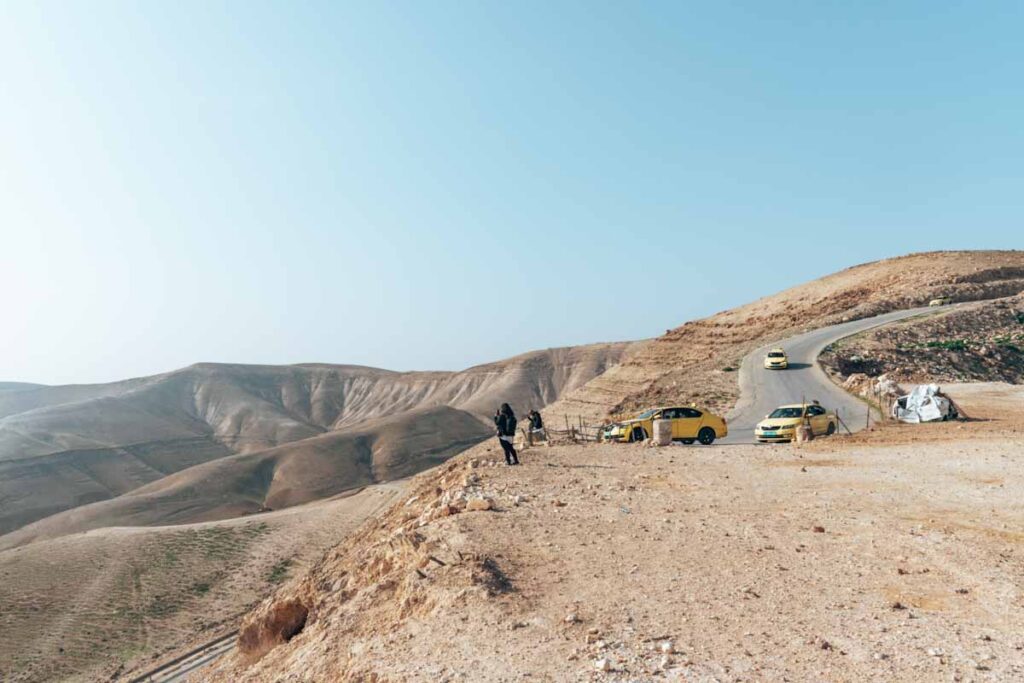
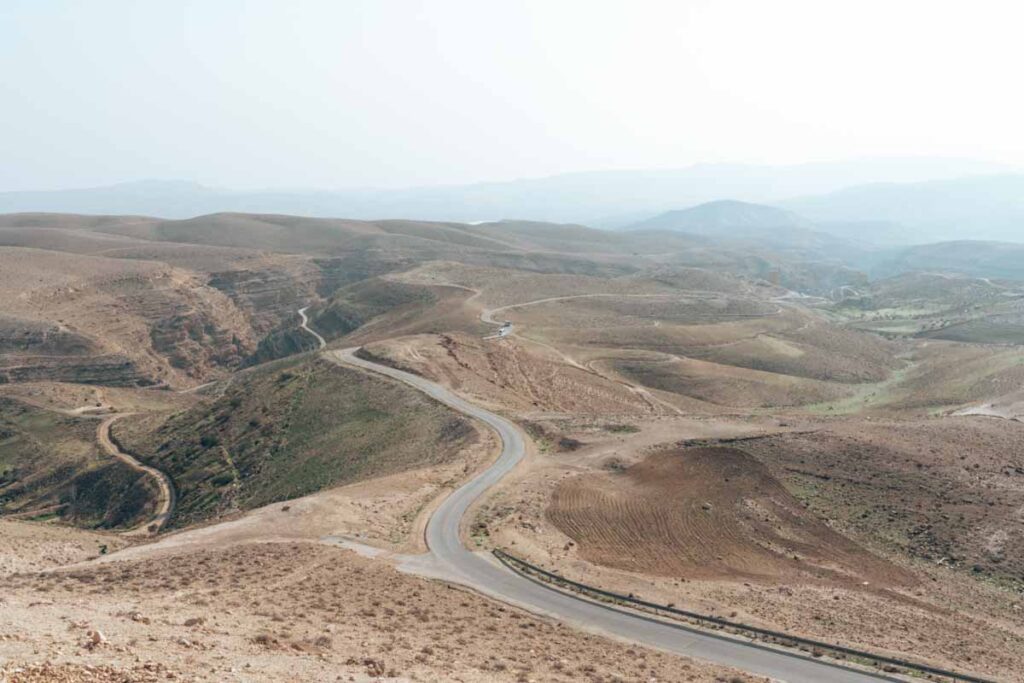
To go back, it’s the same process. Ask someone to take you up the hill, where the shared taxi dropped you. Or hike, but note this part is only uphill four and a half km. It will take around one and a half hours to hike, and it is a safe area. There is a local guy selling tea & snacks, and he offered to take us uphill for 19 ILS ($5.3). Since there were no more cars at the monastery when we finished exploring, we accepted his offer, as simply it was a faster and easier solution than hiking 4.5 km uphill. After 10 minutes ride, we arrived exactly when the shared taxi arrived, and we made our way back to Bethlehem from the same spot where they had dropped us off earlier (5 ILS).
Is it safe to go alone? Yes. We felt perfectly safe and comfortable. You basically just walk down the hill from Ubediya town; you have almost all the way the monastery in sight. There is traffic daily, either tour buses, many taxis and local people coming. Chances are that someone will offer you a lift, or if you feel like you can ask them & hitchhike.
- Opening times: 9am – 2pm
- Entry fee: Free
- Total time from leaving Bethlehem and being back to Bethlehem: 3 hours (9-noon)
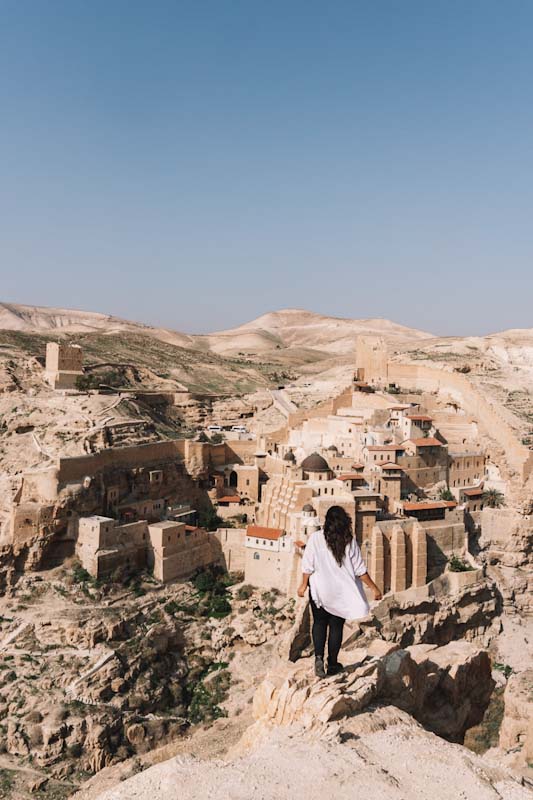
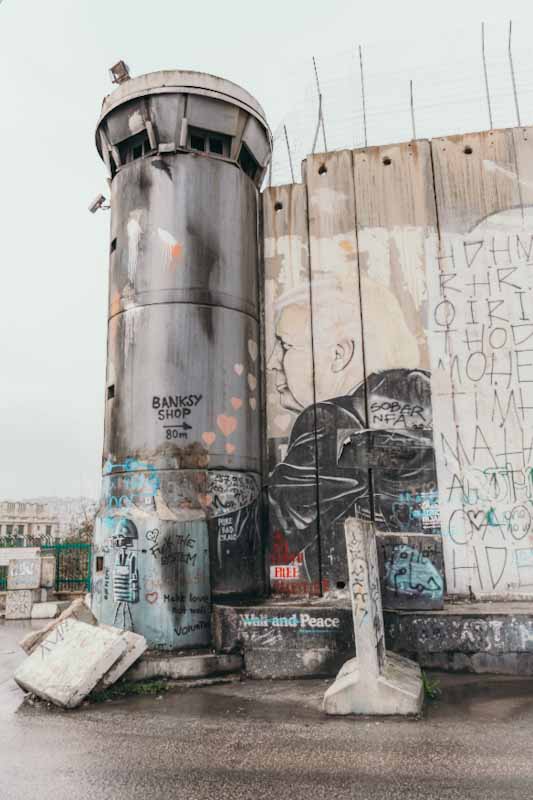
HOW TO GET TO BETHLEHEM
From Jerusalem, we took bus #234 (5.5 ILS, 30 minutes) from HaNevi’im Terminal from Damascus Gate, which takes you to Checkpoint 300, which we crossed on foot. There is no control if you’re crossing in the direction from Jerusalem to Bethlehem, so it is very fast and easy to get into Palestine.
Another option is to take bus #231, which actually crosses into Bethlehem, but it takes 1 hour, and we felt like it is better to experience and cross Checkpoint 300 ourselves.
TIP: As soon as you get to Israel, get a Rav-Kav card for public transport. You can top it up in kiosks or online through the Rav-Kav Online app and then use it for buses in Jerusalem.
HOW TO GET AROUND BETHLEHEM
Taxi or shared taxi is the common way of transportation, and it is quite cheap. Yellow taxi with black sides is a shared taxi, and you can expect to pay 3 ILS for the ride in the city or to Dheisha and Aida refugee camps. If the taxi is only yellow, it means it is private, and the charge will be higher. You can expect to pay around 15 – 20 ILS for a private ride.
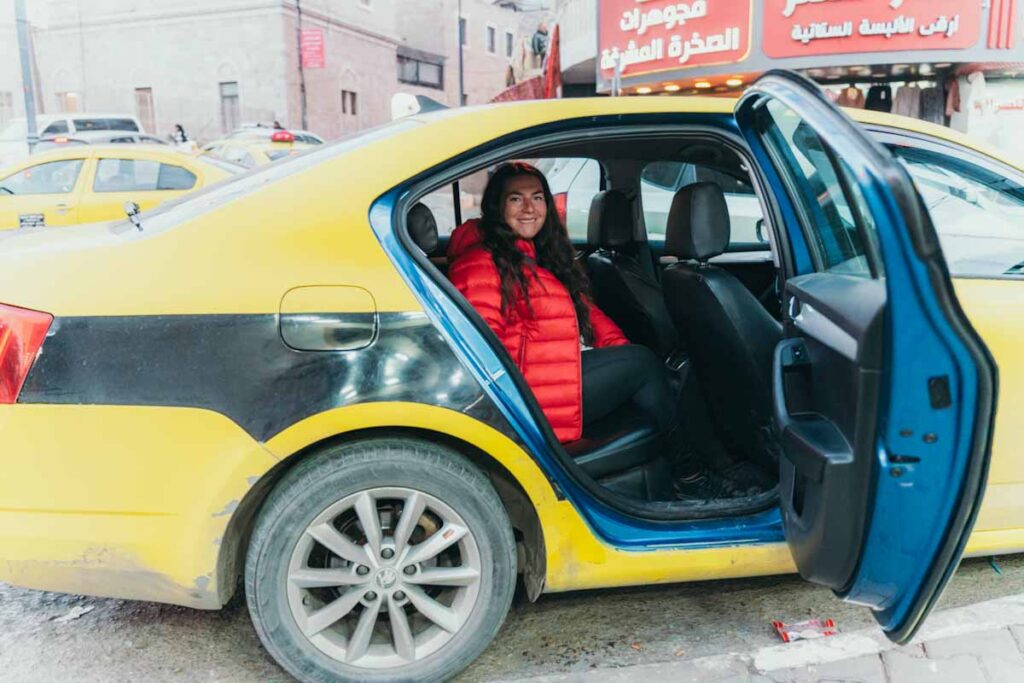
WHERE TO EAT IN BETHLEHEM
Afteem Restaurant
This restaurant is located on the corner opposite the Church of the Nativity. They serve delicious Masabacha, which is a warm hummus with whole chickpeas. It was also our go-to restaurant for falafel sandwiches. Very tasty.
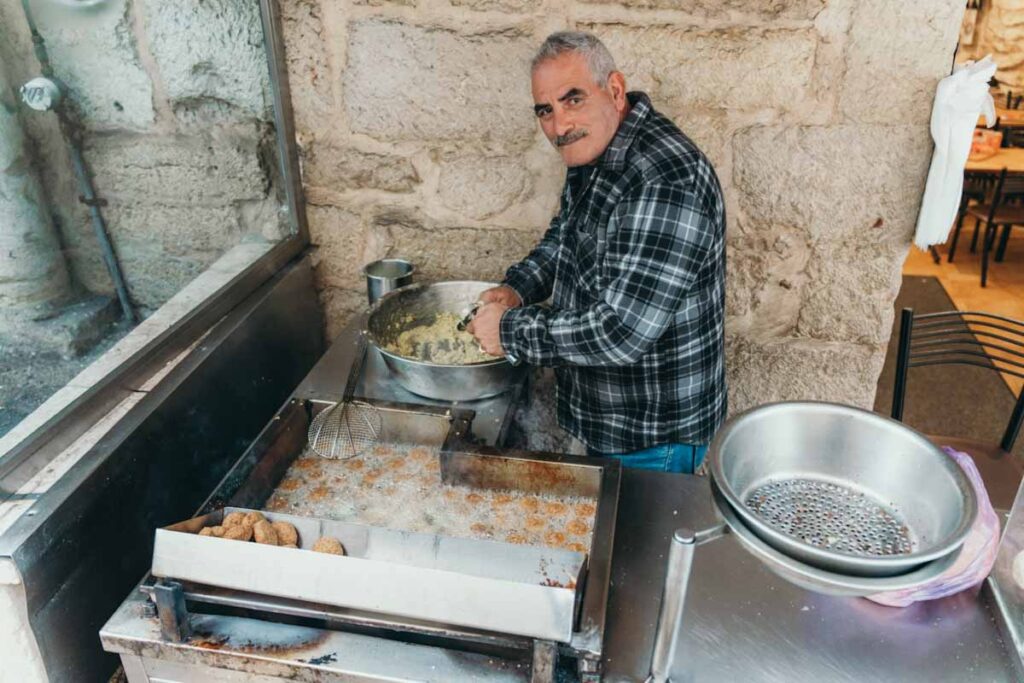
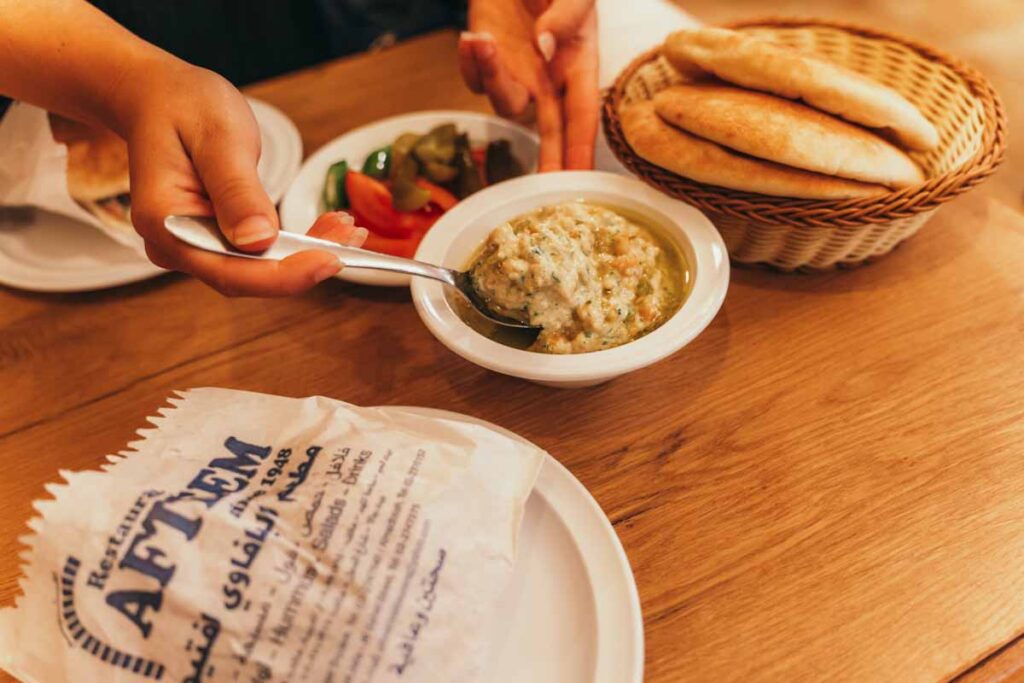
Stars Bucks
Located across Manger Sq, this cafe serves delicious coffee and snacks. Not talking about its name.
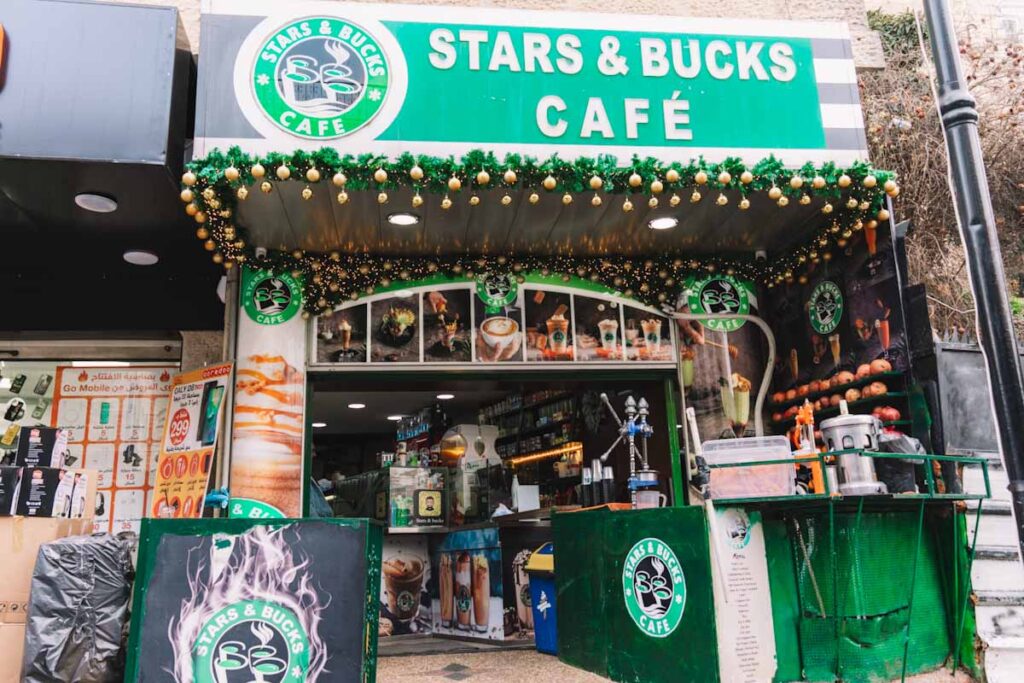
Coffee stalls on the square
You will see some coffee stalls on the square in front of the Church of the Nativity. Getting coffee, sitting on the bench and enjoying the atmosphere is worth it. Coffee costs only 1 ILS ($ 0.3) you won’t find cheaper.
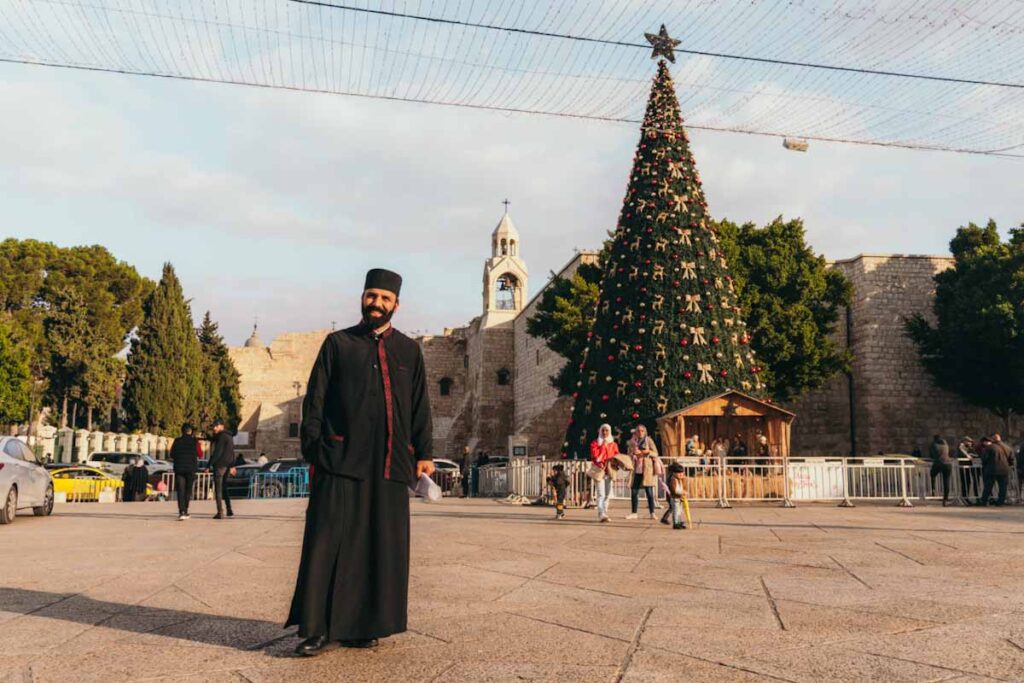
WHERE TO STAY IN BETHLEHEM
Dheisha Refugee Camp I Stay with a family in Dheisha refugee camp.
Walled Off Hotel I Stay here for the worst view in the world. This hotel is located right next to the Israeli’s separation wall.
DAY 4-5: HEBRON
Despite the fact that Hebron is the most problematic city in Palestine, it is a rich cultural and handicraft centre, and it is one of the most interesting places to visit in Palestine. What is the problem in Hebron? The city is divided into two areas H1: the area under Palestinian control, and H2: the area under Israeli control. And as if this is not enough, Jewish settlements are built within the old city. The city is divided by many checkpoints, and Palestinians can not walk on certain streets. The tension in this city is high, to say at least. You won’t meet many independent travellers here; we met only two other independent travellers; others came with a tour. The best thing to see in Hebron is visiting the Mosque and Cave of the Patriarchs, a holy place for Muslims and Jews and inside, it is separated by bulletproof glass.
Expect going through many checkpoints in Hebron, have your ID ready and be prepared for questions such as your nationality, why you are coming, and your religion. I already described it in the Checkpoints section.
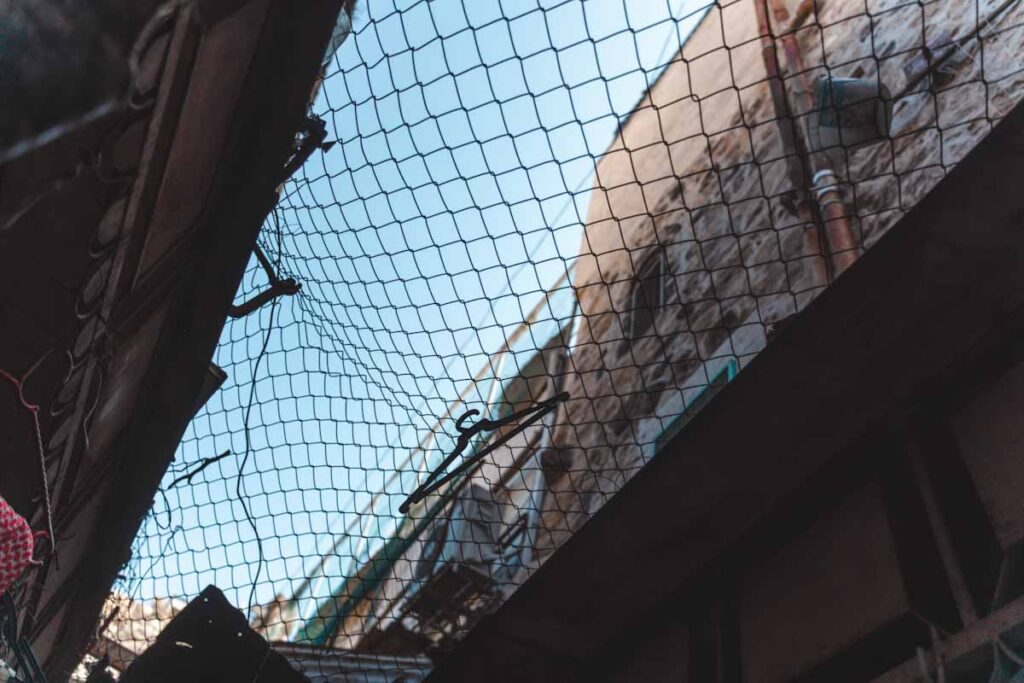
BEST THINGS TO SEE IN HEBRON
Area H1: Palestine territory: Market
The main place to visit is the market that used to be bustling with life once upon a time. Today, some shops are open, but it is just a short part. The market has a fence from above to protect people from Jewish settlers who throw trash and worse at Palestinians. You can still see lots of garbage, church and different items thrown at people and stuck in the fence.
Actually, the Friends hostel, where we stayed, is located inside this market and to get inside you go through one of the shops. You can buy clothes, fruit and vegetables in the market, especially lots of colourful pickled veggies and olives. Some art shops are open, and it was a pleasure to talk with some shop owners about the situation and their opinion about the future of Palestinians. You will see many barriers on sidewalks that Israelis have placed.
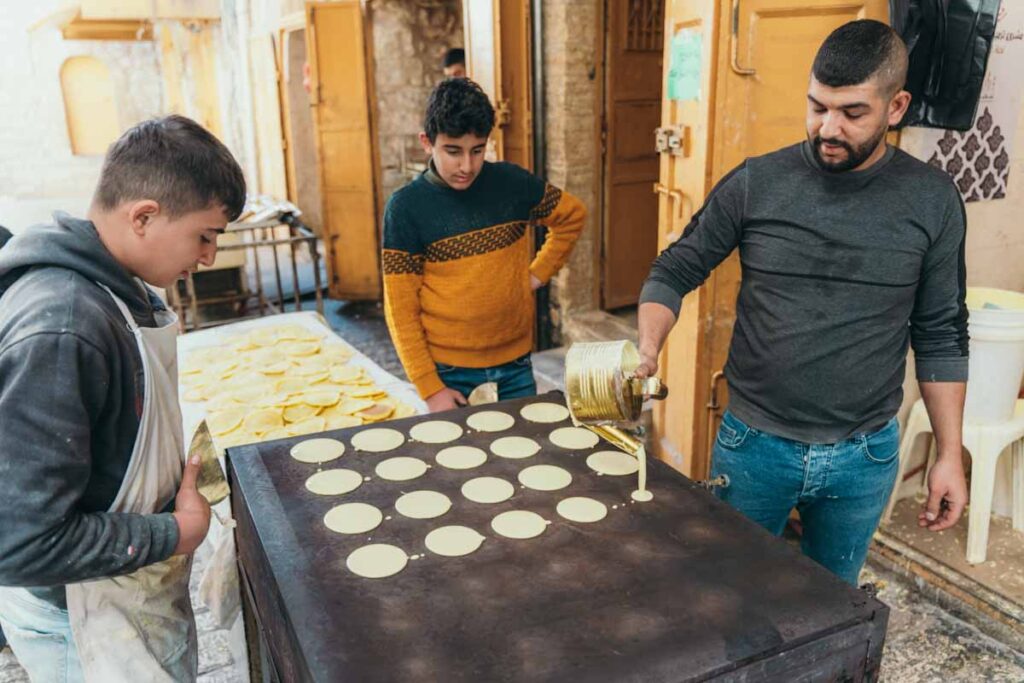
Tomb of the Patriarchs and Ibrahimi Mosque
An important holy place for both Muslims and Jews who believe here is the final resting place of Ibrahim. One building. Two separate entrances. Two checkpoints from each side to enter. The security and amount of military is insane. This must be one of the most controlled places in Palestine. We entered both sides and seeing two completely opposite worlds was interesting. In the middle of the building is placed the tomb, which is protected with bulletproof glass, as you literally see from the mosque to the synagogue.
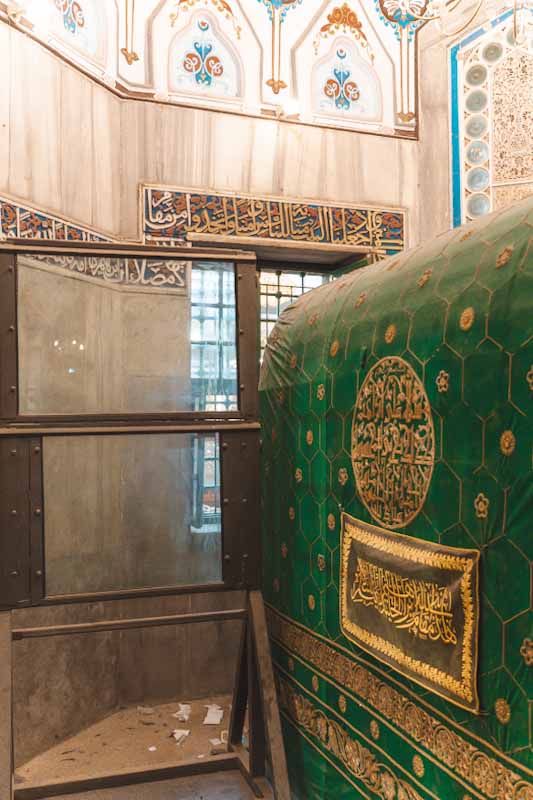
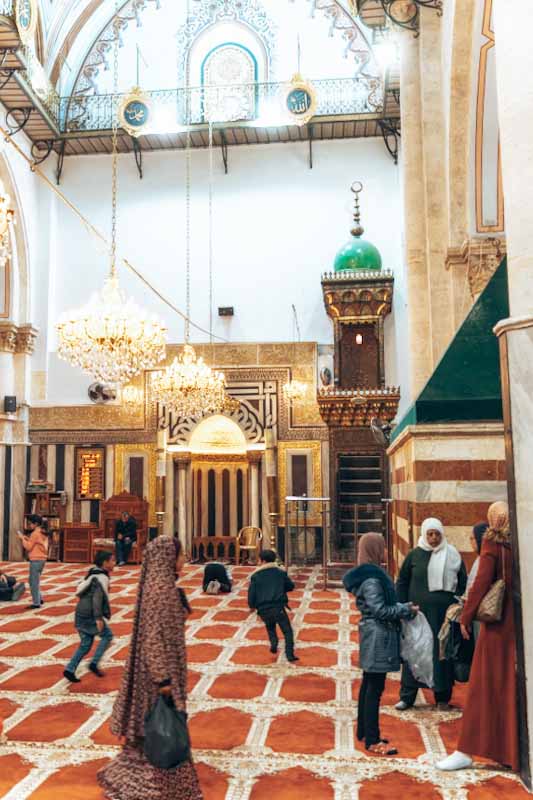
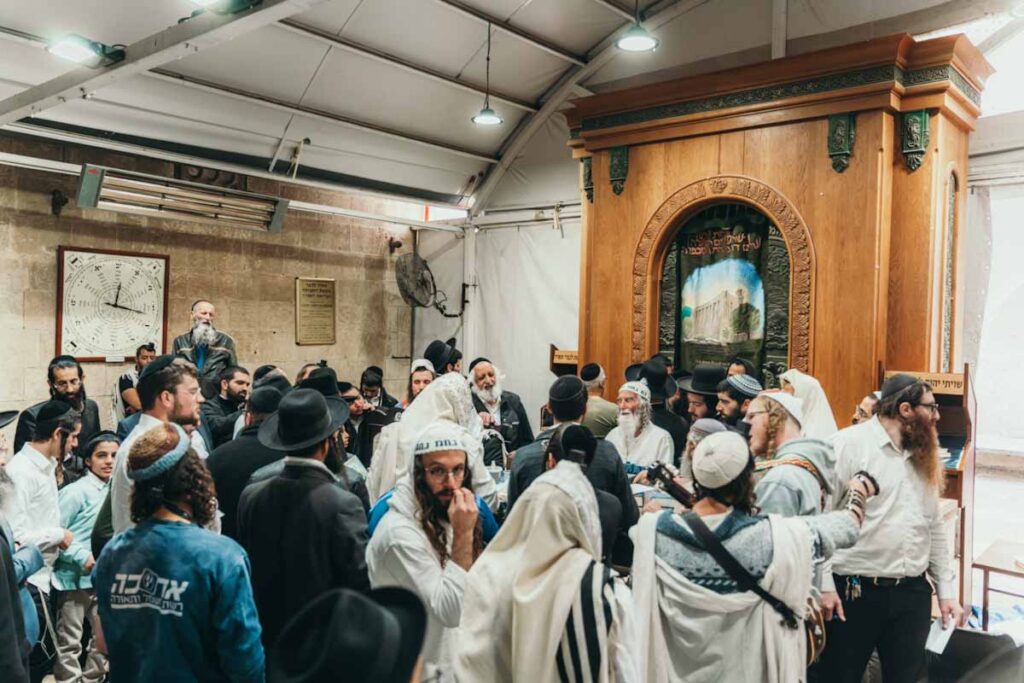
Area H2: Israeli Territory
From the Ibrahimi mosque, you can continue your way to Area H2, which is hugely protected by the Israeli military. We walked through the deserted city, and in a 1 km walk, we were stopped at least six times. They checked our ID and then let us go. You can see lots of military presence here, and deserted streets with tens of shops closed down.
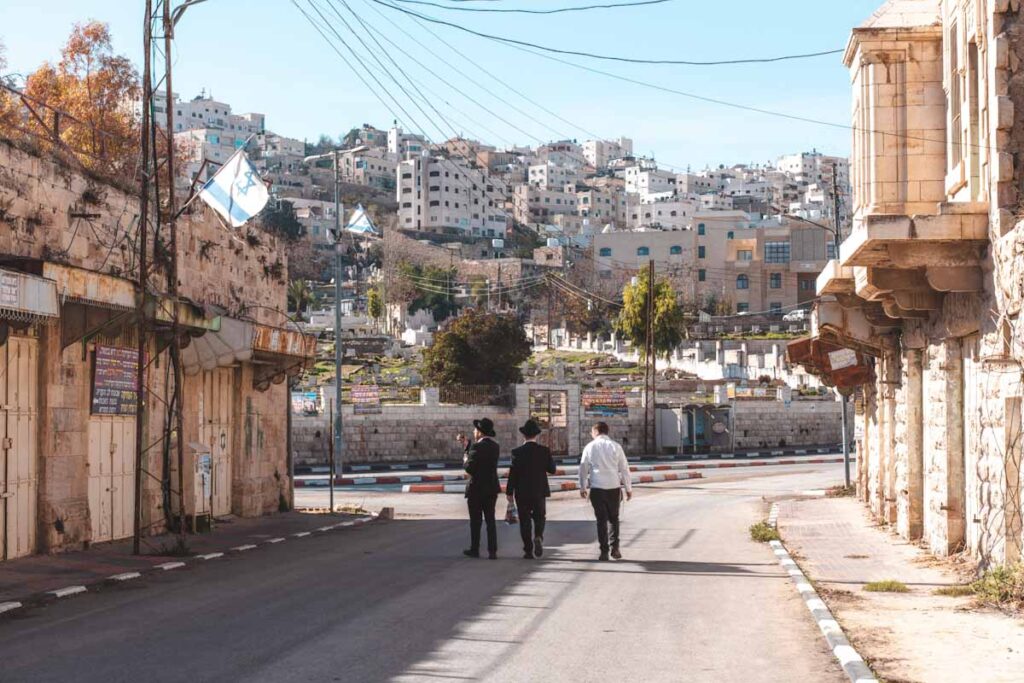
Herbawi Kuffiya factory
Everybody knows the Palestinian scarf; this factory is the first Kuffiya factory in Palestine. The entry is free; you can see how the scarf is made. There is also a little shop where you can buy a scarf. We bought ours there.

Glass Factory
Another souvenir we brought from Palestine is a Christmas decoration made in the Glass Factory. You can watch here how the glass is made, and there is a shop with hundreds of different glass products.
Sidr family
You can visit the Sidr family, one of many families living in the old town who was offered millions of $ to leave their house to make space for Jewish settlers. They refused. They welcome people from outside to come and talk about the situation. Read more in our separate post about Hebron.
Essential reading: The ultimate guide to visiting Hebron. The troubled city in Palestine. (Coming soon)
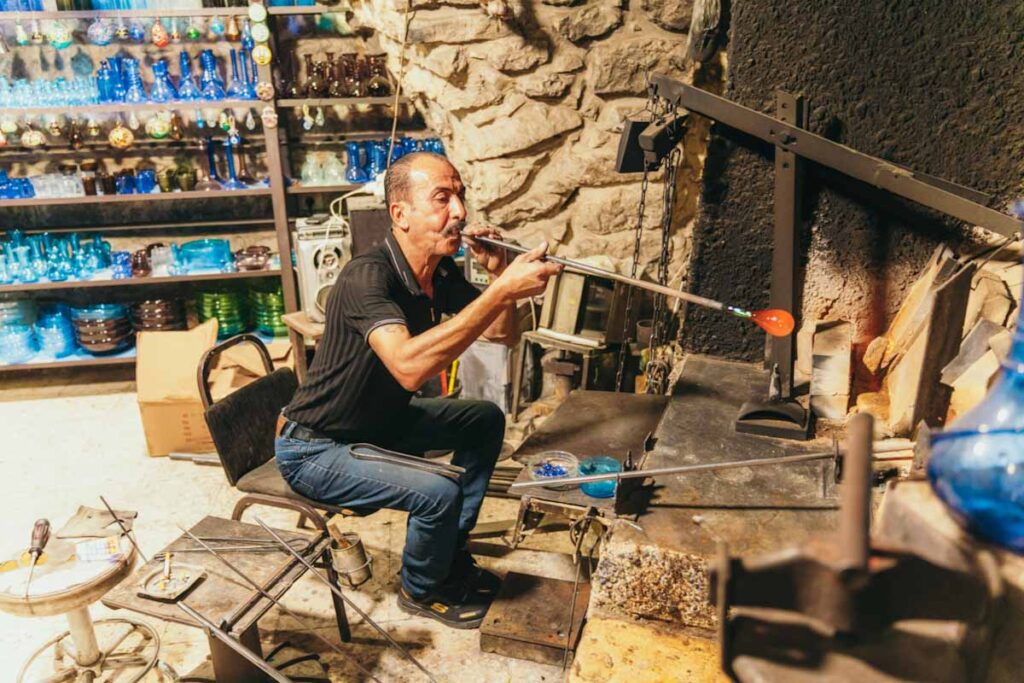
HOW TO GET TO HEBRON FROM BETHLEHEM
If you stayed with Ibrahim in the Dheisha Refugee camp in Bethlehem, just walk back to the main street and wait for the shared taxi van that goes directly to Hebron. It cost 10 ILS ($2.7); this is what we did. Otherwise, take a shared yellow and black taxi for 3 ILS, which takes you close to the Shepherd Hotel, which is the station for shared taxis. There, find the one that goes to Hebron.
HOW TO GET AROUND HEBRON
You can easily walk everywhere. Or catch a taxi.
WHERE TO EAT IN HEBRON
Who would guess that Hebron is the ultimate foodie destination? Everywhere you go, there is delicious food. A falafel sandwich typically costs around 4 ILS. Try also Palestinian chocolate; many stores in Hebron sell many kinds of small chocolate.
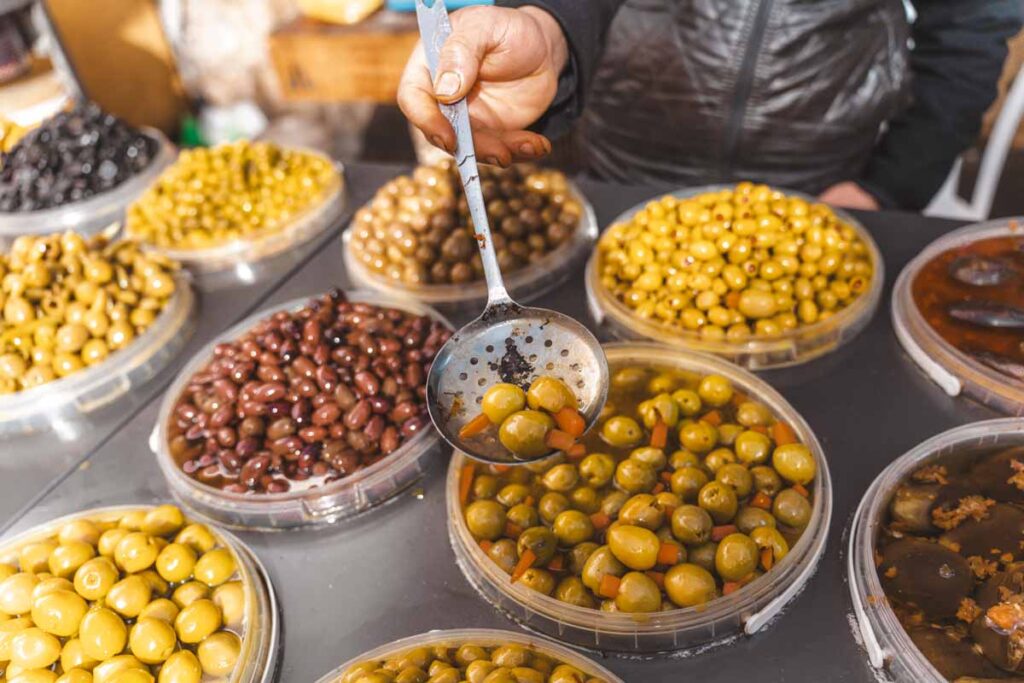
WHERE TO STAY IN HEBRON
Friends Hostel Area B I The best and most welcoming place to stay in Palestine. Akram really makes sure you feel well; his place is full of useful maps and recommendations on what to visit. He made sure he sat down for tea with us, let us ask as many questions about the situation in Hebron and Palestine as we wanted, and explained everything passionately. This hostel is located right in the centre so you can walk from here everywhere.
You can also stay in the refugee camp at Hebron Hope Guesthouse.
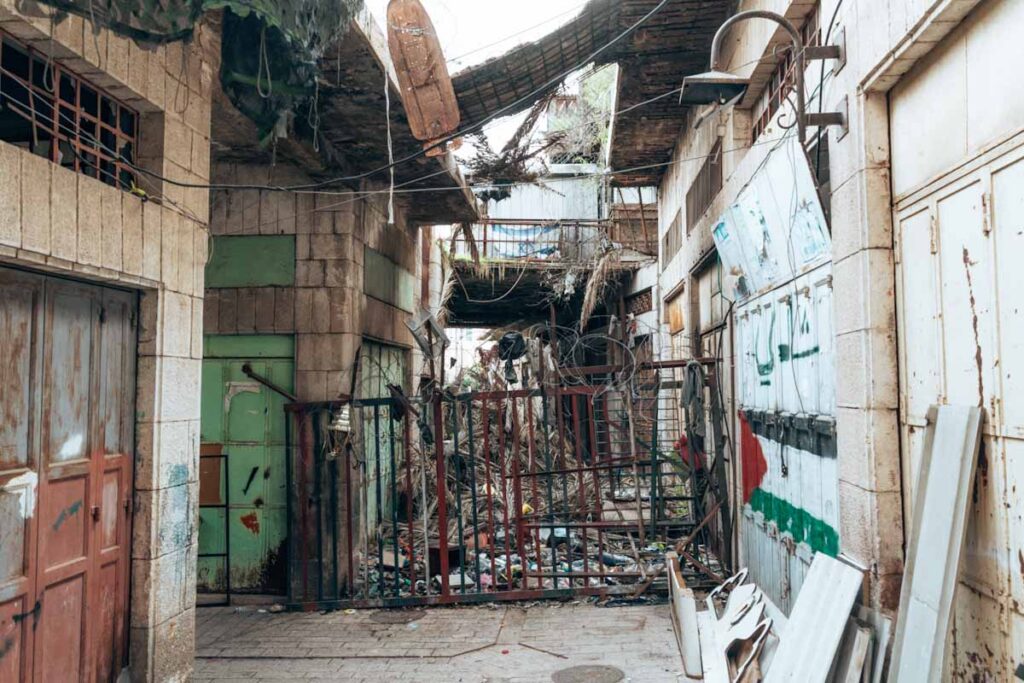
DAY 6-7: JERICHO
Jericho is one of the world’s oldest continuously inhabited cities and the hottest area in Palestine. Jericho doesn’t have the old historical centre. Still, it is the monasteries carved into mountains, archaeological sights and close proximity to the Dead Sea that make it an attractive destination for foreign and local tourists. Two days are sufficient for the places below; if you want to visit the Dead Sea, you need to add one more day. On day 1, we started exploring late at 1pm by visiting Hisham’s Palace, Mount of Temptation and Jericho City Centre. On day 2, we hiked to St. George Monastery and explored the Jericho city and refugee camp where we stayed. I can not forget to mention the people of Jericho, who are amongst the friendliest we have met in Palestine. Many times we were invited for a coffee and friendly chat.
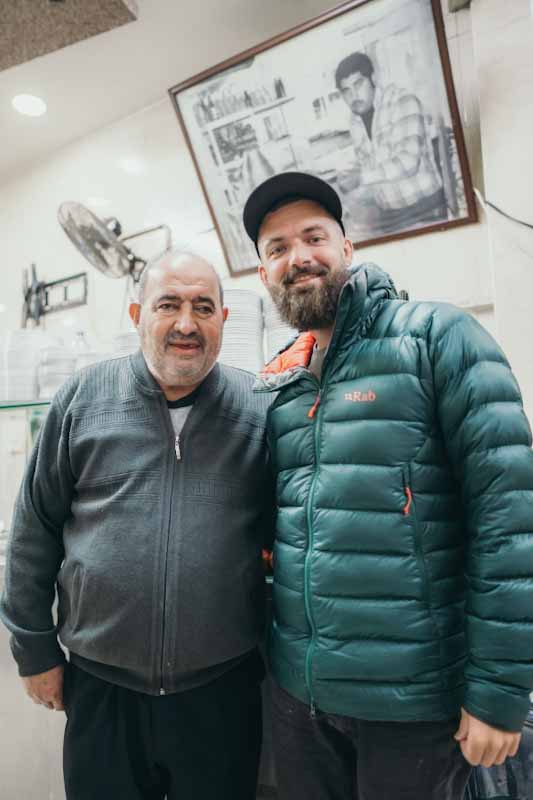
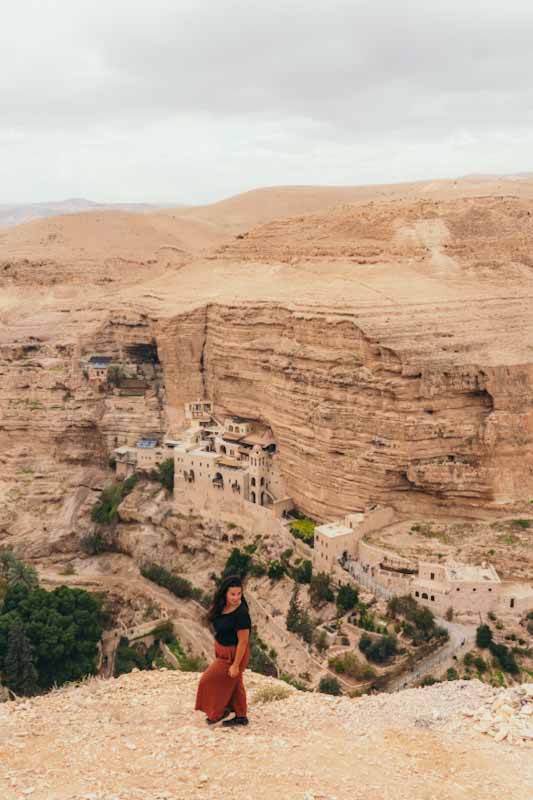
BEST THINGS TO SEE IN JERICHO
Hisham palace
We arrived in Jericho around 1pm, and the first thing we visited was Hisham’s Palace. We took a taxi for 10 ILS from the city centre. But you can walk, it would take around 40 minutes. After you get inside the area, watch the 10 minutes documentary explaining the history of Hisham Palace. It is an Islamic ruin with one of the most well-preserved mosaics. Search for the Tree of Life, the most famous mosaic in the palace.
- Opening times for Hisham Palace: 8am – 6pm
- Entry fee: 10 ILS
- Time: 45 minutes
How to get to Hishams palace
You can easily walk from the city centre to Hisham’s palace. It is roughly 3 km and 40 minutes on flat terrain through the city. Or take a taxi for 10 ILS ($2.7).
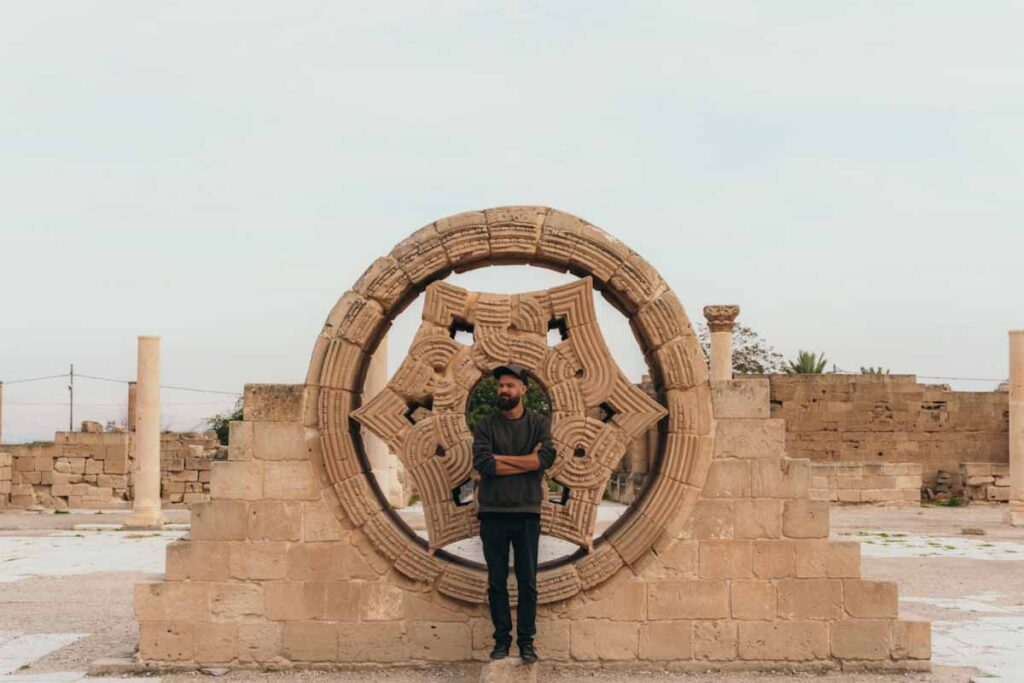
Mount of Temptation (Deir al Krntl)
This Monastery is carved high in the mountain into the cliff, which is totally impressive. I’d say one of the most beautiful sights in Palestine. Unfortunately, when we came, it was closed. It means they lock the gate, and you can not get inside. However, you can still have a nice view from the area around you and take a small hike that takes you under the Monastery, where you can see a lot of caves and the Monastery from below. The Monastery is built on the spot where Jesus resisted Satan after 40 days of fasting. You get amazing views over the Dead Sea and the agricultural area of Jericho.
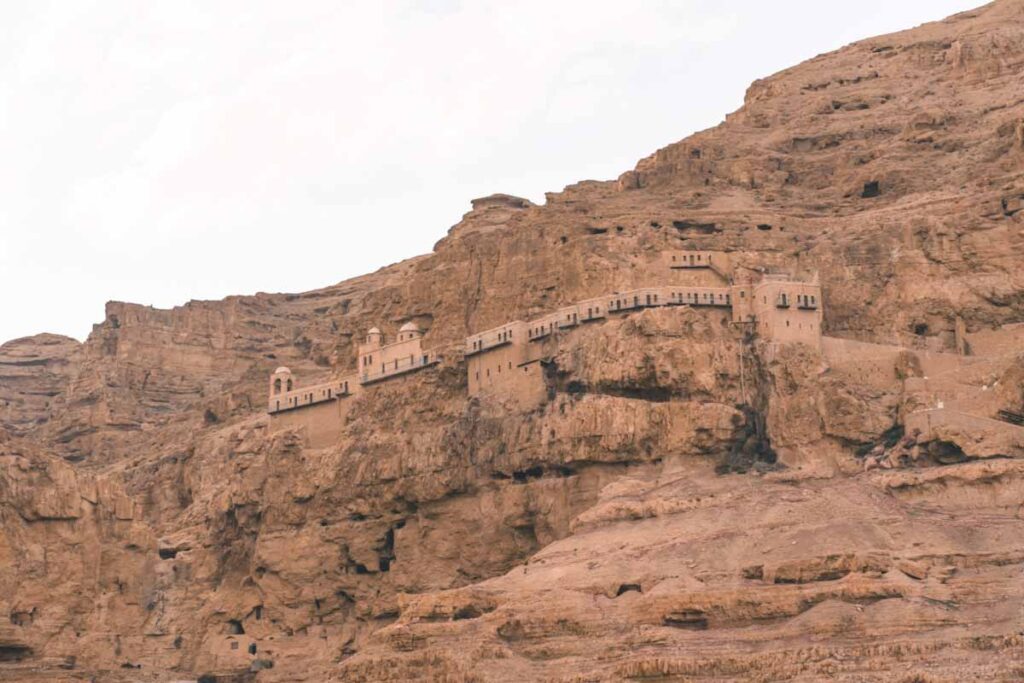
How to get to Mount of Temptation
From Hisham’s Palace, it makes sense to head to the Mount of Temptation, as it’s in the same area, only 4.5 km away. It’s the Monastery carved into the rock on the opposite hill. We took a taxi for 15 ILS to reach the bottom of the Mount of Temptation. It takes 15 minutes to hike on the gravel path to reach the top. It’s a pretty easy short hike; you see the Monastery right above you all the time. If you go from the city centre, just take a taxi for the same price.
After we were done exploring, we hiked down the mountain back to the road and saw a shared taxi coming. We asked the driver if he went into the centre and he pointed that we can jump in. So we did. We showed him where we wanted to go – to the Jericho centre, and he dropped us off there for 3 ILS. Otherwise, you can walk back to the main road and catch any shared or private taxis passing by.
Another option to reach the Mount of Temptation is to go by cable car, which costs 60 ILS. A big restaurant is on the top where the cable car stops, just a few metres from the entrance.
- Opening times: Mo, Tu, We, Th, Sat: 9-15:30, Sun: 10-15, Friday: Closed
- Entry fee: free
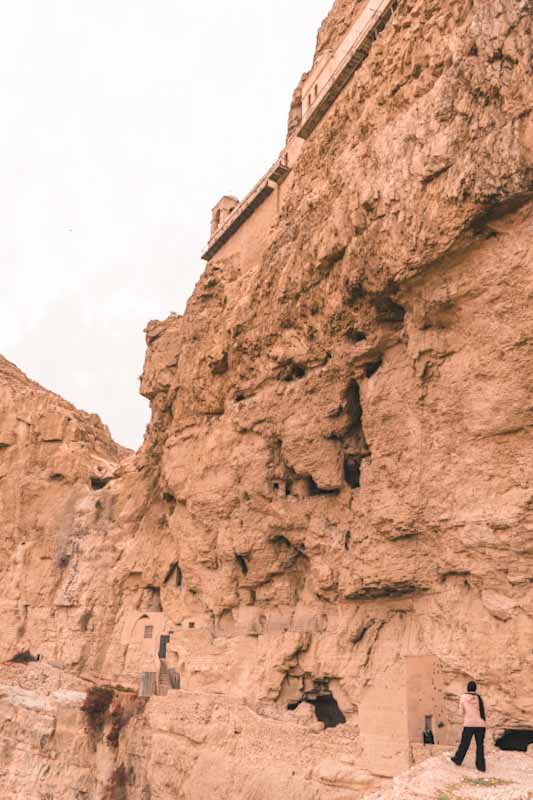
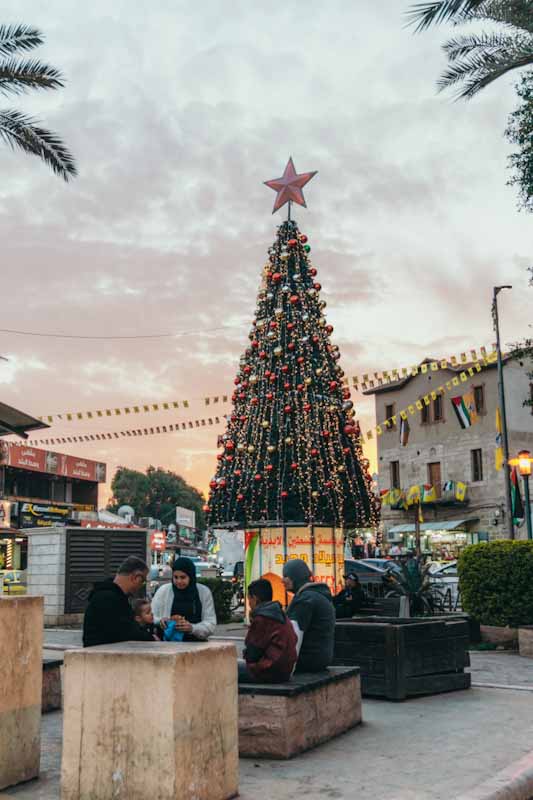
St. George Monastery
Another monastery carved into the cliff. You get a fantastic view from the upper viewpoint. Be prepared for many locals pushing you to take a donkey ride down to the Monastery. Apparently, beautiful paintings are inside the chapel, and you can see parts of the original mosaic floors.
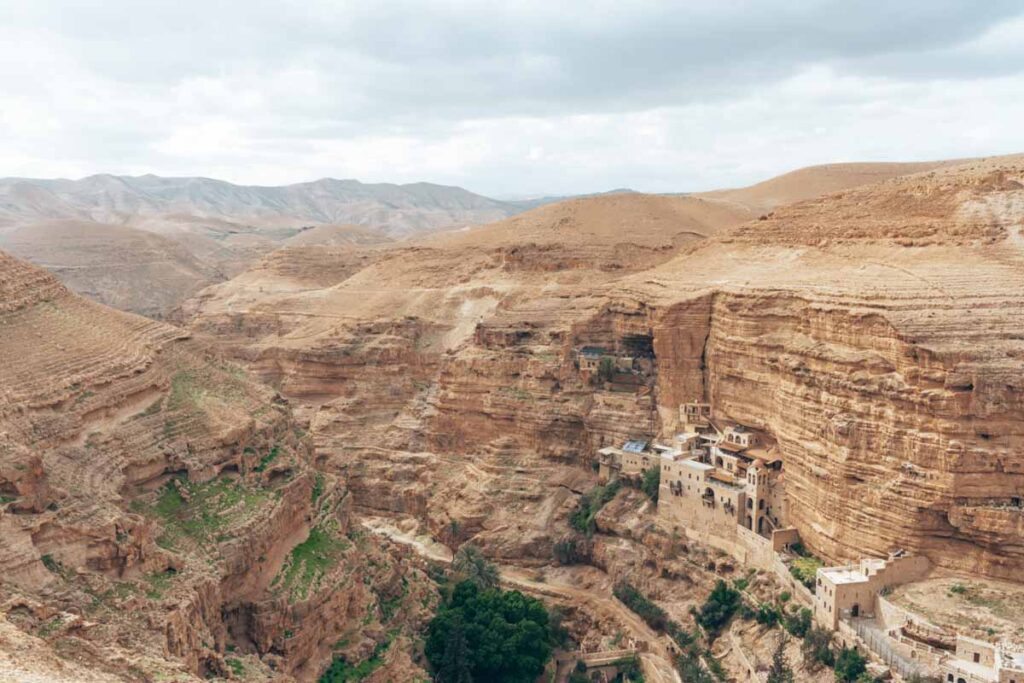
How to get to St. George Monastery from Jericho
Reaching the Monastery is straightforward. From Jericho city centre, it’s 6 km to reach the Monastery. You should open Maps.me while reading this description, as it will be easier to understand. From the city centre (Mount 41 hostel), walk or take a taxi to Wadi Al Qelt hostel – it’s 2,5 km through the city and along the road.
When we walked this way, after the roundabout towards the Wadi Al Qelt Hostel, the car with two friendly locals stopped and offered us a ride for free to the Monastery. Which was super nice, so you can also try to hitchhike; locals in Jericho are very friendly.
Ok, if this won’t be your case, the way is following. There are two ways from Wadi Al Qelt Hostel. The first one is to follow the road for cars, which will take you to the Monastery. It’s a steep uphill road. This way, you turn up at the Monastery’s viewpoint (the most beautiful one). You can also take a taxi from Jericho centre to this viewpoint; when we asked around, the lowest price was 10 ILS per person. To reach the Monastery, you just walk from the viewpoint down the steep road; it takes maybe 10-15 minutes.
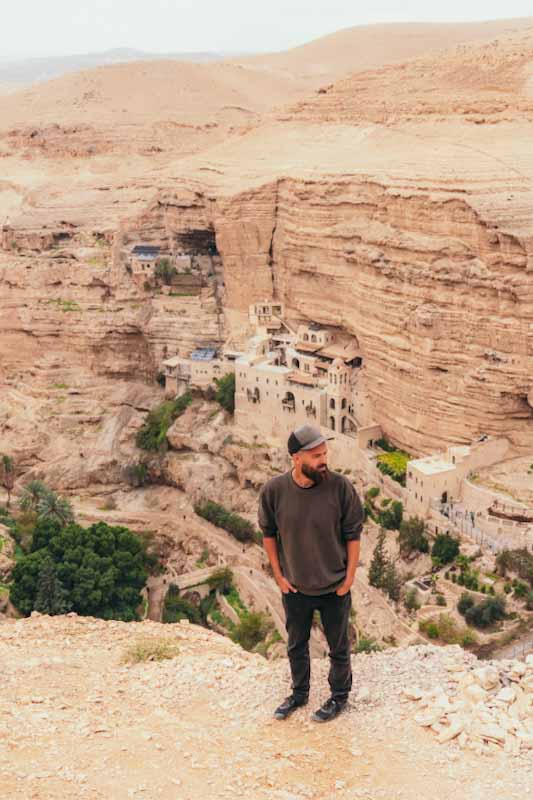
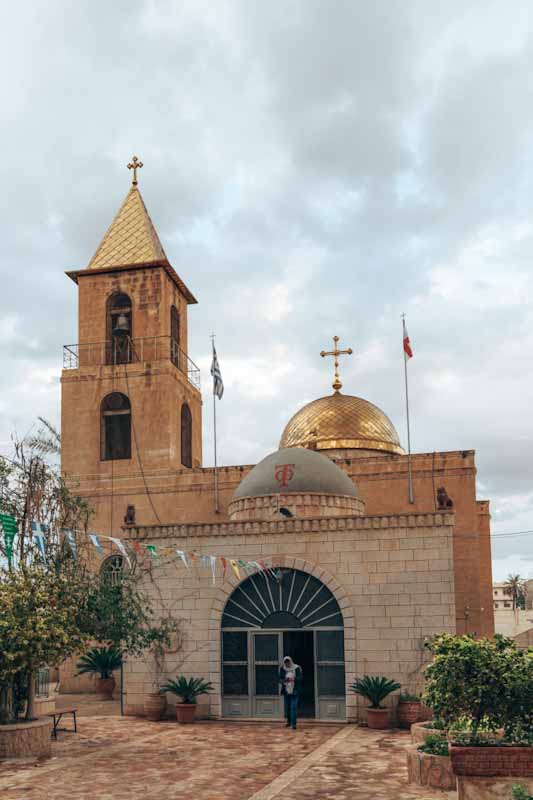
Second option: Little bit before Wadi Al Qelt hostel, there is a brown sign on your right that says ,,Herod’s Palace”. Turn right. After you cross the bridge, turn left and follow blue or red signs that will take you through the valley, through the beautiful scenery to the Monastery. It takes roughly 1 hour and 15 minutes through this hiking trail. The first part is uphill, and the rest is more or less flat. This way, you will appear directly by the Monastery. To get to the viewpoint, it’s a very steep hill.
Therefore we recommend you go the other way around (like we did). Walk along the road for cars to get to the top viewpoint (or take a taxi), then check the viewpoint and hike down to the Monastery to explore. After you’re done, walk back to the city through the hiking trail. Btw, the hike through the valley was wonderful; we enjoyed the scenery very much and met many marmots. Bear in mind that this hike goes through the valley, and we were the only people on the trail. It’s a hiking trail, and only a few people actually do it. However, we enjoyed the views, and the valley was stunning. After the hike, we returned to the road close to Wadi Al Qelt hostel by the brown sign described above. From here, it is roughly 2,5km back to the centre. We took a taxi for 15 ILS.
- Opening times of St. George Monastery: 9-13, but when we arrived at 12:20, they had already closed
- Entry fee: Free
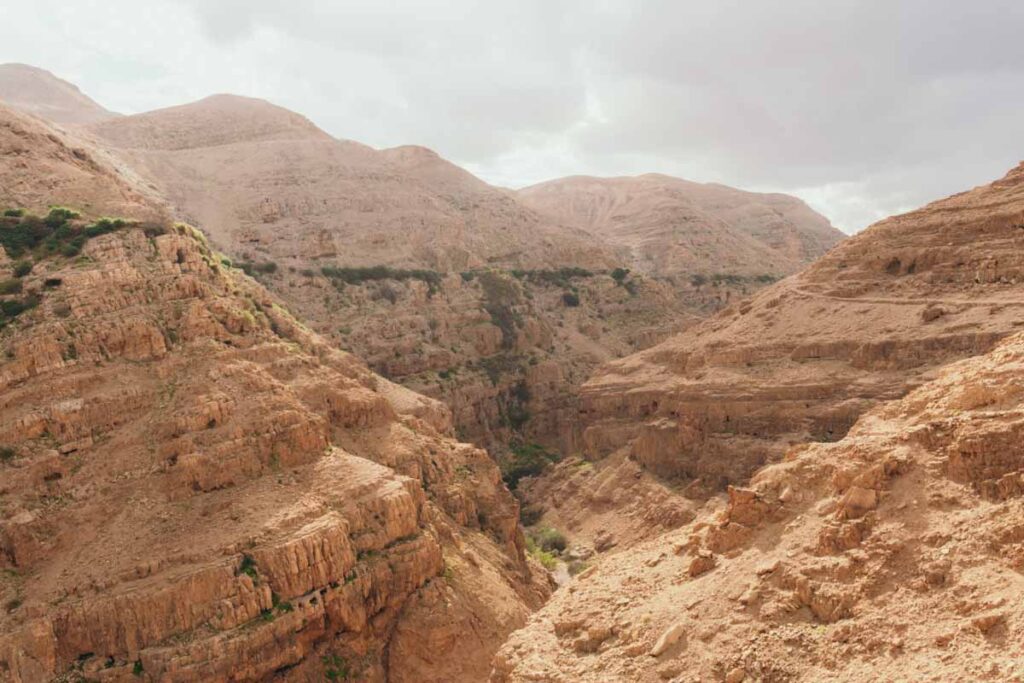
HOW TO GET TO JERICHO FROM HEBRON
Take a shared taxi from this location. You can also find shared taxis to Ramallah and other locations from here.
We took a direct shared taxi to Jericho for 30 ILS. The ride took 1 hour and a half. Be careful; some taxi drivers are very sneaky and wanted us to go to the wrong location just to get money from us. Luckily other taxi drivers teamed up and took us to the right car to Jericho. The second option is to take a shared taxi to Al-Eizariya (20 ILS) and change there for another shared taxi to Jericho (10 ILS).
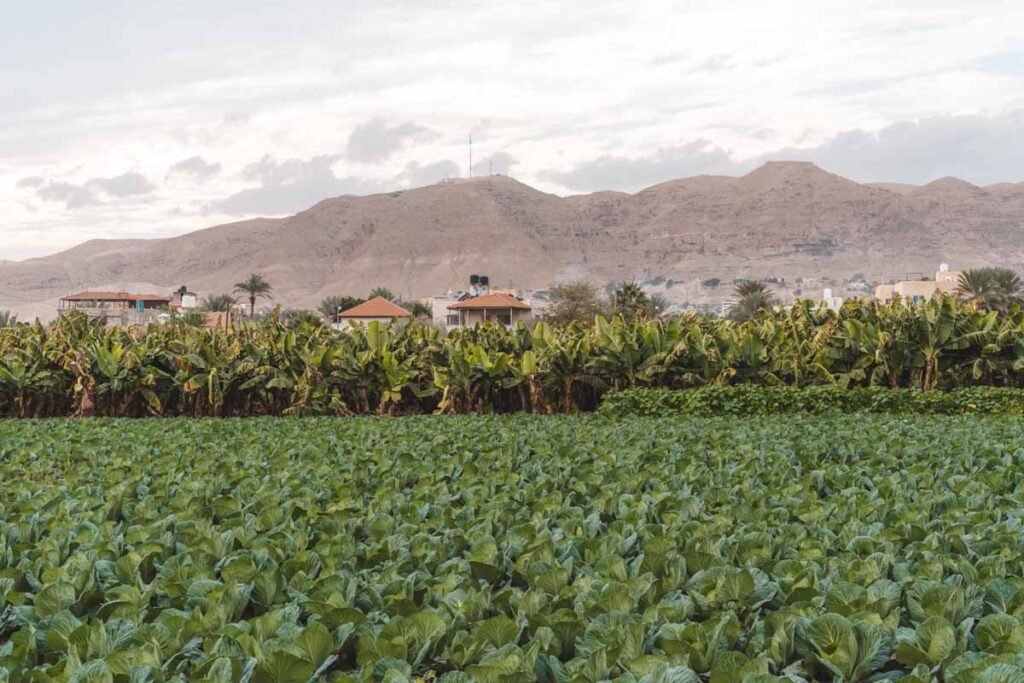
HOW TO GET AROUND JERICHO
If you stay in Jericho refugee camp, like us, reaching the city centre is around 3 km. The good thing is a shared taxi stops in front of the Sami Hostel, where we stayed and for 3 ILS goes to Jericho centre. This shared taxi runs very often, so it is not a problem. Once in the centre, you can easily walk almost everywhere.
Prices of shared taxis in Jericho
- Jericho Centre – Hisham Palace: 10 ILS
- Jericho Centre – Mount Temptation: 20 ILS
- Jericho Centre – St. George Monastery: 15 ILS
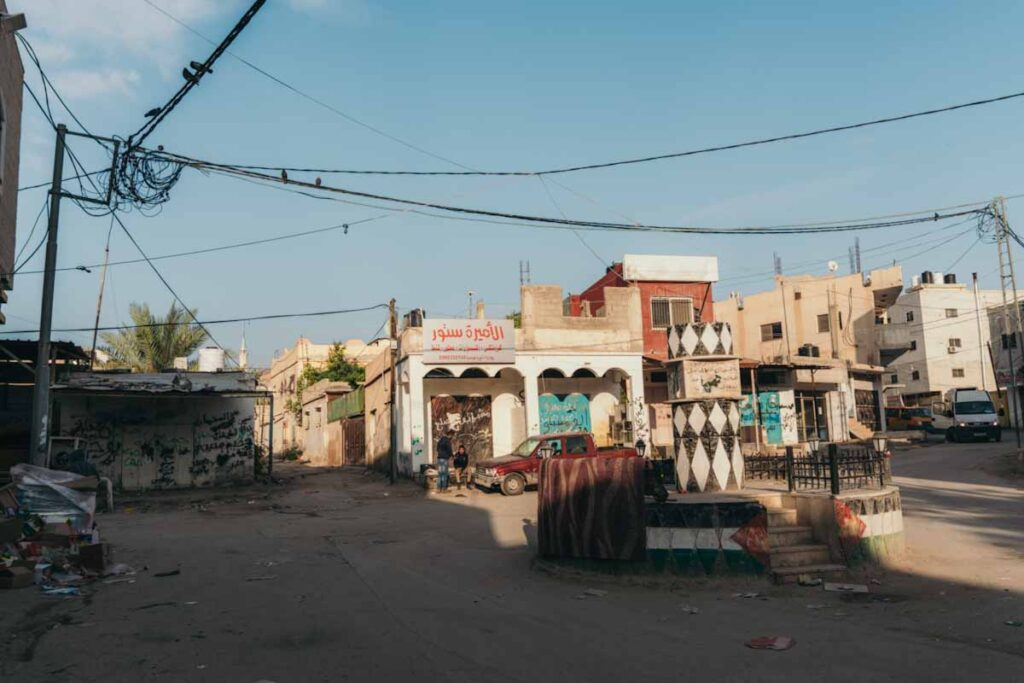
WHERE TO EAT IN JERICHO
Restaurants in the city centre (roundabout by Mount 41 hostel) are very overpriced and cheat customers by serving small portions. If you go a bit further away, you’ll find good local eateries.
Abu Feras restaurant – our favourite place to go. Falafel or hummus 5 ILS. They also have shawarma, Palestinian food (rice, small dishes and chicken) and more. It’s across the Bank of Palestine in this location.
مخبزومعجناتالشام– if you want a change from all the typical Middle Eastern food, head to this bakery, as this bustling place serves the best pastries we had in a while. Pizzas, different kinds of filled pastries. Super yummy. Prices range from 3-10 ILS.
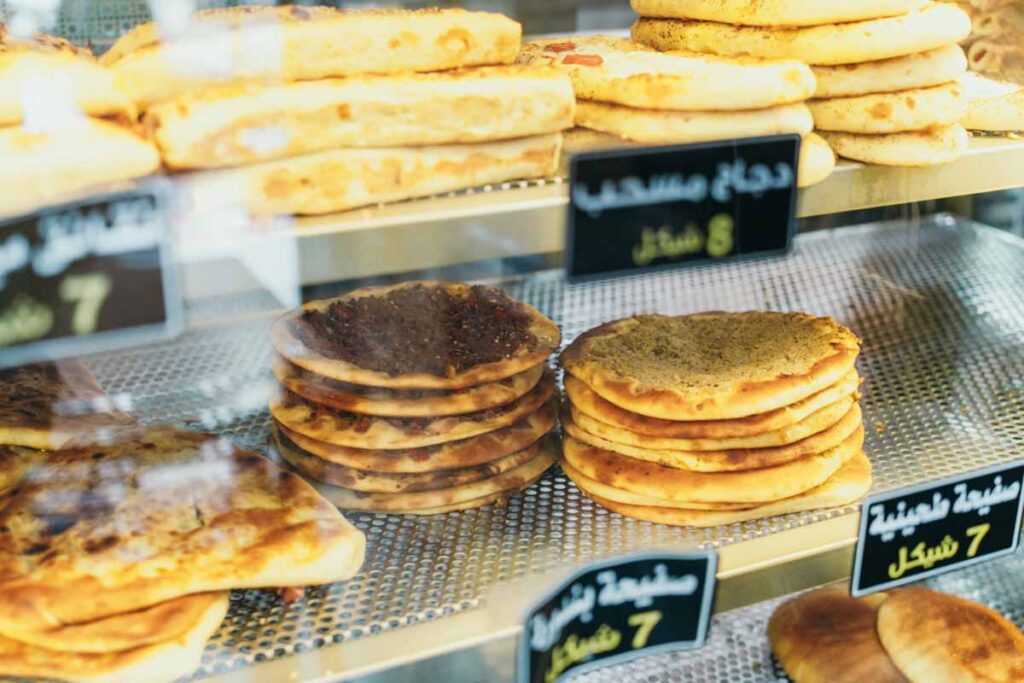
WHERE TO STAY IN JERICHO
Jericho has not many budget options. However, depending on your preferences and budget, you can easily find a place to stay. You can stay in the city centre or a refugee camp. We recommend you stay in the camps as they are a big part of Palestine, and everyone should experience the reality.
Budget I Sami hostel – the backpacker’s option in Jericho; this hostel is located in a refugee camp, that’s why we decided to stay there. The owner is friendly and helpful. It’s located 3 km away from the city centre however there are restaurants and stores right in front of the hostel. A shared taxi (3 ILS, 15 min) runs all the time between the centre and Sami, and they stop right in front of the hostel, which is super convenient. You can see life in the Palestinian camp, which was the first one built in Palestine. The area is safe to walk even after dark. You can book dorms online, but double rooms are available too, and the owner will most likely upgrade you. Also, it is a great option to talk to people about life in a refugee camp, the current situation and their opinions. A private double room costs 120 ILS ($33).
Want to stay in refugee camps in Palestine? Read our experience here.
Mid-Range I Mount 41 – if you don’t want to stay away from the centre, the best option is to stay in hostel Mount 41, which has the best central location in the city. However, there are only dorms.
Mid-Range I Auberg-Inn Guesthouse – another popular option amongst travellers. It’s close to the Mount of Temptation, the rooms are big, and the place is clean.
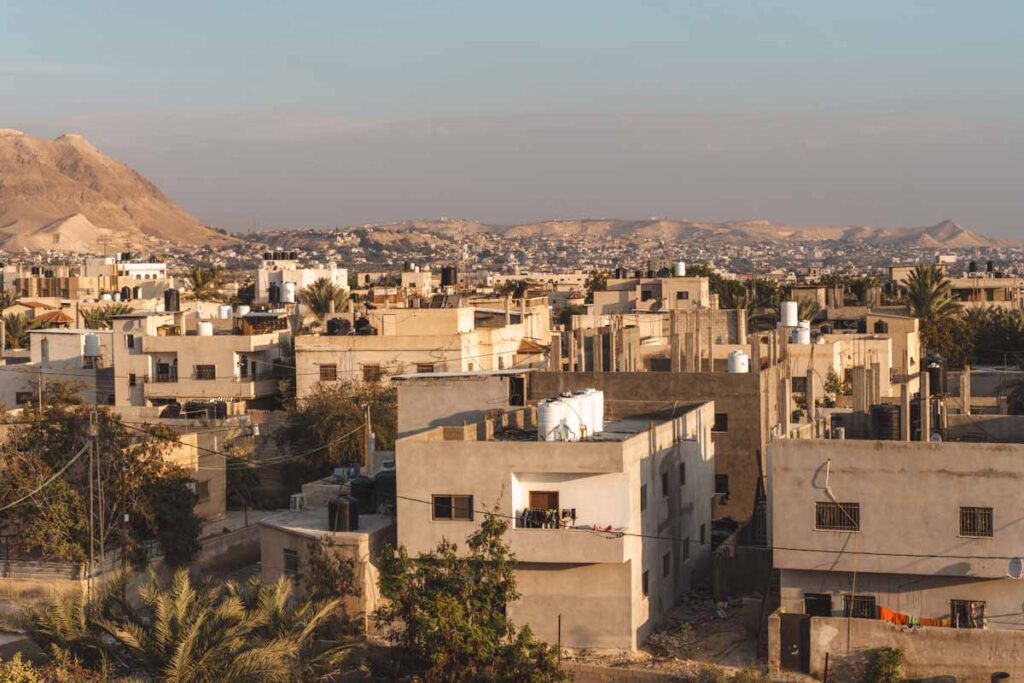
DAY 8: RAMALLAH
Honestly, Ramallah was a bit disappointing as we felt like not much was going on here. We enjoyed the Christmas decorations around the cosmopolitan city and the good Palestinian pizza in local bakeries. But also the famous local ice cream you can taste at Rukab’s Ice Cream.
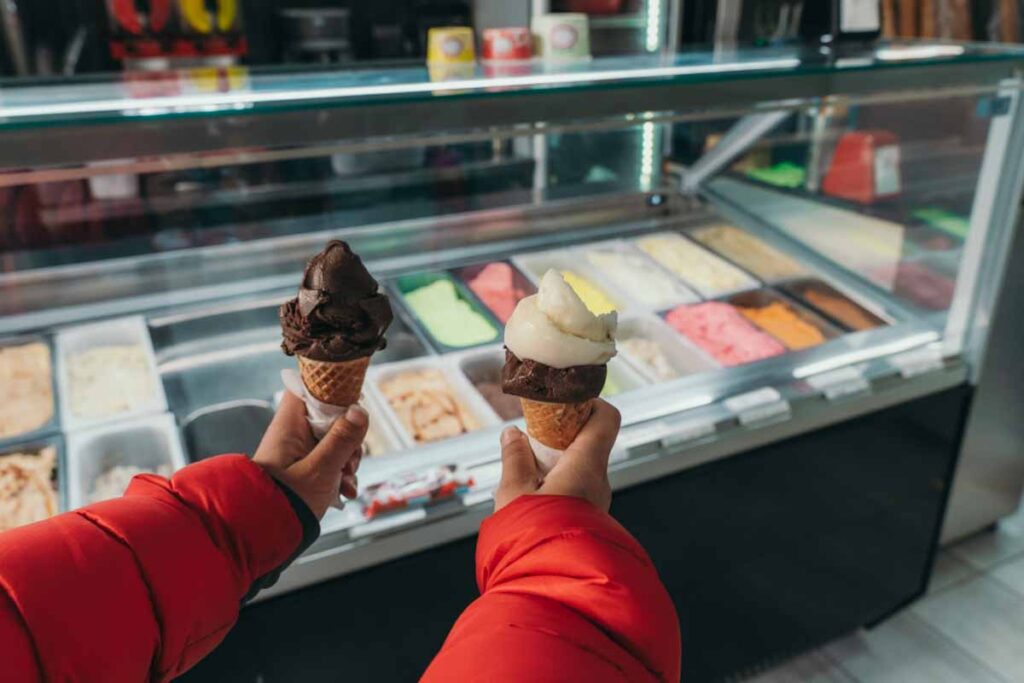
BEST THINGS TO SEE IN RAMALLAH
Yasser Arafat Museum
As the name suggests, this museum is dedicated to the life of Yasser Arafat. In my opinion, the museum is made in quite a chaotic way, and if you’re not familiar with Yasser Arafat’s actions, it might be a bit confusing. A whole section in the museum shows the life of Yasser under the Israeli Siege during the years 2001 and 2004. The first thing you see when entering the area is the Mausoleum. However, these days, it is not guarded by soldiers anymore.
- Opening times of Yasser Arafat Museum: 10am – 6pm
- Entry fee: 5 ILS ($1.4)
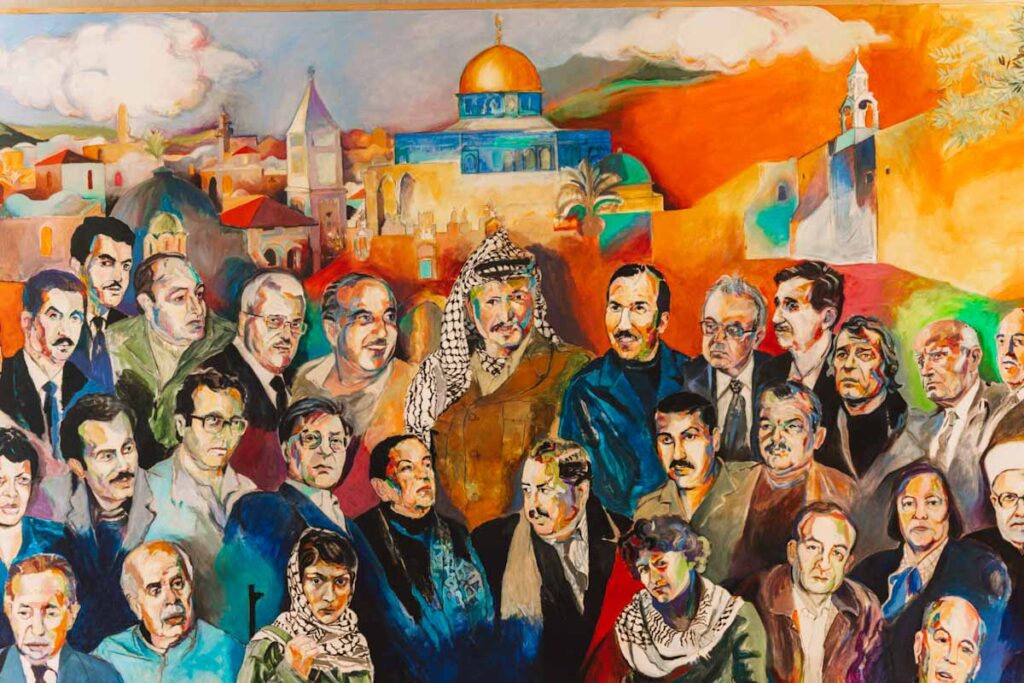
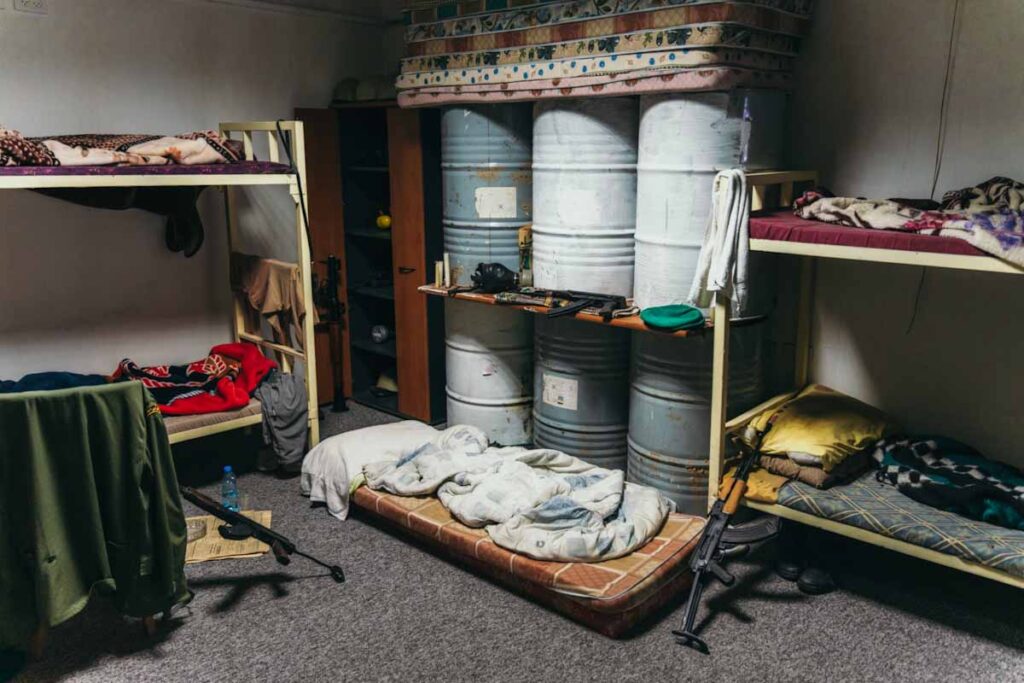
Taybeh Beer Brewery
We wanted to visit the beer brewery in Taybeh, so we went to parking lot where buses to Taybeh goes. We entered the bus and waited half an hour for the bus to fill up, but no one showed up. We used Google Translate, and the driver said it could sometimes take even a few hours. We searched for a shared taxi instead, which was right on the road next to this parking lot. We were the first ones in the taxi, another two ladies joined, and then we waited another half an hour, and no one showed up. We gave up as we thought getting back might be even more problematic.
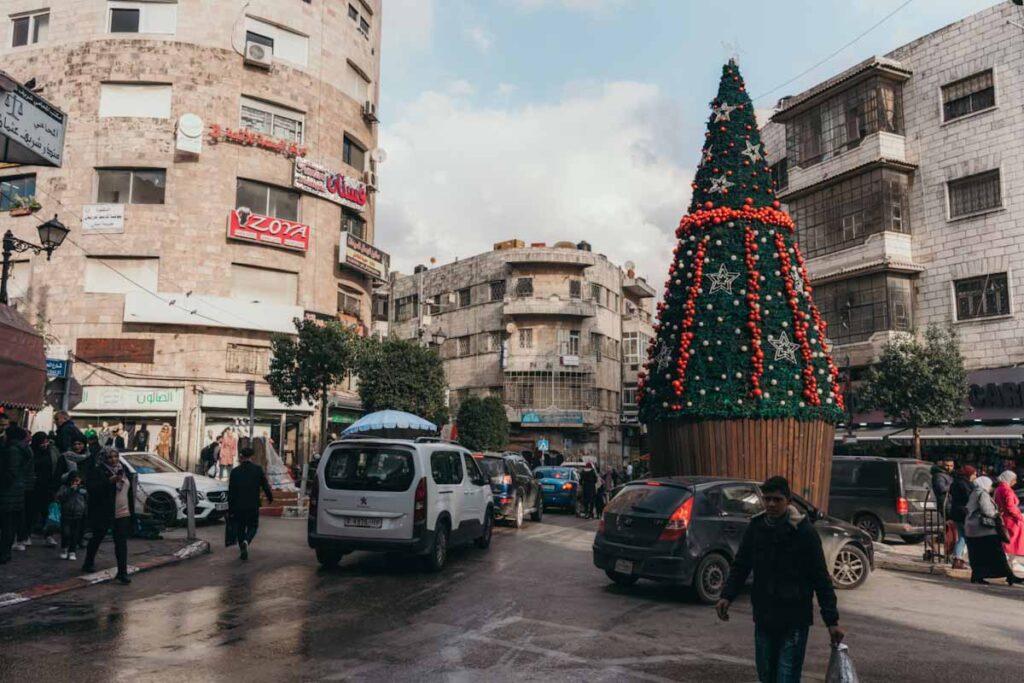
HOW TO GET TO RAMALLAH FROM JERICHO
Take a shared taxi that has a station in the centre opposite the Mount 41 hostel in Jericho. They charge 18 ILS.
How to get around Ramallah or to other cities
Ramallah is very confusing with the shared taxis system as there are many stations from where the shared taxis or buses leave, The best is always to talk to local people, and they will show you where to go.
WHERE TO STAY IN RAMALLAH
Eco Hostel Ramallah is a place where travellers meet in Ramallah and also volunteer. The German guy checked us into the hostel earlier than check-in time, which we appreciated. We stayed in shared dorms for 75 ILS ($20) per person, which is quite a lot in our opinion; it was the most expensive accommodation we had in Palestine. The place is very clean; you can use the kitchen, fast Wi-Fi, free water and a coffee & tea station.
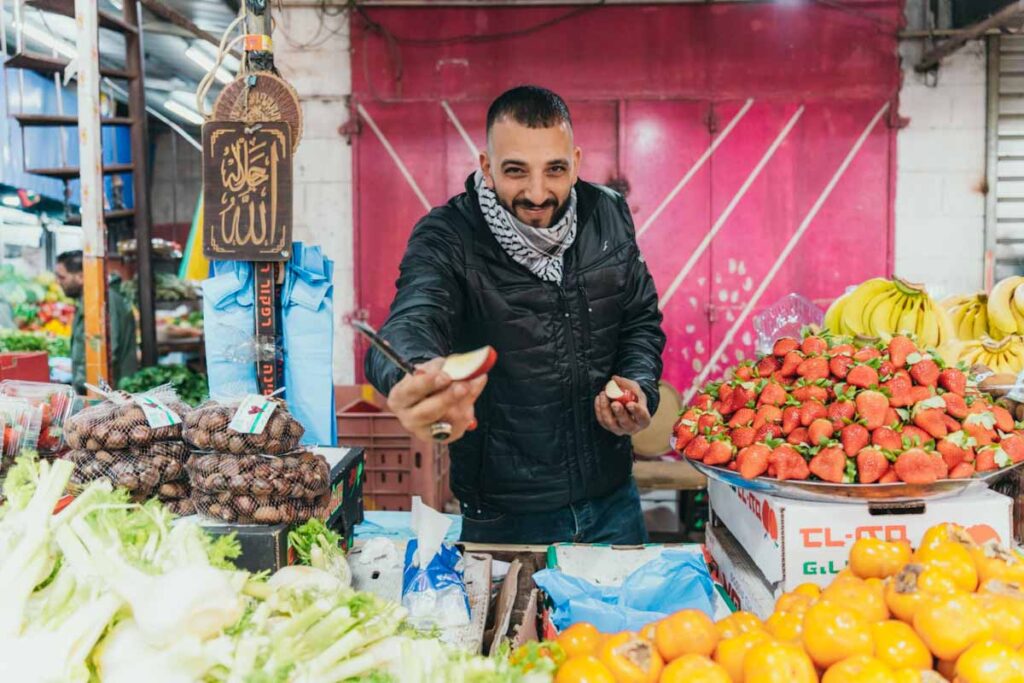
DAY 9-10: NABLUS
Nablus surprised us with its beautiful atmosphere and old city, where we felt like being back in Tripoli in Lebanon. It is a conservative and authentic city that does not attract many foreigners. At the time of our visit, a new terrorist group was forming with the aim of fighting the Israeli forces. The area from Nablus towards the north is quite sensitive, and during our stay, we were informed by our hotel not to go outside after sunset. The whole old city and market shut down before 5pm, which is when we should go back to the hotel. One evening, around 5pm, we were already chilling when we heard gunshots right in front of our window. Hundreds of people of this Nablus group with guns went into the streets and shot into the air. That day, we saw a small boy holding a huge gun and casually walking around the market. Even though it sounds dangerous place to be, this group aim to protect Palestinians, and you, as a tourist, have nothing to fear about. However, if the bullets are in the air, they must also go down; so it is better to be inside your hostel in the evenings.
That night, there were big riots close to Jacob’s Tomb as Jews, and the Israeli army, which protected them, came to pray at this holy site. There was shooting, fire on the streets and fights until late that night. In the hostel, we met US journalists who were preparing to go there to film and make a report on this.
People in Nablus are suspicious of foreigners at first, so they checked on us many times, asking where we are from, if we are journalists, and why we came. After we explained we were just tourists, they relaxed and were very nice to us. Actually, Nablus is a place where we would like to return one day.
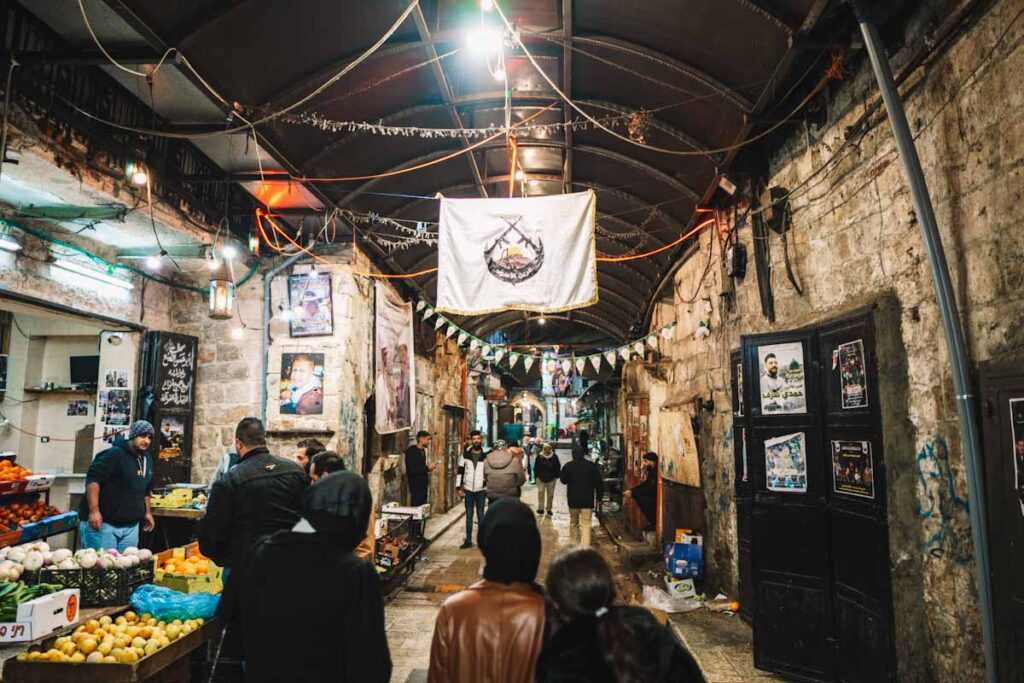
BEST THINGS TO SEE IN NABLUS
Traditional souq
This souq had many shops with traditional products and crafts, where the recipe is passed from generation to generation: Halva, sweets, honey. There is even a store with a crocodile and snake skin that the owner brought from India. The whole market and old city are covered with posters and flags of the activist group, showing martyrs killed in fights with Israel.
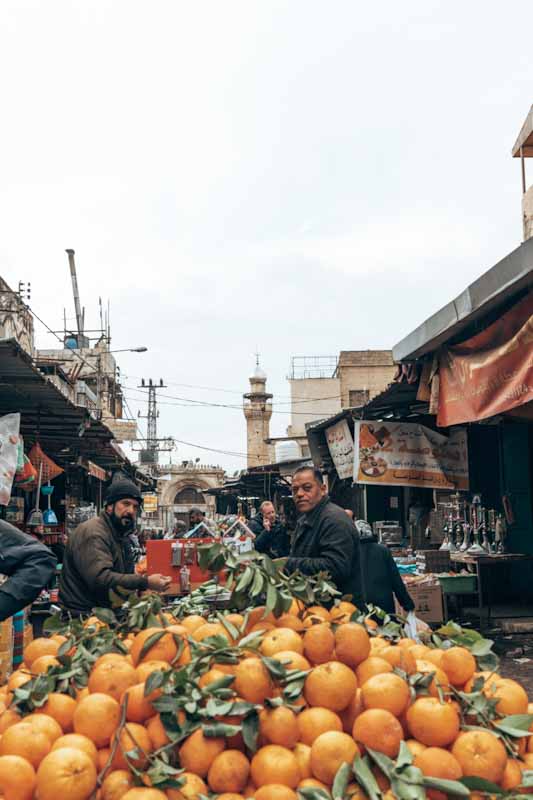
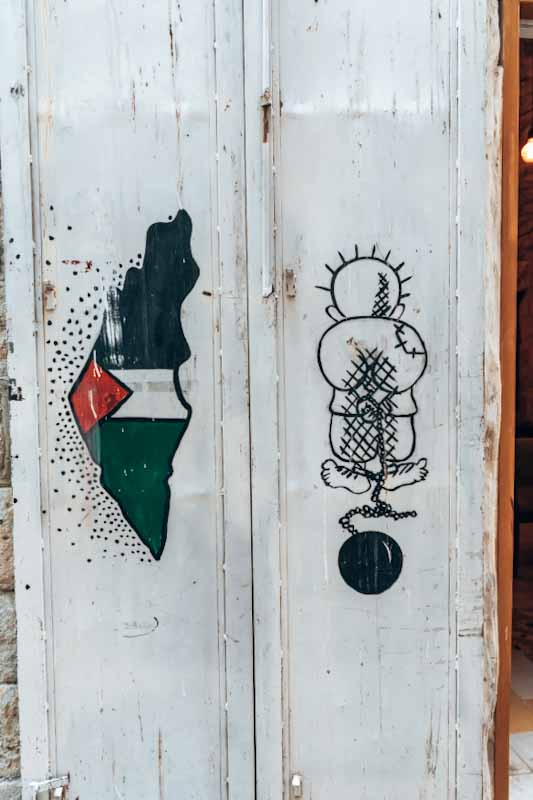
The old city and watch tower
The old city has an authentic vibe, narrow streets and charismatic stone houses. Come to the square with the watch tower, have a coffee from one of the stalls and enjoy the place. It has identical Ottoman Era architecture as we saw when we visited Damascus during our trip to Syria.
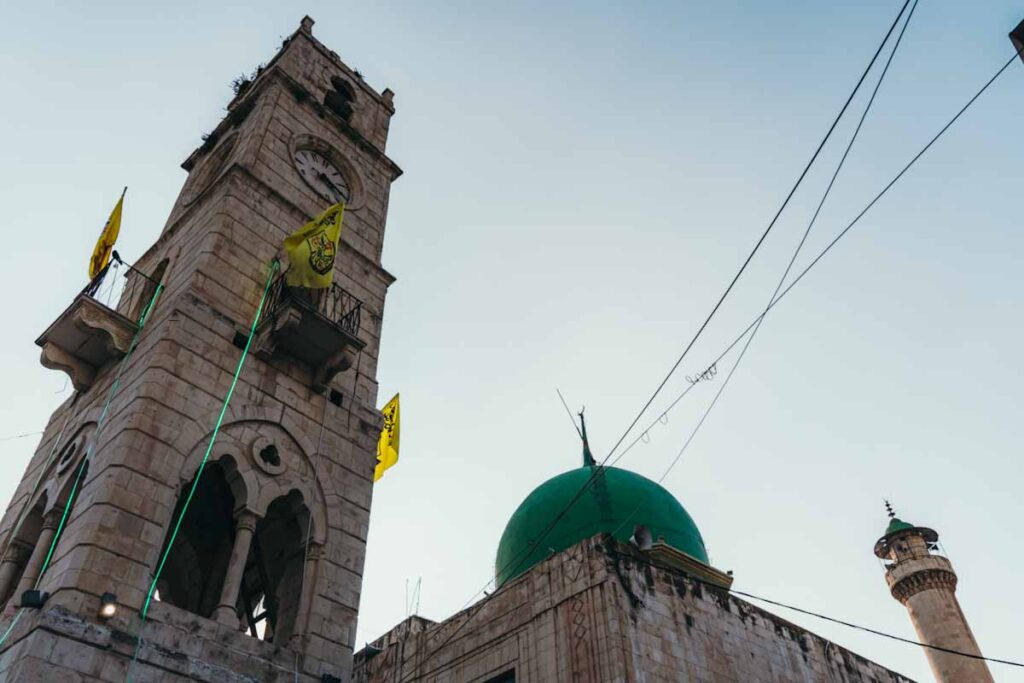
Local food
Try the best Kunafeh in Palestine in Al Aqsa Kunafeh, the famous Kunafeh place in Palestine. Their Kunafeh tastes like heaven, and there is no wonder why this place is bustling with locals every day. You can also see the whole process of making kunafeh which is a cool experience.
The next sweet thing you must try is Tamriyah, a fried pastry filled with semolina pudding that costs only 1 ILS. Zalabye Pumpkin is to die for. It is something like a crepe filled with sweet pumpkin filling and then fried. It costs 7 ILS and is totally delicious. Halva. Oh, halva. We visited two traditional places where they make halva, the owners took us inside, showed us around, and gave us a taste of their delicious halva, and we bought a few boxes to bring back home with us. The food in Nablus is fresh and so good.
You can get local Palestinian food, falafel sandwiches or hummus in many places. We didn’t make a mistake in any of the eateries we visited in the old town.
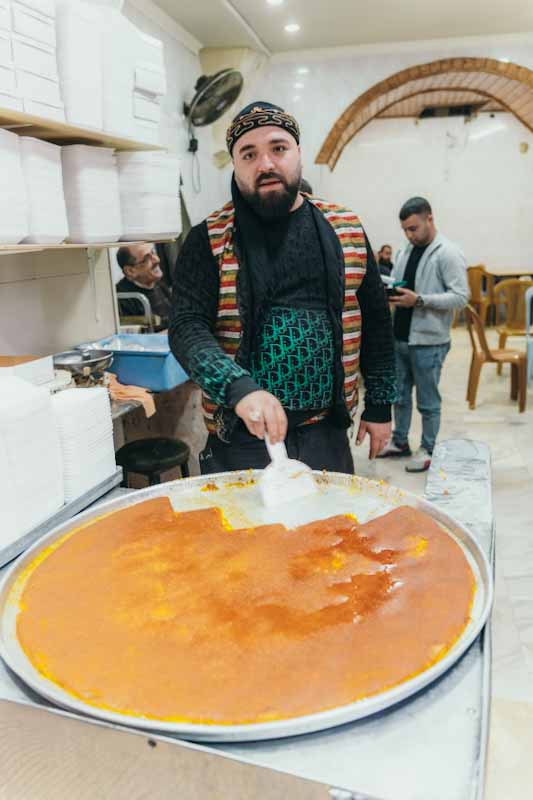
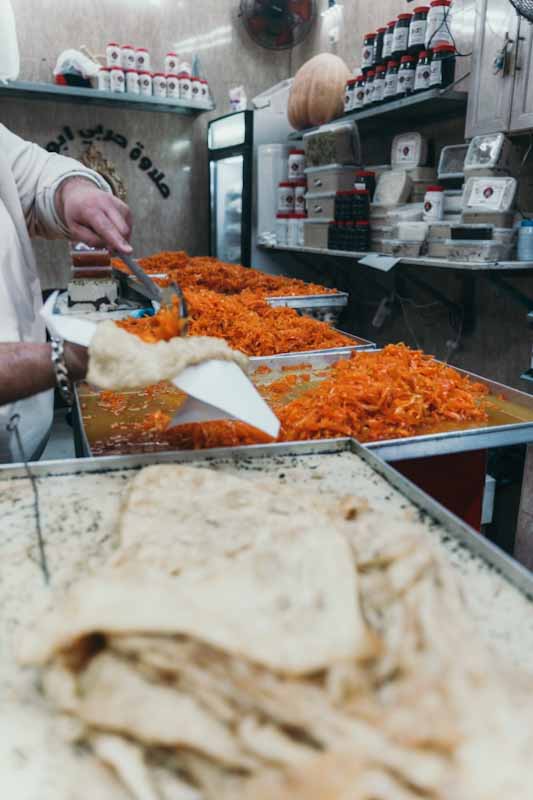
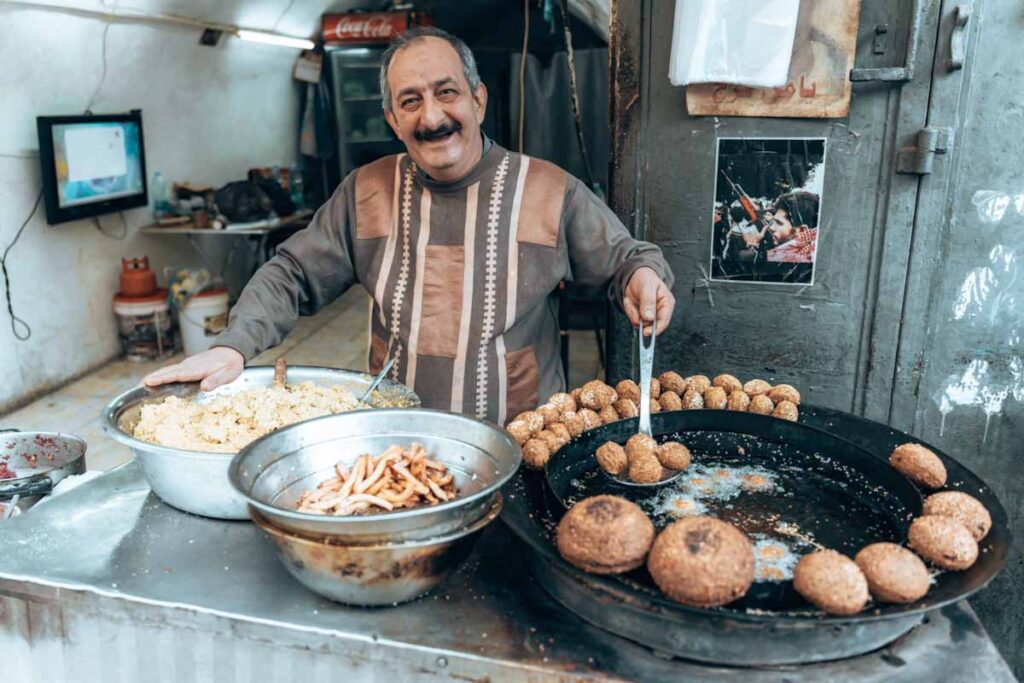
Soap factory
There are numerous soap factories in Nablus. Visit one, check out the colourful soaps and lovely smell and learn about the soap-making process.
As you can guess, Nablus is our favourite city in Palestine, and that’s why we dedicated a whole separate post about Nablus and the best things to do and eat there, but you can also read about the safety situation.
Read more in our post: How to visit Nablus, Palestine, in 2023 & Is it safe? (Coming soon)
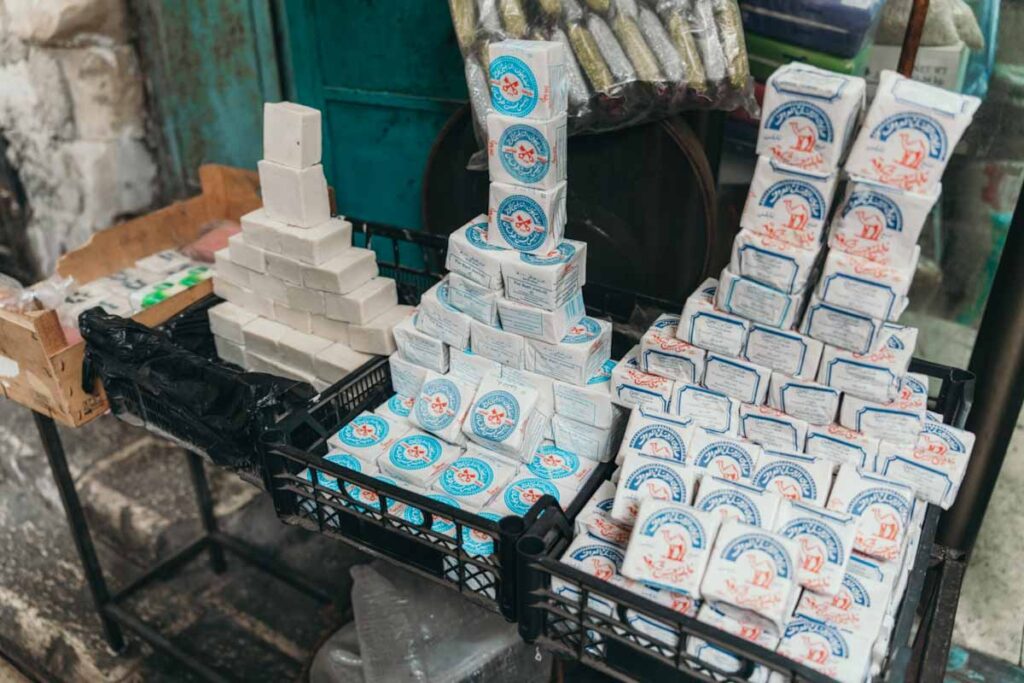
HOW TO GET TO NABLUS FROM RAMALLAH
We asked the local man where the shared taxi have a station, and luckily he took us to the building, where we took a lift and after we saw the place where many share taxis stand. We paid 17 ILS. The location of the multi-floor building from where the shared taxis leave is here.
HOW TO GET AROUND NABLUS
Stay in the centre of Nablus, and you can easily walk everywhere. If you want to go further, take a taxi for 5-10 ILS.
WHERE TO STAY IN NABLUS
Turquoise Guest House I without a doubt, is the best place to stay in Nablus and maybe the whole of Palestine. It is right in the old town, located on the second floor of the stone house. There are some private rooms and also separate dorms for men and women; that’s where we stayed. We met interesting people here, travellers and volunteers who helped at Turquoise Guest House. The owner and family took the time to discuss things about Nablus; they have generally been very helpful. The guest house has an amazing rooftop from where you can see the whole of Nablus. After sunset, it’s a show of lights.
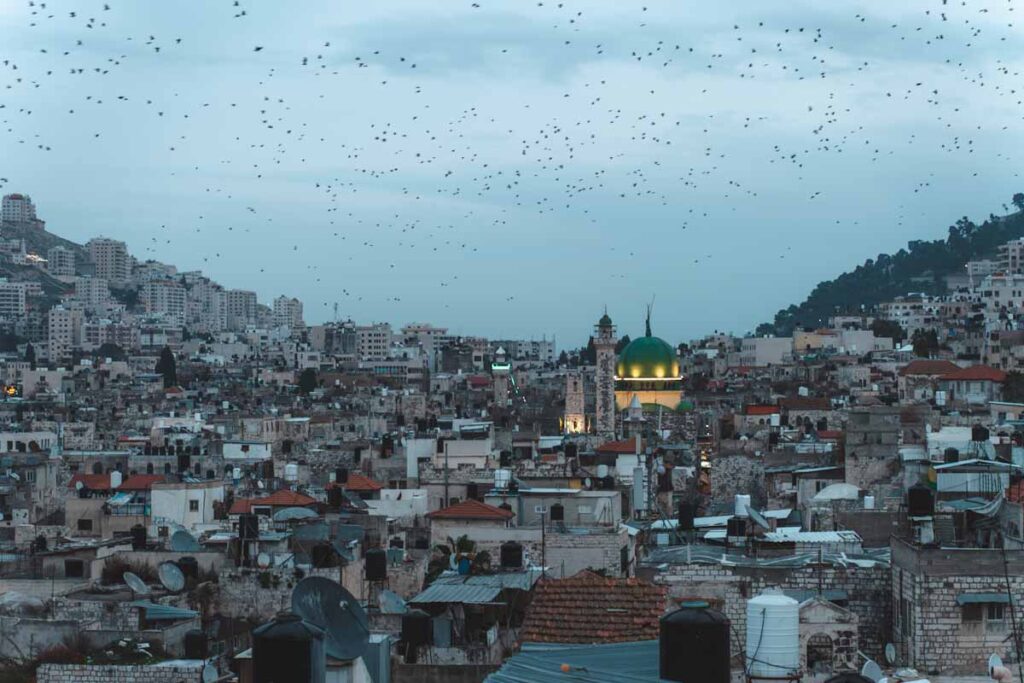
DAY 11: JENIN
Jenin is not your typical holiday destination as it is a place of frequent riots and a place where the Palestinian journalist Abu Akleh was killed when reporting for Al Jazeera. Her face is a symbol of Palestinian activism. You will see graffiti with her face and posters all around Palestine.
When you cross the Emek Harod checkpoint to Nazareth, expect you will be suspicious as only activists and journalists usually go to Jenin. We decided not to spend a night there and only go for a day trip. Jenin is a traditional Palestinian city with similar vibes to Nablus. We felt there very well, safe and welcomed. People stopped us on the street and wanted to practice English.
The market in the centre, together with the one in Nablus, is the best market we visited in Palestine. We wandered around its streets for a couple of hours. We used our time, especially for walking around the centre of Jenin, talking with people, and tasting some food and pomegranate juice. And then, we took a shared taxi towards the border as the plan that day was to make our way to Nazareth, Israel.
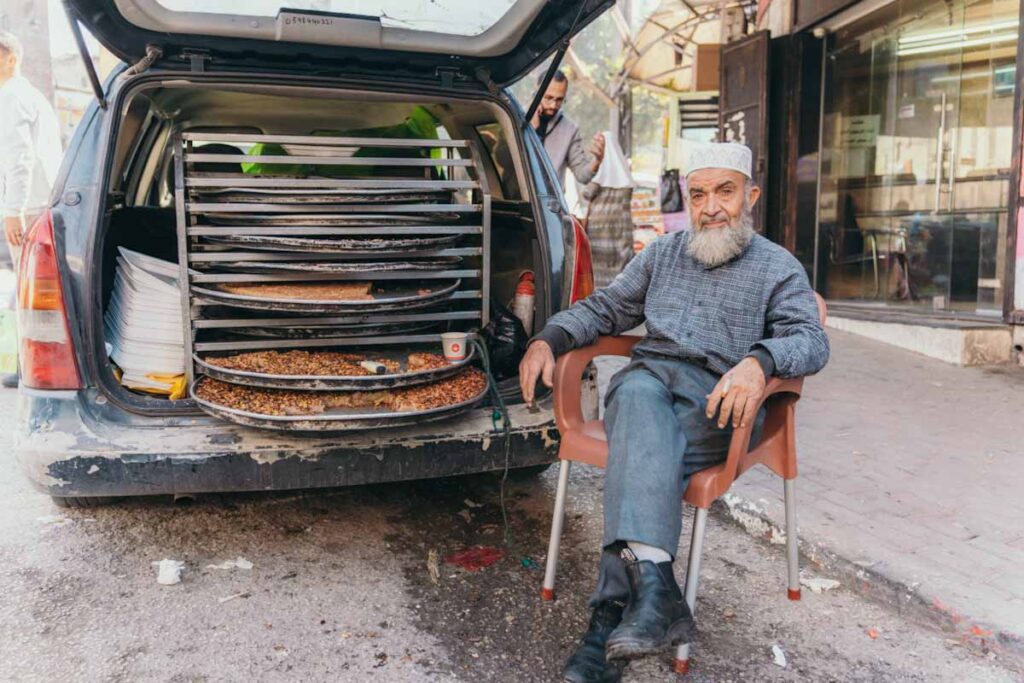
HOW TO GET TO JENIN FROM NABLUS
In Nablus, take a shared taxi to Jenin from this location. It costs 16 ILS.
WHERE TO STAY IN JENIN
Jenin Creative Cultural Center – I got in touch with Yousef through Facebook messages. He runs this place and is a director of an NGO in Jenin. They charge quite a higher price for accommodation, but since there are not many hotel options, this is the place to be. We spent a half day in Jenin on the way to the border, so we didn’t stay overnight.
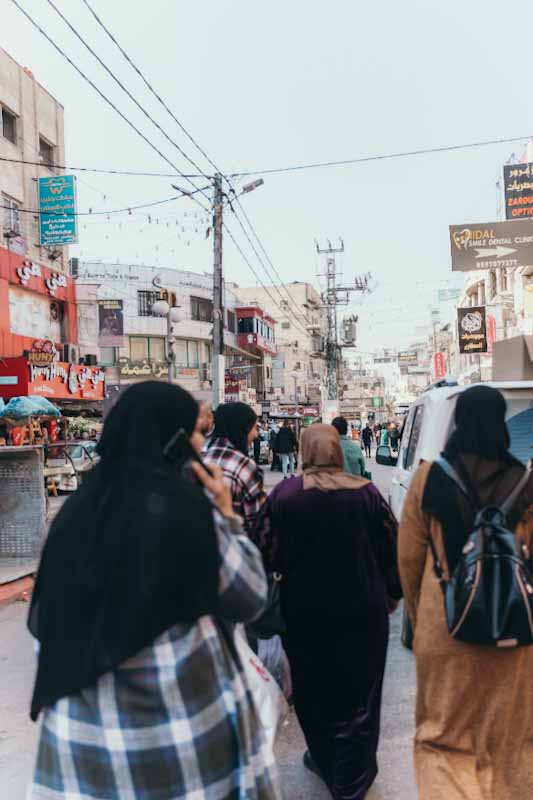
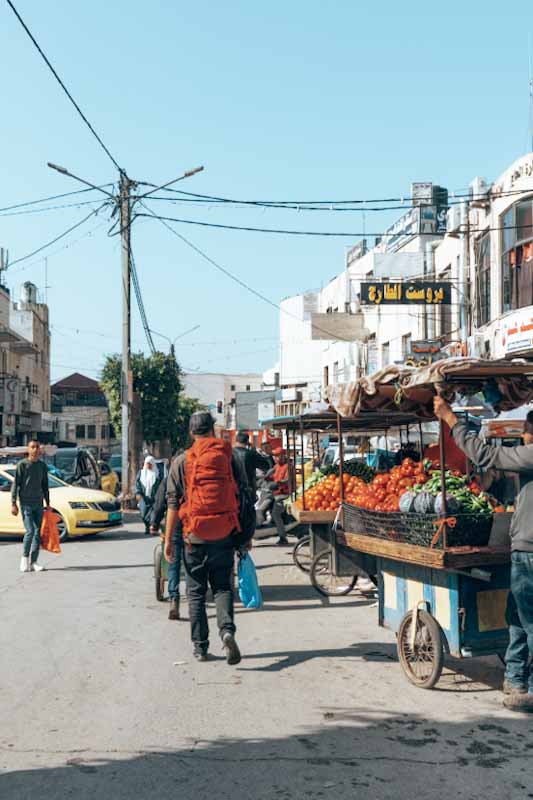
HOW TO GET TO NAZARETH FROM JENIN
Take a shared taxi from Jenin to Jalamah, the city right by the Emek Harod Checkpoint, where you cross to Nazareth in Israel. We asked locals, and they brought us to the shared taxi location. We paid 4 ILS for a ride.
We already described the Emek Harod Checkpoint above in the Checkpoint section.
After you cross the checkpoint, you find yourself back in Israel. Follow people and go outside of the building. Then continue your way to the bus stop by the main road. On google maps, you find the bus stop as Jalamah Checkpoint and wait for the bus to Nazareth. Check the Moovit App to find the bus that is going there. We took bus #52 and then changed to bus #354. More buses are going as well as taxis. It is only 25 km from Nazareth.
Read more: Visiting Israel on budget: Tips & Perfect 5 days itinerary. (Coming soon)
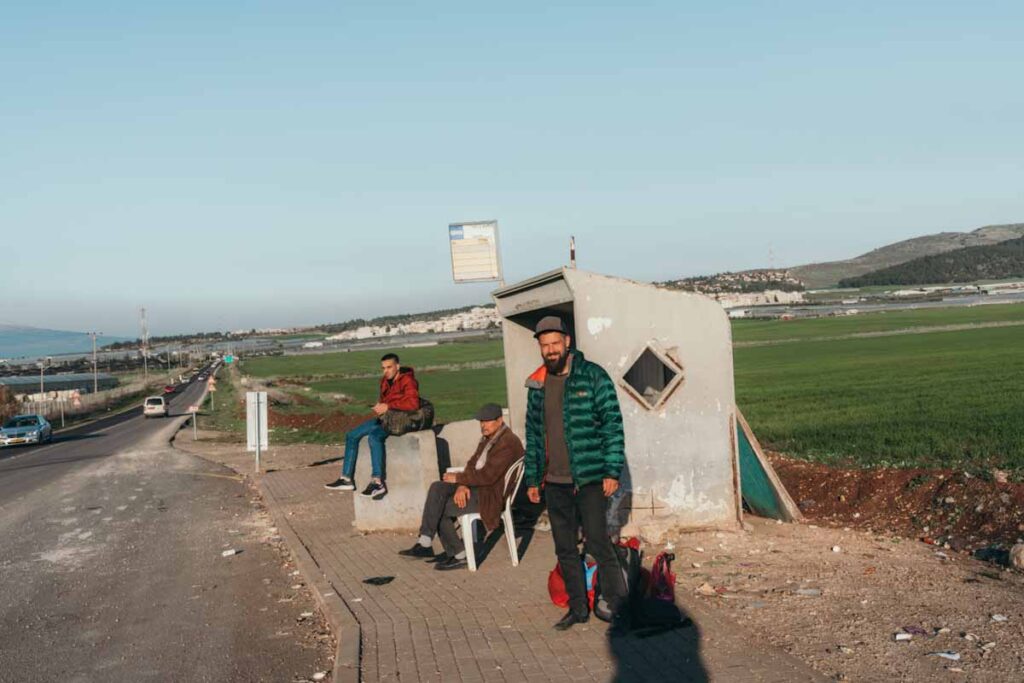
More from the Middle East
PALESTINE / ISRAEL
How to visit Jerusalem in 24 hours: Safety, Tips, Itinerary
Visit & Stay in refugee camps in the West Bank.
Taba Border Crossing: Dahab (Egypt) to Eilat (Israel) with Troubled Stamps in Passport
Lebanon
How to travel to Lebanon & Ultimate 11 days itinerary
The best things to do in Beirut, Lebanon
Is it safe to travel to Lebanon? Our experience
Syria
How to travel to Syria & Is it safe to visit?
Cyprus
How to travel to the Turkish Republic of Northern Cyprus
Travel off the beaten path in Cyprus
jordan
Epic road trip: The King’s Highway in Jordan
Wadi Rum: Overnight in the desert & Know before you go
How to travel to Aqaba, Jordan & Ultimate beach guide
How to visit Petra and Little Petra in Jordan
SAVE IT!
It’s time to plan your trip!
Find our travel resources below that help you plan your next trip. Good luck and safe travels.
Book your flight
Skyscanner is our favourite tool for searching for the cheapest flights and flight combinations. Multi-city or Explore Everywhere helps us to find real bargains.
Rent a car
The best platform to rent a car and compare the prices for your next road trip anywhere in the world is Discovercars.com. The booking process is hassle-free.
Find your acommodation
On Booking.com we always find the best deals for accommodation. Another great option for cheap accommodation is Hostelworld.
Travel insurance
We always recommend IATI Travel Insurance which offers excellent plans. As a reader of Broken Navigation, get an exclusive 5% discount.
For Europeans Truetraveller offers perfect travel insurance for the best price.
Explore more with Tours
Some places are better off explored with a knowledgeable guide. Or, if you simply want to save time and hassle, we recommend GetYourGuide. Another great option that also has an amazing range of activities is Viator.
protect yourself online by VPN
We always use NordVPN everywhere we travel for safe internet browsing and access to specific sites that might be blocked.
Disclosure: We recommend only companies we personally use. If you book services through any of the affiliate links in our posts, it earns us a small commission at no extra cost to you.

